

Download Brochure
Modern classic.
New M-Series X-Type yachts are designed to dial-up our M-Series with enhanced sailing performance. We started with the award-winning quality, distinctive good looks, and innovative engineering that goes into every M-Series we build, then we partnered with Sparkman & Stephens to push the design envelope to ensure maximum sailing performance in all conditions. We added go-fast features like a tall carbon fiber rig from Hall Spars and high-performance 3Di sails from North Sails. A deep high aspect ratio fin keel to provide rock-solid stability and enhanced sail carrying ability. A carbon fiber wheel to deliver finger-tip control. And each slippery fast hull faired to ultra-precise tolerances and covered with drag reducing bottom paint. X-Type models redefine what a luxury performance boat can be.

| LOA | 42' 3" |
| LWL | 30' 0" |
| BEAM | 11' 3" |
| DRAFT | 8' 0" |
| DISPLACEMENT | 16,030 lbs. |
| FUEL CAPACITY | 40 U.S. gallons |
| ENGINE | Yanmar 3JH5E x SD Saildrive unit, 3-cylinder, direct-injected, fresh water-cooled marine diesel engine, maximum 39 HP @ 3000 RPM. |
| CONSTRUCTION | Carbon-Epoxy & Kevlar™ |
Images and media on this page may represent optional equipment or previous specifications. Specifications and equipment are subject to change.
- First Name *
- Last Name *
- Boating Location: Where do you do most of your boating? *
- Boating Country * Afghanistan Albania Algeria American Samoa Andorra Angola Anguilla Antarctica Antigua and Barbuda Argentina Armenia Aruba Australia Austria Azerbaijan Bahamas Bahrain Bangladesh Barbados Belarus Belgium Belize Benin Bermuda Bhutan Bolivia Bonaire, Sint Eustatius and Saba Bosnia and Herzegovina Botswana Bouvet Island Brazil British Indian Ocean Territory Brunei Darussalam Bulgaria Burkina Faso Burundi Cabo Verde Cambodia Cameroon Canada Cayman Islands Central African Republic Chad Chile China Christmas Island Cocos Islands Colombia Comoros Congo Congo, Democratic Republic of the Cook Islands Costa Rica Croatia Cuba Curaçao Cyprus Czechia Côte d'Ivoire Denmark Djibouti Dominica Dominican Republic Ecuador Egypt El Salvador Equatorial Guinea Eritrea Estonia Eswatini Ethiopia Falkland Islands Faroe Islands Fiji Finland France French Guiana French Polynesia French Southern Territories Gabon Gambia Georgia Germany Ghana Gibraltar Greece Greenland Grenada Guadeloupe Guam Guatemala Guernsey Guinea Guinea-Bissau Guyana Haiti Heard Island and McDonald Islands Holy See Honduras Hong Kong Hungary Iceland India Indonesia Iran Iraq Ireland Isle of Man Israel Italy Jamaica Japan Jersey Jordan Kazakhstan Kenya Kiribati Korea, Democratic People's Republic of Korea, Republic of Kuwait Kyrgyzstan Lao People's Democratic Republic Latvia Lebanon Lesotho Liberia Libya Liechtenstein Lithuania Luxembourg Macao Madagascar Malawi Malaysia Maldives Mali Malta Marshall Islands Martinique Mauritania Mauritius Mayotte Mexico Micronesia Moldova Monaco Mongolia Montenegro Montserrat Morocco Mozambique Myanmar Namibia Nauru Nepal Netherlands New Caledonia New Zealand Nicaragua Niger Nigeria Niue Norfolk Island North Macedonia Northern Mariana Islands Norway Oman Pakistan Palau Palestine, State of Panama Papua New Guinea Paraguay Peru Philippines Pitcairn Poland Portugal Puerto Rico Qatar Romania Russian Federation Rwanda Réunion Saint Barthélemy Saint Helena, Ascension and Tristan da Cunha Saint Kitts and Nevis Saint Lucia Saint Martin Saint Pierre and Miquelon Saint Vincent and the Grenadines Samoa San Marino Sao Tome and Principe Saudi Arabia Senegal Serbia Seychelles Sierra Leone Singapore Sint Maarten Slovakia Slovenia Solomon Islands Somalia South Africa South Georgia and the South Sandwich Islands South Sudan Spain Sri Lanka Sudan Suriname Svalbard and Jan Mayen Sweden Switzerland Syria Arab Republic Taiwan Tajikistan Tanzania, the United Republic of Thailand Timor-Leste Togo Tokelau Tonga Trinidad and Tobago Tunisia Turkmenistan Turks and Caicos Islands Tuvalu Türkiye US Minor Outlying Islands Uganda Ukraine United Arab Emirates United Kingdom United States Uruguay Uzbekistan Vanuatu Venezuela Viet Nam Virgin Islands, British Virgin Islands, U.S. Wallis and Futuna Western Sahara Yemen Zambia Zimbabwe Åland Islands Country
- Boating State * Choose a State Outside US / Canada Alabama Alaska Alberta Arizona Arkansas California - North California - South Colorado Connecticut Delaware District Of Columbia Florida - East Coast Florida - West Coast Gulf Coast Georgia Hawaii Idaho Illinois Indiana Iowa Kansas Kentucky Louisiana Maine Manitoba Maryland Massachusetts - North of Boston Massachusetts - Boston and South Michigan Minnesota Mississippi Missouri Montana Nebraska Nevada New Brunswick New Hampshire New Jersey - Manasquan and North New Jersey - South of Manasquan New Mexico New York - Great Lakes New York - Coastal North Carolina North Dakota Nova Scotia Ohio Oklahoma Oregon Pennsylvania - East Pennsylvania - West Puerto Rico Rhode Island Saskatchewan South Carolina South Dakota Tennessee Texas Utah Vermont Virgin Islands Virginia Washington West Virginia Wisconsin Wyoming
- Mailing Address *
- Street Address *
- Country * Afghanistan Albania Algeria American Samoa Andorra Angola Antigua and Barbuda Argentina Armenia Australia Austria Azerbaijan Bahamas Bahrain Bangladesh Barbados Belarus Belgium Belize Benin Bermuda Bhutan Bolivia Bosnia and Herzegovina Botswana Brazil Brunei Bulgaria Burkina Faso Burundi Cambodia Cameroon Canada Cape Verde Cayman Islands Central African Republic Chad Chile China Colombia Comoros Congo, Democratic Republic of the Congo, Republic of the Costa Rica Côte d'Ivoire Croatia Cuba Curaçao Cyprus Czech Republic Denmark Djibouti Dominica Dominican Republic East Timor Ecuador Egypt El Salvador Equatorial Guinea Eritrea Estonia Ethiopia Faroe Islands Fiji Finland France French Polynesia Gabon Gambia Georgia Germany Ghana Greece Greenland Grenada Guam Guatemala Guinea Guinea-Bissau Guyana Haiti Honduras Hong Kong Hungary Iceland India Indonesia Iran Iraq Ireland Israel Italy Jamaica Japan Jordan Kazakhstan Kenya Kiribati North Korea South Korea Kosovo Kuwait Kyrgyzstan Laos Latvia Lebanon Lesotho Liberia Libya Liechtenstein Lithuania Luxembourg Macedonia Madagascar Malawi Malaysia Maldives Mali Malta Marshall Islands Mauritania Mauritius Mexico Micronesia Moldova Monaco Mongolia Montenegro Morocco Mozambique Myanmar Namibia Nauru Nepal Netherlands New Zealand Nicaragua Niger Nigeria Northern Mariana Islands Norway Oman Pakistan Palau Palestine, State of Panama Papua New Guinea Paraguay Peru Philippines Poland Portugal Puerto Rico Qatar Romania Russia Rwanda Saint Kitts and Nevis Saint Lucia Saint Vincent and the Grenadines Samoa San Marino Sao Tome and Principe Saudi Arabia Senegal Serbia Seychelles Sierra Leone Singapore Sint Maarten Slovakia Slovenia Solomon Islands Somalia South Africa Spain Sri Lanka Sudan Sudan, South Suriname Swaziland Sweden Switzerland Syria Taiwan Tajikistan Tanzania Thailand Togo Tonga Trinidad and Tobago Tunisia Turkey Turkmenistan Tuvalu Uganda Ukraine United Arab Emirates United Kingdom United States Uruguay Uzbekistan Vanuatu Vatican City Venezuela Vietnam Virgin Islands, British Virgin Islands, U.S. Yemen Zambia Zimbabwe
- State * Alabama Alaska American Samoa Arizona Arkansas California Colorado Connecticut Delaware District of Columbia Florida Georgia Guam Hawaii Idaho Illinois Indiana Iowa Kansas Kentucky Louisiana Maine Maryland Massachusetts Michigan Minnesota Mississippi Missouri Montana Nebraska Nevada New Hampshire New Jersey New Mexico New York North Carolina North Dakota Northern Mariana Islands Ohio Oklahoma Oregon Pennsylvania Puerto Rico Rhode Island South Carolina South Dakota Tennessee Texas Utah U.S. Virgin Islands Vermont Virginia Washington West Virginia Wisconsin Wyoming Armed Forces Americas Armed Forces Europe Armed Forces Pacific State
- Zip/Postal Code *
- Pre-Owned Powerboats
- Pre-Owned Sailboats
- Email This field is for validation purposes and should be left unchanged.
- Mailing Address Street Address Address Line 2 City State / Province / Region ZIP / Postal Code Afghanistan Albania Algeria American Samoa Andorra Angola Anguilla Antarctica Antigua and Barbuda Argentina Armenia Aruba Australia Austria Azerbaijan Bahamas Bahrain Bangladesh Barbados Belarus Belgium Belize Benin Bermuda Bhutan Bolivia Bonaire, Sint Eustatius and Saba Bosnia and Herzegovina Botswana Bouvet Island Brazil British Indian Ocean Territory Brunei Darussalam Bulgaria Burkina Faso Burundi Cabo Verde Cambodia Cameroon Canada Cayman Islands Central African Republic Chad Chile China Christmas Island Cocos Islands Colombia Comoros Congo Congo, Democratic Republic of the Cook Islands Costa Rica Croatia Cuba Curaçao Cyprus Czechia Côte d'Ivoire Denmark Djibouti Dominica Dominican Republic Ecuador Egypt El Salvador Equatorial Guinea Eritrea Estonia Eswatini Ethiopia Falkland Islands Faroe Islands Fiji Finland France French Guiana French Polynesia French Southern Territories Gabon Gambia Georgia Germany Ghana Gibraltar Greece Greenland Grenada Guadeloupe Guam Guatemala Guernsey Guinea Guinea-Bissau Guyana Haiti Heard Island and McDonald Islands Holy See Honduras Hong Kong Hungary Iceland India Indonesia Iran Iraq Ireland Isle of Man Israel Italy Jamaica Japan Jersey Jordan Kazakhstan Kenya Kiribati Korea, Democratic People's Republic of Korea, Republic of Kuwait Kyrgyzstan Lao People's Democratic Republic Latvia Lebanon Lesotho Liberia Libya Liechtenstein Lithuania Luxembourg Macao Madagascar Malawi Malaysia Maldives Mali Malta Marshall Islands Martinique Mauritania Mauritius Mayotte Mexico Micronesia Moldova Monaco Mongolia Montenegro Montserrat Morocco Mozambique Myanmar Namibia Nauru Nepal Netherlands New Caledonia New Zealand Nicaragua Niger Nigeria Niue Norfolk Island North Macedonia Northern Mariana Islands Norway Oman Pakistan Palau Palestine, State of Panama Papua New Guinea Paraguay Peru Philippines Pitcairn Poland Portugal Puerto Rico Qatar Romania Russian Federation Rwanda Réunion Saint Barthélemy Saint Helena, Ascension and Tristan da Cunha Saint Kitts and Nevis Saint Lucia Saint Martin Saint Pierre and Miquelon Saint Vincent and the Grenadines Samoa San Marino Sao Tome and Principe Saudi Arabia Senegal Serbia Seychelles Sierra Leone Singapore Sint Maarten Slovakia Slovenia Solomon Islands Somalia South Africa South Georgia and the South Sandwich Islands South Sudan Spain Sri Lanka Sudan Suriname Svalbard and Jan Mayen Sweden Switzerland Syria Arab Republic Taiwan Tajikistan Tanzania, the United Republic of Thailand Timor-Leste Togo Tokelau Tonga Trinidad and Tobago Tunisia Turkmenistan Turks and Caicos Islands Tuvalu Türkiye US Minor Outlying Islands Uganda Ukraine United Arab Emirates United Kingdom United States Uruguay Uzbekistan Vanuatu Venezuela Viet Nam Virgin Islands, British Virgin Islands, U.S. Wallis and Futuna Western Sahara Yemen Zambia Zimbabwe Åland Islands Country
- Boating State * Choose a State Outside US / Canada Alabama Alaska Alberta Arizona Arkansas California - North California - South Colorado Connecticut Delaware District Of Columbia Florida - East Coast Florida - West Coast Georgia Hawaii Idaho Illinois Indiana Iowa Kansas Kentucky Louisiana Maine Manitoba Maryland Massachusetts - North of Boston Massachusetts - Boston and South Michigan Minnesota Mississippi Missouri Montana Nebraska Nevada New Brunswick New Hampshire New Jersey - North of Sandy Hook New Jersey - South of Sandy Hook New Mexico New York - Great Lakes New York - Coastal North Carolina North Dakota Nova Scotia Ohio Oklahoma Oregon Pennsylvania - East Pennsylvania - West Puerto Rico Rhode Island Saskatchewan South Carolina South Dakota Tennessee Texas Utah Vermont Virgin Islands Virginia Washington West Virginia Wisconsin Wyoming
- Boating Plans? * Planning to purchase within 18 months Yacht Enthusiast
- Boating State * Outside US / Canada Alabama Alaska Alberta Arizona Arkansas California - North California - South Colorado Connecticut Delaware District Of Columbia Florida - East Coast Florida - West Coast Gulf Coast Georgia Hawaii Idaho Illinois Indiana Iowa Kansas Kentucky Louisiana Maine Manitoba Maryland Massachusetts - North of Boston Massachusetts - Boston and South Michigan Minnesota Mississippi Missouri Montana Nebraska Nevada New Brunswick New Hampshire New Jersey - North of Sandy Hook New Jersey - South of Sandy Hook New Mexico New York - Great Lakes New York - Coastal North Carolina North Dakota Nova Scotia Ohio Oklahoma Oregon Pennsylvania - East Pennsylvania - West Puerto Rico Rhode Island Saskatchewan South Carolina South Dakota Tennessee Texas Utah Vermont Virgin Islands Virginia Washington West Virginia Wisconsin Wyoming

Matthew’s Substack

Bayesian, the mega sailing yacht that sank last week by Sicily, was a disaster waiting to happen. Here's why.

Modern high-tech composite materials and rigging allow super-high single-masted sloops that were impossible to build in the old schooner era. An advantage of the old schooners was that with their sails down, there was much less windage far aloft. For a modern giant super-sloop, the windage aloft, even at anchor, is tremendous. All of those spreaders plus the mast surface area present a massive amount of windage when subjected to a blast of wind. The enormous height causes vastly more leverage than the same wind striking a "low aspect ratio" sailing rig. At anchor, deck hatches would be open. If the boat is heeled over far enough to put open side deck hatches underwater, down-flooding and sinking would happen in a matter of a minute or two.
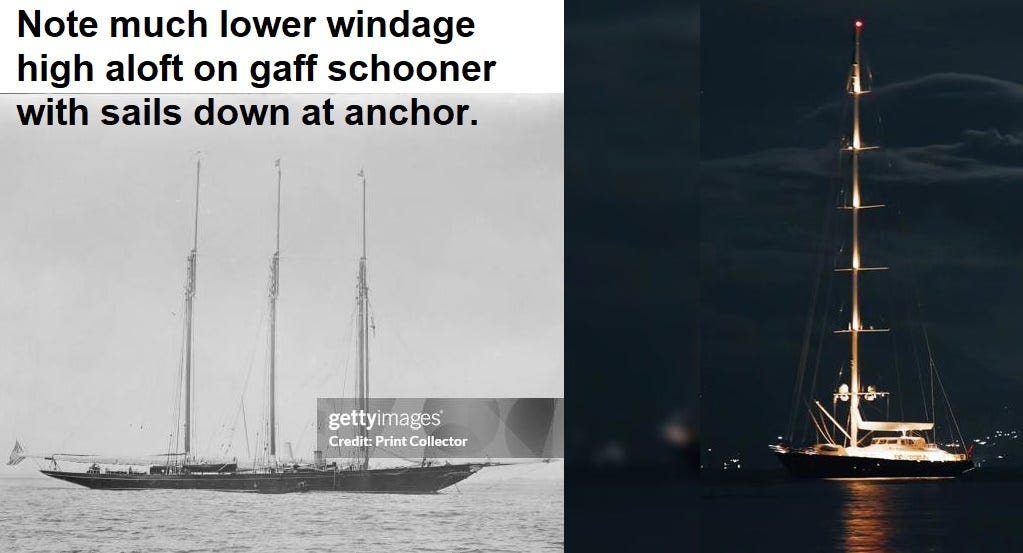
To have a safe righting moment even after being knocked down with her mast horizontal and in the water, Bayesian would have needed a ballast keel 40 or so feet deep. This is not practical, so mega sailboats rely on inertia and mass to not get knocked all the way down. If they are knocked down, they are basically doomed if any hatches are open. There is no ballast keel sufficient to lever them back upright.
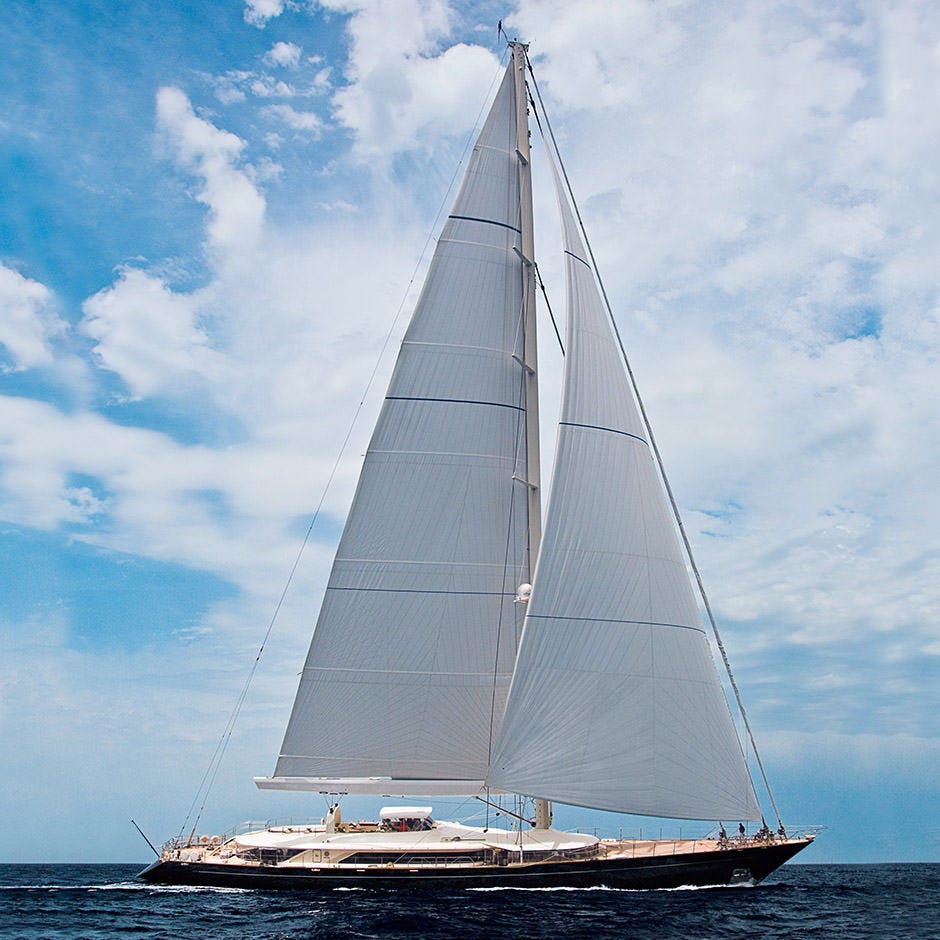
Bayesian had HUGE windage, and very high up. Even with her sails down and roller jibs furled, the 237' tall mast is (estimating from photos) almost five feet front to back, and she had 6 sets of "spreaders" that are almost the size of a Cessna's wings. Once she's heeled 45* by the sudden wind blast catching her on her beam, she didn't shed the wind, she caught even more on her spreaders. Her roller furling jibs are also massive, about a yard in diameter even when furled.
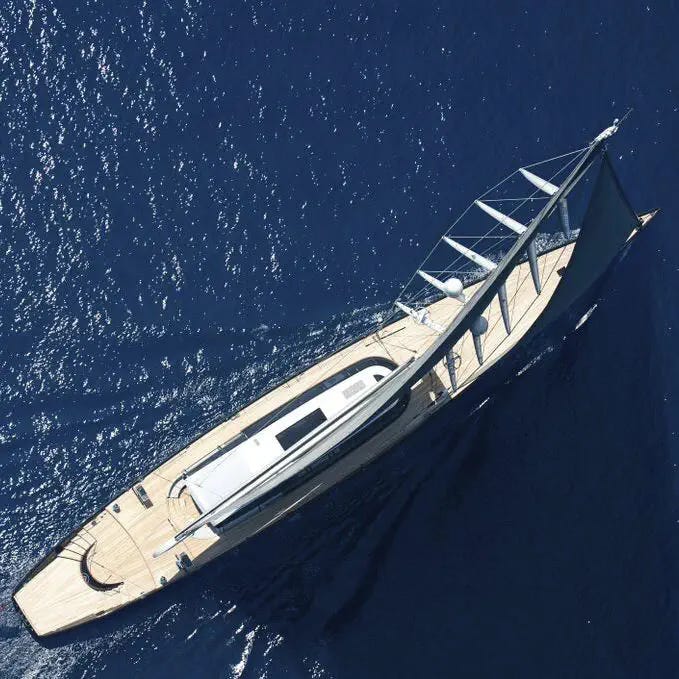
A sloop is the most efficient sailing rig in terms of potential lift to drag. 2 sails, one mast. But that enormous mast is always way, way up there. An old gaff schooner at anchor would present much less windage. But any giant sailing ship relying on mass and inertia to avoid being knocked down was and is always at risk. Another "safety factor" present in older sailing ships was that their organic-fiber sails and ropes would tend to "blow out" when struck by a wind blast, instead of taking the ship all the way over. Even being dismasted was preferable to being knocked down and sunk. With today's modern sails and rigging, the sails won't fail, and the sailing ship will be driven over on her beam end.
White Squall 1996 Trailer | Jeff Bridges This is a movie recounting when a sailing ship was knocked down by a "white squall" and sank in minutes with the loss of life.
This also happened to the 90' Pride of Baltimore #1, in 1986 under full sail on the Atlantic.
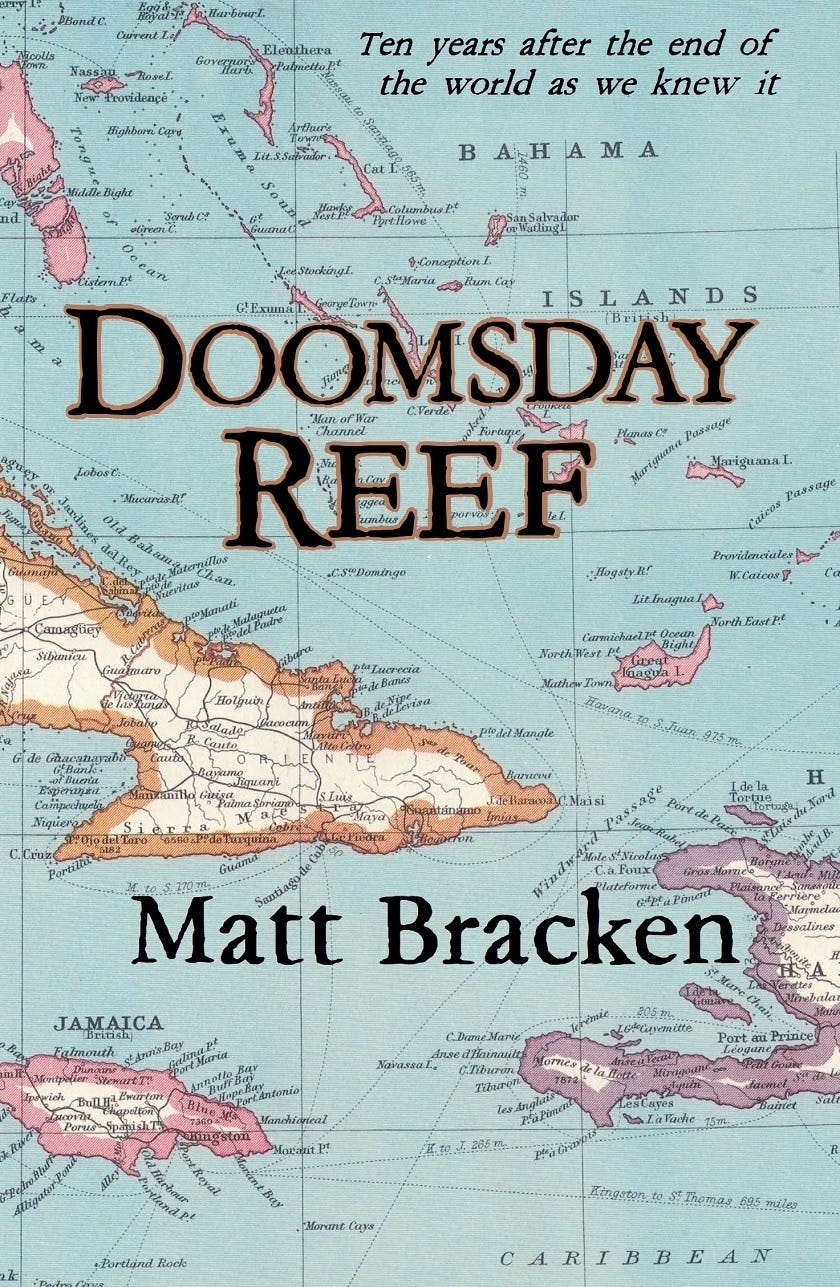
A schooner being knocked down in a storm also occurs in my new novel, Doomsday Reef. https://www.amazon.com/Doomsday-Reef-Matthew-Bracken/dp/0
| Liked by Matt Bracken
|
|
|
Ready for more?
Practical Boat Owner
- Digital edition

Sail boat rigs: the pros and cons of each popular design
- Peter Poland
- July 24, 2023
Peter Poland looks at the history of popular rig designs and how the different types affect boat performance

Annie Hill’s FanShi can be easily reefed, a real benefit of the junk rig when sailing solo. Credit: Annie Hill Credit: Annie Hill
Having once asked yacht designer Andrew Wolstenholme if we could meet to discuss the evolution of modern sail boat rigs – and the continuing popularity of some older designs – we talked about boats in general and gaff rigs in particular, many of which he designs.
“The gaff still has much to recommend it. With stiffer, yet lighter carbon fibre spars , it can offer bigger benefits than it ever did in the past,” said Andrew.
His recent gaff-rigged designs like the new Cornish Crabber 24 MkV and smaller Kite 21 prove this point.

The 45ft barge yacht Juno was designed by Andrew Wolstenholme, built by Charlie Ward and launched in 2000. If you fancy a taste of history she can be chartered through www.sailingbargejuno.com . Credit: Neil Foster
It’s generally accepted that the gaff evolved from the spritsail rig , which in turn evolved from earlier lugsail and – before then – square sail rigs .
The lugsail attaches to a spar that is hoisted at an angle. So part of the spar and sail protrude ahead of the mast, and this leading edge enables a boat to sail upwind.
The evolution of the lugsail started when someone discovered that by setting a square sail at an angle – with one end of the yard pointing down towards the deck – the sail could set closer to the wind.
Upwind advantage
Some say the Chinese junk rig is also descended from square sails as used on Chinese ships before the 12th century.
The junk rig , also known as the Chinese lugsail or sampan rig, evolved with full length battens extending the sail forward of the mast, providing a leading edge to help sail upwind.
The ever-inventive Blondie Hasler designed and built a modern version of the junk rig for his modified Nordic Folkboat, Jester .
He then entered the first single-handed transatlantic race in 1960, helping to initiate the OSTAR and boosting the appeal of long-distance solo sailing in general, and the junk rig in particular.

Blondie Hasler’s Jester helped cement the appeal of the modern junk rig. Credit: Ewen Southby-Tailyour
David Tyler, Annie Hill and Roger Taylor are three leading lights of the Hasler-inspired move to modern junk rigs, and have sailed many thousands of miles between them.
A Sadler 25 was the first of five junk rig boats that David Tyler owned. He and Annie Hill were also founder members of the ever-informative Junk Rig Association .
David told me he “could not contemplate sailing under anything else than a junk rig”, and has a long history of experimenting with and making variations of the junk rig.
David Thomas designed a ply/epoxy 35ft shoal draught junk rig ocean cruiser for David Tyler.

Tystie with an earlier single mast sail plan. She later converted to a ketch rig . Credit: Darren Bos
Hedley Bewes built Tystie beside the Hamble to a completed and painted woodwork stage; then Tyler fitted her out with junk rig, engine , electrics , and deck hardware in just three months.
She was launched in August 2000 and ended up in New Zealand, where she was sold – 16 years later – having sailed 85,000 miles.
“I could not possibly have done this under any other rig,” said David.
He then designed a modern cambered junk rig for his Hunter Duette 23, admitting that this “still does not compete with a big genoa to windward but is superior in all other ways – especially if you define efficiency as ‘miles sailed per unit of input of crew effort’. She had a junk rig of my own design first, then a junk rig-based wingsail.”
David concluded that a modern cambered junk rig “can encompass many features: including various sailmaking ways of building 3D camber into each panel with straight battens; or a flat sail with hinged battens; or a flat fanned sail with twist (a fiendishly cunning method found in Hong Kong junks). My favourite sail has slightly cambered panels with hinged battens. This is easier to set without diagonal creases than deeply cambered panels; and has a smoother curved foil shape than a flat sail with hinges.”
Sail boat rigs proven offshore
Annie Hill is another junk rig enthusiast who has sailed many thousands of miles and written books about her voyages.
She’s now based in New Zealand, having built the David Tyler-designed FanShi “from scratch with a small amount of amateur assistance from friends.”
“The best aspect of a junk rig for single-handed sailing is the speed and ease with which you can reef ,” explained Annie. “The sail tacks automatically which helps in close quarters sailing, as does having exactly the right amount of sail for the situation. I find another great advantage is that when I’m sailing off the anchor or a mooring , I can raise three or four panels, so the boat doesn’t go charging off as I walk back to the cockpit. I can then raise the rest of the sail while leaving the anchorage. And of course, I only raise just what I need.”

Annie Hill christens her self-built FanShi on launch day in New Zealand. Credit: Annie Hill
Annie Hill mentions several junk rig benefits: “The junk rig is much easier to handle downwind. It’s reluctant to gybe until you are sailing well by the lee. The sail is fully squared out so that it is working efficiently. And it’s easy to change from running to reaching to beating, without having to handle guys, poles or vangs.
“In short, the junk rig is much easier to sail. The junk sail is intrinsically self-tacking, which makes beating to windward, especially in close quarters, infinitely less work. Ease of reefing – and making sail again – also means you always sail under the correct amount of canvas. This makes for faster passages and ensures the boat is properly underway in the aftermath of a gale.”
And the disadvantages? Most agree that the junk rig is less efficient when s ailing to windward in light airs .
Easy handling
Roger Taylor came upon the junk rig when buying his first Mingming ; one of around 25 factory-built junk rig Corribees.
“The conversion work was to make her more suitable for serious offshore work – unsinkable, watertight bulkheads, reduced cockpit, proper watertight hatch and so on. I bought her specifically to sail in the first Jester Challenge , and so nothing was more appropriate than a junk rig! I had, in any case, been fascinated by Jester herself for many decades.”
Mingming II came next – a standard triple keel Achilles 24 – so Roger replaced her Bermuda rig with a new junk rig.

Roger Taylor has covered many solo miles in his modified Achilles 24, Mingming II and says the junk sail is easy to repair at sea. Credit: Bertie Milne
“The main differences to the Hasler sail on Mingming were higher aspect ratio for speed in the light airs you get in the high Arctic latitudes in summer – so seven panels instead of six. And cambered panels instead of flat-cut, for better windward performance.
“The lower four panels were built separately as I didn’t have enough room in my London flat to sew the sail in one piece. It’s attached to the carbon-fibre battens with a hinge system. I named the sail the HHT – Hybrid Hinged Turbo! The unstayed mast was a cut down municipal lamp post, 8in diameter at the base, tapering to about 3in at the masthead; solid as a rock in all weathers.”
Roger added “I can reef instantaneously from the hatch and do all other sail handling from the safety and shelter of the main hatch. So I am never exposed on deck and am therefore warmer, drier, less stressed, and therefore more likely to make better decisions.”
As well as ease of handling, Roger says it is “a wonderfully relaxed and supple rig, with none of the extreme tensions of its Bermuda cousin.”
“The sensation at sea is quite different; you feel more in harmony with the elements, rather than their adversary. Few junk rig sailors I know would ever revert once they have experienced this. The rig is easy to repair at sea. If a sail panel tears you can take it out of service by lashing two battens together. If a batten breaks you can lash it to its neighbour (I did almost a whole voyage to Iceland and back like this, after breaking a batten in a Force 9 off the Dogger Bank) or fix it with a splint. With a fully battened rig, the sail is evenly supported at all points.”
A classic sail boat rig
Moving on to modern luggers , there are some recent interpretations of this classic rig.
British designer Nigel Irens is famous for his multihulls but also has an eye for the unusual, and in 1994 he came up with a couple of beautiful luggers.
His first was the Roxane , a 29ft yawl-rigged lugger loosely inspired by an old Shetland Island fishing boat.
Fitted with a carbon fibre main mast and yard, she has plenty of modern technology on board.

As an active racing class boat that doubles up as a tender and potterer, the 11ft 4in lug sail scow has many fans. Credit: Will Perritt/Alamy
He followed this with the smaller 22ft Romilly , another yawl-rigged lugger for trailer sailing . Both models were later produced by CoCoBe in Holland.
The songwriter and broadcaster Sir Richard Stilgoe was “immediately beguiled” by the Roxane after sailing her in 1995, and has his own called Ruby II .
“The lightness of the carbon spars undoubtedly makes a difference to stability. The rig works and sails really nicely. But I admit that I and another owner are working with Nigel to investigate a conversion to two Bermuda masts – still unstayed – with fathead sails. I don’t expect to go faster, but I do hope to be able to raise and lower the sails more quickly and easily,” said Sir Richard.
If you fancy trying a very small lugsail boat, the famous 11ft 4in scow has much to offer.
It’s widely sailed in the UK and the best-known example is the Lymington Scow. Fleets can be found along the South Coast.
Originally built in clinker, scows are now moulded in GRP.
Rooted in the past
The spritsail is another rig evolution. It appeared on small Greek craft in the Aegean Sea many centuries ago. The Romans followed suit with spritsail-rigged merchant ships.
The rig became increasingly sophisticated until the luff of the sail sat behind the mast, while the sprit went from the base of the mast to the peak of the sail.
The luff became long and straight and the boat could sail closer to the wind, especially with leeboards to reduce sideways drift and a foresail to increase sail area: both said to be Dutch innovations.
The most famous spritsail rigged workhorses were the large, flat-bottomed leeboard Thames barges, which could lower their masts to ‘shoot’ bridges before unloading their cargo.

The Optimist was designed as low cost started boats to children. Credit: Getty
There aren’t many new spritsail-rigged craft around these days, apart from thousands of Optimist dinghies sailed by children as starter-boats.
The Optimist was designed in 1947 by American Clark Mills to offer low-cost sailing for young people.
He drew a simple pram that could be built from three sheets of plywood, then the design was slightly modified and introduced in Europe by Axel Damsgaard.
There are now more than 160,000 Optimists sailed in around 120 countries.
At the 2020 Olympics, at least 75% of medallist skippers were former Optimist champions: the spritsail remains a cornerstone of sailing.
Working boat designs
The gaff rig – extensively used on workboats of all sorts – was a logical progression.
The sprit was replaced by a gaff that slid up the mast so two sides of the mainsail were attached to solid spars.
The later addition of a boom improved performance, but made lowering and raising the rig trickier when shooting bridges.
Some builders solved this problem by attaching the boom gooseneck to the top of a tall tabernacle in which the mast hinged, so the lowered mast, gaff and sail could still stack on top of the boom.
Continues below…

Keel types and how they affect performance
Peter Poland looks at the history of keel design and how the different types affect performance

Boat hull design: how it impacts performance
Peter Poland explains how boat hull design has evolved over the years and how it affects boat handling and accommodation

Rigging setup: Turning round a yacht’s performance
Little old boats can offer enormous fun for your money, but they often require some tweaking in order to be…

Winning ways with a junk rig
David Harding looks at some of the latest developments in junk rig and meets the owners of different types of…
The gaff rig improved the versatility of workboats; the ability to sail to windward diluted sailors’ dread of a lee shore.
The gaff rig held sway on small to medium sized working craft and on growing numbers of leisure yachts until the Bermuda rig arrived.
Originally developed in Bermuda for smaller vessels then adapted to the larger ocean-going Bermuda sloop, this rig features a triangular mainsail hoisted to the top of the mast. Marconi’s invention of wire rigging to hold up tall radio masts soon spread to sailboats.
Performance-oriented designers borrowed Marconi’s idea and hoisted large three-sided mainsails on tall and well-supported masts.
As a result, the mainsail had a long, straight leading edge which optimised windward performance.
Crafted for speed
Predictably, yacht racing encouraged the proliferation of these ‘Marconi’ Bermuda rigs.
Metre boat and ocean racer designers were quick to forsake gaffs and go for large mainsails and smallish headsails set on tall masts.
When the Royal Ocean Racing Club (RORC)’s rules started influencing the post-war racing scene, masthead Bermuda rigs with smaller mainsails and larger overlapping genoas received favourable racing handicaps and therefore became the norm; masthead rigs with 150% overlapping genoas dominated the scene.
Fortuitously, self-tailing winches were invented (1974 patent) and fitted on race boats. And GRP production family cruisers followed suit.

The Westerly Centaur with a masthead rig and overlapping genoa
From top-selling Beneteaus like the First 30 (1977) to cruising twin keelers like the Westerly Centaur (1969), masthead rigs and overlapping genoas became the norm.
At the same time, the shorter mast, smaller main and standard working jib saved the builder money – and a large genoa went onto the ‘extras’ list!
The Hunter 19 was an example of how the RORC rule encouraged small mains and big genoas.
The National Squib keelboat’s identical hull and keel sports a well-balanced fractional rig with a small jib and a big mainsail.
But when the Squib grew a cabin and coachroof to become a handicap race boat, the rig height and mainsail shrunk while the headsail became a 150% genoa.
And early Hunter 19s won handicap races galore.
Meanwhile, classic 1960s and 70s cruiser-racers such as the Nicholson 32 , Contessa 26 and 32, Twister, Stella, Beneteaus and Jeanneaus et al clung to masthead rigs with small mainsails, working jibs and large genoas; the latter still lurking on the extras list.
The same applied to most of the British bilge- and twin-keel family cruisers .
Fractional sail boat rigs
Impressed by David Thomas’s quarter ton design, Quarto , Hunter was one of the first British builders to beat a path back to fractional rigged cruiser-racers .
Unlike most other quarter tonners at that time, Quarto featured a fractional rig.
In 1975, Hunter asked Thomas to design a GRP cruiser-racer with a similar rig. This became the Sonata, and Hunter never again built a masthead-rigged yacht.
At around the same time, the new International Offshore Rule (IOR) handicap rule – followed later by the Channel Handicap System (CHS) and International Rating Certificate (IRC) rules – treated fractional sail boat rigs more fairly.

Hunter twin keelers, like the Hunter Channel 31, have fractional rigs. Photo: Sven Petersen/Hunter Association
Hunter’s twin keel cruisers also had easily handled fractional rigs, later including self-tacking jibs as standard.
As most sailors moved over to Bermuda rigs, working boats such as fishing smacks and pilot cutters stuck to their four-sided mainsails held aloft on gaffs.
As did several leisure yachts. Why? What are the advantages of these ‘four sided’ mainsails?
While gaff-rig aficionados concede that it’s less close-winded than a Bermuda rig, they reckon it scores off the wind.
Although a gaffer’s mast is shorter, ample sail can be set because the gaff puts more area at the top of a mainsail than you get beneath the diminutive headboard on a Bermuda rig mainsail.
On a reach or a run, gaff rigs provide power aplenty.
Design expert CA Marchaj also said a low aspect ratio mainsail is more efficient than a high aspect ratio equivalent when sailing off the wind.; if you want to pile on more horsepower in light airs, the space above the gaff can also be filled with a topsail.
Ideal for novices
In the 21st century, modern gaffers are still popular, and thousands of novices enjoy sailing in a ubiquitous and simple little gaffer: the Mirror dinghy .
The Mirror’s gunter-rigged gaff slides up parallel to its short mast and offers many benefits.

Sail boat rigs: The Mirror Dinghy originally had a gunter-rigged gaff rig; later the Mirror Class introduced a Bermuda rig option. Credit: Getty
The mast and gaff are much shorter than a one-piece Bermuda rig mast, so are easy to handle and transport when the boat is trailed.
Yet windward performance is good, thanks to the straight luff that continues from the tack of the mainsail to its head on the ‘gunter’ gaff.
The Mirror Class later introduced a Bermuda rig option.
Modern gaffers
Designer Andrew Wolstenholme attributes much of the credit for the popularity of the gaff rig in cruising yachts to Cornish Crabbers.
These boats have sold in large numbers since Roger Dongray designed the original Cornish Crabber.
Her smaller sister, the 19ft Cornish Shrimper, sports a nicely balanced gaff rig with a sizable roller genoa tacked to a bowsprit.
Over 1,000 have been sold and she’s still in production. Wolstenholme has recently designed a new Cornish Crabber 24 MkV with a lightweight carbon mast which also simplifies trailer-sailing.

Sail boat rigs: The gaff-rigged Cornish Crabber 24, with a lightweight carbon mast. Credit: David Harding
Wolstenholme’s Kite 21 is another modern gaffer to take advantage of new materials.
“My aim is to keep her light and simple… the sail plan is generous and set on lightweight carbon spars. I want her to sail well in light and moderate winds – not just in a blow. I want to tow her behind a normal 1.8 litre saloon – not some gas guzzling 4×4.”
The Old Gaffers Association aims to encourage interest in the traditional gaff rig, but also welcomes the development of the rig.
One of these exotic ‘new’ gaffers is the Simon Rogers-designed Alice III. Chris Spencer-Chapman, whose company McKillop Classic Sails was involved in the rig and sail plan, says the “combination of the light carbon spars and hydraulic lifting deep fin and bulb keel allows an enormous sail area which would not be possible with a conventional hull and spars. She is exciting in light conditions but the windage can be an issue to windward in heavy conditions. “Off the wind she is always very fast… for easy cruising, the Bermuda rig will win, but there will always be the aficionado who likes the features of traditional rigs. Unless you are a real purist, why not take advantage of modern materials?”

Sail boat rigs: The Kite 21 is a modern gaffer designed to sail well in light and moderate winds. Credit: Peter Chesworth
Stephen Akester, who co-owns Alice III , told me she “is light displacement at 7.5 tonnes. In light airs and no sea she outperforms Bermuda rigs but to windward in a blow she loses out due to windage and not being as close winded. [She has] much less weight aloft and a very different motion to a classic gaff-rigged heavy displacement vessel. We opted for a gaff rig for the fun of it. Further refinements using modern materials mean we can set the rig up for single-handed sailing with headsails and topsail on rollers and boom bags to catch main and mizzen.”
The Nigel Irens-designed 63ft Maggie B was another dramatic ‘modern gaffer’.
Builder Covey Island Boatworks called her a ‘fusion’ yacht because she fused modern materials with traditional ideas.
Her schooner rig featured short, high peaked carbon gaffs on Irens’s slippery and almost plumb stemmed shoal draught hull design.
The carbon spars are held up by Vectran fibre shrouds tensioned by special deadeyes.
Reducing weight
Vectran costs more than wire, but the weight reduction is huge – as is the cost saving on fabrications to attach wires to the mast and on rigging screws to tension them.
The weight saving aloft meant that 600kg worth of ballast was saved down below, improving performance and righting moments.
Maggie B was succeeded by Farfarer – another Irens masterpiece featuring an unstayed rig with ‘fathead’ mainsails, with a stiff top batten doing the job of a mini gaff.
Matt Newlands of Swallow Boats also brought gaffs into the modern age; then went further.
“The gunter rig was what we offered, and still do, to customers who prefer having shorter spars making trailer-sailing easier for two reasons – less length to trail and easier to raise the mast. But in my opinion, it has been made almost obsolete by two developments. One is carbon fibre masts, and the other is fathead mainsails.

The mast on the BayRaider 20 is only 1m longer than the boat; the ‘fathead’ mainsail improves the lift and drag ratio and maintains sail area. Credit: David Harding
“Carbon masts on trailer-sailer sized boats are so light that it’s easy to raise a full-length mast if the base is hinged. The mast length problem is cured by using a ‘fathead’ mainsail, reducing mast length (on our boats by as much as 1m) while maintaining the same sail area and improving lift/drag ratio.
“On our popular BayRaider 20 this results in a mast that is only 1m longer than the boat. This new rig has many advantages over the gunter, chief among them being ease of reefing. I love quirky rigs, but it’s hard to beat the Bermuda mainsail setup especially with a fathead main on a carbon mast.”
All of which brings us to the Bermuda rigs on today’s production cruisers.
Many have moved on from the old RORC-inspired masthead sail plan. I asked rigging expert Nigel Theadon whether he preferred masthead or fractional sail boat rigs.
“Modern swept-back spreaders provide a ‘safer’ rig without the need for babystay or forward lowers to stabilise the mast’s middle sections… forestays are now higher up the mast than in years gone by, so the modern fractional rig is closer to a masthead than it once was,” he says.
“Fractional rigs are more attractive to look at and do not need expensive and powerful backstay adjusters. When buying a new boat, consider what you want from the rig. When buying a used boat, get a rigger to carry out a mast inspection: because hull surveyors rarely look above eye height.”
Whether you opt for a gaff- or Bermuda-rigged boat, this is sound advice.
Nigel was class champion of the X332; its well-balanced ultra-modern fractional rig works as well for a small cruising crew as it does for keen racers.
But don’t let this put you off a modern gaffer if you enjoy its quirks and character.
Our coastline would be a boring place if we all sailed the same sorts of boats.
Pros and cons of popular sail boat rig designs
Chinese junk rig.

Sail boat rigs: Chinese junk rig. Credit: Darren Bos
Pros: Easy to raise and reef. Easy to tack, gybe and sail single-handed. Easy to control in strong winds.
Cons: Not as close-winded as other rigs. Can be expensive and complicated to build/fit.
Sail boat rigs: Gaff rig. Credit: Neil Foster
Pros: Shorter spars make trailing easier. Modern carbon spars are light and easier to raise/lower. Efficient on a reach or run. Easy on the eye.
Cons: Not as close-winded as modern Bermuda rigs.
Masthead Bermuda rig

Sail boat rigs: Masthead Bermuda rig. Credit: Graham Snook
Pros: Close-winded. Large genoas can be reefed with modern roller furling gear. Modern self-tailing winches make short-tacking easier. Small mainsails easier to control.
Cons: Large genoas can be hard work for cruising.
Fractional Bermuda rig

Sail boat rigs: Fractional Bermuda rig. Credit: Graham Snook/Yachting Monthly
Pros: Very close-winded with tight sheeting angles. Smaller jib is easier to tack, set and trim when shorthanded A large mainsail adds extra off-wind power
Cons: Swept spreaders can chafe mainsails when dead-running.
Enjoyed reading Sail boat rigs: the pros and cons of each popular design?
A subscription to Practical Boat Owner magazine costs around 40% less than the cover price .
Print and digital editions are available through Magazines Direct – where you can also find the latest deals .
PBO is packed with information to help you get the most from boat ownership – whether sail or power.
- Take your DIY skills to the next level with trusted advice on boat maintenance and repairs
- Impartial in-depth gear reviews
- Practical cruising tips for making the most of your time afloat
Follow us on Facebook , Instagram and Twitter
12 Surprising Advantages of a Gaff Rig (and Some Cons)
Interested in the gaff rig, but unsure whether it's for you? Trying to pick the right sail rig type can be a challenge. In order to help you out, I made this list of the advantages of the gaff rig.
What are the advantages of a gaff rig? Gaff rigs typically provide more sail area for the same mast length, which results in less stress on the mast and rigging. This allows for a shorter (and therefore stronger) mast and softer and simpler rigging. This results in less hardware, fewer points of failure, and therefore, less maintenance cost.
So why is it the gaff rig has been replaced by the Marconi rig? And does it have any other advantages? Read on for my list with 11 surprising advantages of the gaff rig (and why more people should consider this rig type).
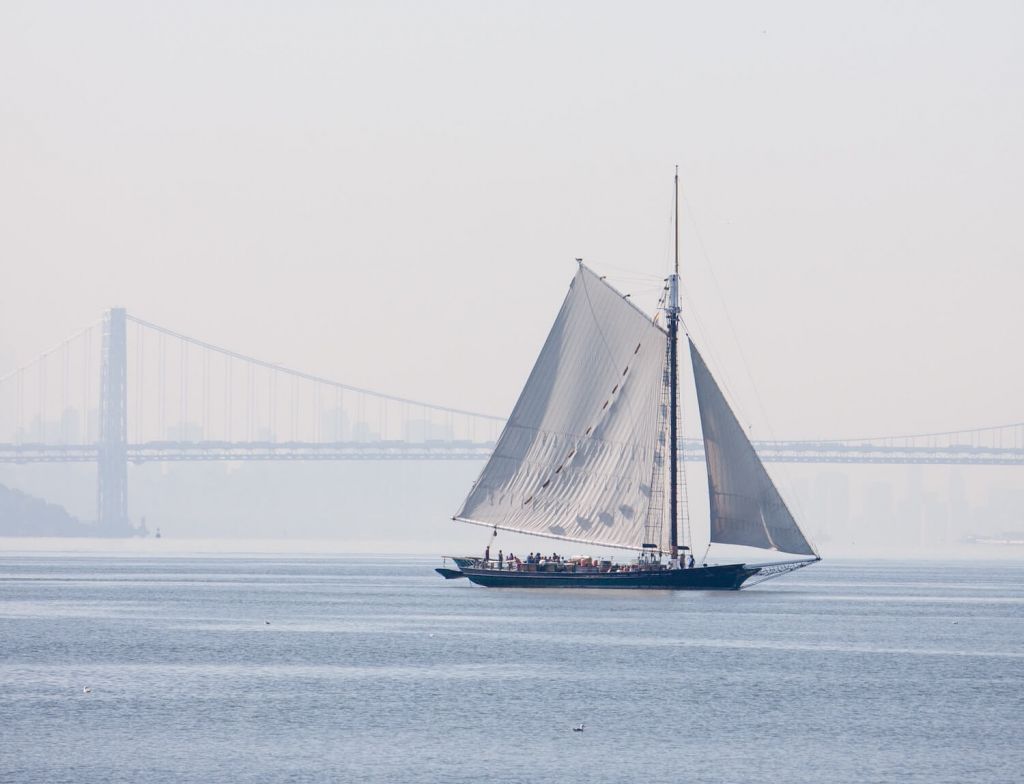
On this page:
Rectangular sails mean larger sail area, shorter and much stronger mast, lower center of gravity, less stress on the mast and rigging, simpler rigging, low maintenance, looks gorgeous, easy to sail, easy to learn, oversheeting is much less problematic, outperforms bermuda rig in most cases, disadvantages.
Because of the way the gaff rig is set up, it provides more sail area for the same mast length. In other words: you can carry more sailcloth per feet of mast. This is an advantage for a couple of reasons, which I'll go over in detail below. First of all, it reduces the stress on the mast and rigging. This, in turn, results in easier and softer rigging, which can be lighter and easier to operate.
The reason you can carry more sail area is that you carry rectangular sails, thanks to the top spar that attaches from the mast to the top of the sail. That top spar is called the gaff.
The downside of these huge pieces of cloth, however, is that the windward performance of a gaff rig is less optimal than that of a Bermuda sloop. However, you can figure out a way in which a gaff rig outperforms most Bermuda sloops. To understand this, I need to make a quick distinction.
There are two kinds of gaff rigs:
- Authentic gaffers - these boats are from the 1900s and are pretty outdated. They look great, but they are heavy and not set up to sail single-handed.
- Modern gaffers - these boats use the newest technology and are set up in a way that makes sense in the 21st century.
All of the advantages below are largely dependent on the way the boat is fitted. If it's a modern take on the gaff rig, you'll find it has a lot less of the characteristic disadvantages (which you'll find at the end of the article). More 'vintage' rigs will likely have one or more disadvantages compared to the contemporary Bermuda rig. To be fair, so will a Bermuda Sloop from the 1900s. So it's important to keep in mind that we should compare apples to apples and pears to pears.
I have sailed a gaff-rigged Cornish Crabber for a week across the Frisian lakes and they are incredibly easy to operate. But these old boats are slow and tend to be heavy (especially the boom and gaff, which were huge). We were constantly overtaken by modern cruisers. You can't really compare the two.
Now that this is out of the way, let's continue with our list.
Since you can get a disproportionate sail area with the same mast length, many gaff rigs have a shorter mast than their Bermuda cousins. A shorter mast means it will be a lot stronger. You don't lose sail area, but you do lose a lot of extra lengths, cost, and points of failure.
That seems to be the theme of the gaff rig. It's in nearly all ways superior to Marconi (Bermuda) rigs for daysailing and recreational cruising. Unless you're a racer, it's the better option in many ways, Michael Kasten argues on his website .
Thanks to the shorter mast, the center of gravity of the gaff rig are lower than that of the Bermuda rig. This helps to reduce heeling, making the gaff rig a bit stiffer.
If you're unsure what all these rigs look like, or what it means, I recommend to read my Illustrated Guide to Rig Types here .
Thanks to the top spar, the forces on the sail are distributed more evenly. A shorter mast means it's being less stressed and the both the standing and running rigging take a lot less force.
Thanks to the reduced stress on the entire rig, you can fly with much simpler rigging.
You also lose a bunch of additional rigging. For example, you need less sheets, no spreaders, and less hardware to keep your sheets in check. Overall, softer lines and sheets can be used. Not the hard steel cables on Bermuda rigs.
This makes the gaff rig softer to handle, making it a great choice for recreational sailors - as long as you're not constantly beating over the tide.
Especially with the modern take on the gaff rig, a short-gaff configuration, you greatly simplify the rigging needed to operate the main, as well as reduce the total weight of the mast and rigging.
The downside of a simplified rig is that it can potentially be more difficult to sail short-handed. It really depends on the specific boat and the way you set it up. As said, you can fit a gaff rig with all the modern comforts like winches if you want to. If you do, you can set up rig that deals with the gaff rig's cons, while keeping the good parts.
As a result of simplified rigging and a softer set up, the gaff rig can be cheaper than a Bermuda rig. I emphasize can be , because it really depends on your particular set up. Not to get old here, but a vintage boat will be exactly the same as having a vintage car: everything will be (more) expensive.
However, if you opt for a no-nonsense, practical, modern rig, instead of conserving a museum artifact, it can definitely be cheaper, just in terms of the amount of hardware and rigging you'll need to purchase. Let alone maintain.
So of course a more simple rig means it is also easier to maintain. Less hardware and rigging means less stuff that's gonna break over time. But what also plays a big part is the 'softer' set up. Everything gets less stressed: your mast, rigging, even the sails themselves. That's where the gaff rig really stands out. It just doesn't age the same way as a Bermuda rig would. It is much less prone to wear and tear. Which means you'll have a lot less maintenance to do.
Less moving parts, less wear, cheaper materials = cheaper and easier.
The gaff rig is incredibly good-looking. In my opinion, it's the most beautiful rig around. Just look at it:
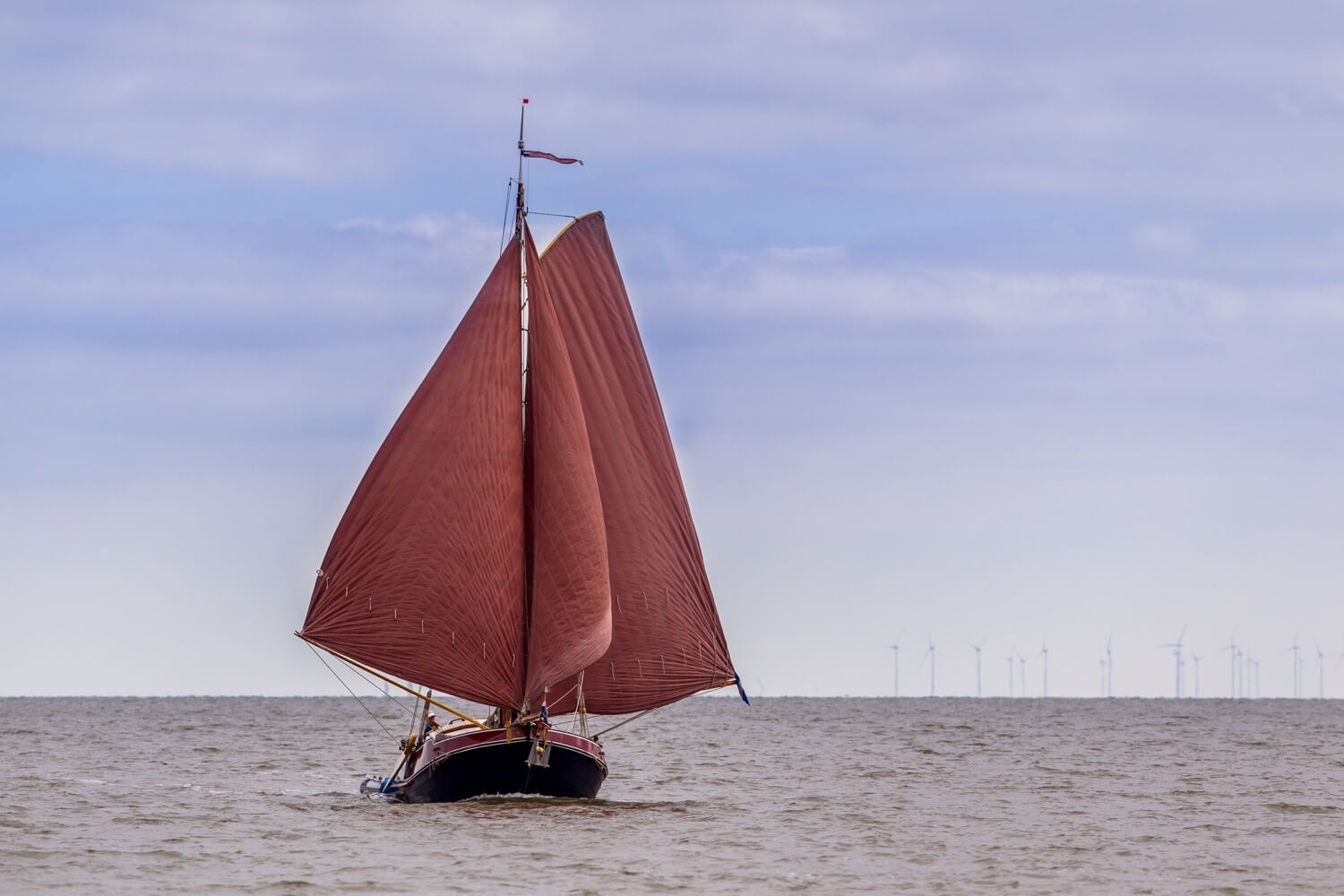
However, everybody has his or her own preferences, and you don't have to agree with me (although I find that hard to believe).
If you can resist the temptation to leave the topsails out of the equation, the gaff rig is really easy to sail. Although people tend to assume gaff rigs aren't meant to be sailed alone, I have, and pretty successfully uneventful .
But I repeat: you should resist the usage of topsails (go bald, as they say). The topsails add a whole lot of work, and the extra pain may outweigh any benefits you get from sailing this rig. Luckily, the solution is pretty simple: just don't fly the topsails.
However, if you get yourself an 'authentic' gaff rig, all of this doesn't really count. Those were built to be operated by small crews of 5-7 people, and they have no winches and rail. So it will be actually more work to sail it by yourself. Modern gaffs will typically fix these issues.
Hoisting the main requires a bit more effort. It's a bit slower to operate, sure, but as there are a lot less moving parts, it's easy to understand and get the hang of it. Which brings me to my next point.
The gaff rig is a bit What You See Is What You Get : there are no intricacies and because of the reduced strain on ... everything, it might be a very good starter rig to learn to sail.
Thanks to reduced strain on the standing rigging and mast, a lower center of gravity (which reduces heel) and the tendency of the gaff to sag to leeward, you could say the rig is a bit safer than the Bermuda rig.
"As the boat heels to a squall, the sagging gaff lets much of the force of the wind escape harmlessly over the top." Practical Boat Owner, No 330 June 1994 .
A small disclaimer: this only goes for modern gaff rigs that are well-built and well-designed. Everything else goes of the table. While a Bermuda rig has better windward performance, the gaff rig actually performs really well with tides and light winds.
I don't know about you, but I'm not a competitive sailor by any means. I only sail with fair weather. Add to that a little bit of tide - in those circumstances, a gaff rig is probably the better option.
The Bermuda rig is definitely the better choice for speed, maneuverability, and tacking upwind. While I like those characteristics, my life tends to be a lot less cinematic than I like to believe.
"A gaff rigged boat will perform incredibly well, in many cases besting the performance of a high aspect ratio Marconi rigged boat." Michael Kasten at KastenMarine.com
The gaff rig absolutely has disadvantages as well, and I thought it'd be fair to briefly mention the most important ones below.
Windward performance can be subpar
The gaff rig is notorious for louse windward performance, and it's true: the Bermuda rig will outperform the gaff rig - especially on a hard beat to windward. However, it's a small price to pay for the ease of use and simpler maintenance you get in return.
Reefing can be more dangerous with a gaff
You have to remember that you're carrying a large second boom, which is right at head-height when putting in a reef. You don't want to be there when the wind catches it.
Parts for the Marconi Rig may be more readily available
Since Bermuda sloops are so incredibly popular, parts may be more widely available and may be cheaper as well. It's my guess that problem-solving on a gaff rig is easier though, since you can get away with more MacGyver-type solutions.
Using the topsail can be a pain
We touched on this, but I think it's important to mention again, since it can really be a deal-breaker regarding ease of use.
I'm by no means an expert, which is why I have added some great sources to read on, by people who know a lot more about building sailboats than I do. I encourage you to read on and learn more before choosing your next rig.
That being said, there's a lot to be said for the gaff rig. It's beautiful, classic - but it also performs really well if set up correctly. It's not at all obvious that the Marconi rig is superior in all ways. It really depends on your sailing circumstances.
So now you have a great overview of the things to consider when choosing a rig type. If you want to read about other rig types, make sure to check out some of the other articles below.
Aren’t gaff sails cheaper per m2 to buy. I imagine it is simpler since there is not so much change in camber as there is with a triangular sail?
Great breakdown. Many years ago I sailed both gaff and Bermuda rigs and gaff rigs have always held a special spot in my heart. I wonder if you might compare a gaff schooner rig to a ketch? That adds an extra dimension to the comparison.
Can the gaf be used to hoist cargo on board?
Some examples of modern Gaffers would be useful - I assumed the Cornish Crabber would be modern rather than old!
“Cornish Crabbers” is an English company that build a range of trad looking GRP boats up to around 30ft, mostly gaff rigged. The original 24ft Cornish Crabber started life in the 80’s with plywood hulls, but was eventually converted to full GRP hulls. Details here: https://www.cornishcrabbers.co.uk Very nice looking boats but rather cramped and expensive.
I have a traditional 24ft gaff cutter that I love and agree with much of what Shawn writes. However one disadvantage he doesn’t mention is the challenge of gybing with running backstays in a fresh wind, especially if single or short-handed. I also would have classed the Cornish Crabber as a modern gaffer. A previous 27ft timber gaffer I owned had alloy spars and a topsail with its own spar, again alloy, and a jackyard. I often set it singlehanded, and found it gave a major performance boost in light to moderate conditions.
From personal experience, sailing Gaff rigged traditional yachts (without engines) on the Norfolk Broads in UK - i think a real plus point of Gaff over Bermuda [for inland river sailing, through raised riverbanks & trees], is that the centre of effort is higher up, so you can catch more of the available wind….
You also have increased flexibility with how you can set-up the sail, and adjust it’s shape to suit your needs:
Leave a comment
You may also like, 15 surprising benefits of a ketch rig (and 7 cons).
If you're trying to figure out whether the ketch rig is for you, there are a couple of important factors to consider. In this article, I'll sum up the most …

Guide to Understanding Sail Rig Types (with Pictures)

The Ultimate Guide to Sail Types and Rigs (with Pictures)

17 Sailboat Types Explained: How To Recognize Them

Different Types of Sailing and Racing Explained

- Sails & Canvas
- Hull & Structure
- Maintenance
- Sailing Stories
- Sailing Tips
- Boat Reviews
- Book Reviews
- The Dogwatch
Select Page
Keel design: What’s best?
Posted by Ted Brewer | Boat Reviews
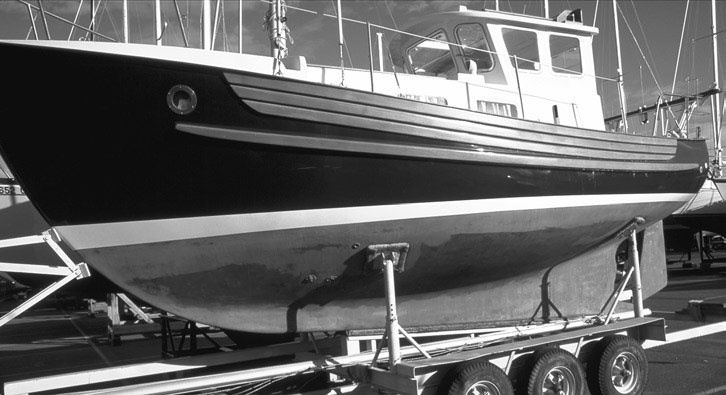
Ted Brewer reviews the ins and outs and ups and downs of keel design
The purpose of a keel, fin, or centerboard is to provide resistance to making leeway; in effect, to keep the yacht from sliding sideways through the water due to wind pressure on the sails. Various shapes of underwater plane have been in and out of style over the past 150 years.

The highly stylized shark fin has extreme rake and a sloping tip chord.
The basic full-keel shape had the longest run, as it was the standard for bluewater sailing craft from pre-Roman times to the earliest days of yachting. The deep, full keel was supplemented in the mid-1800s, for the shoalwater areas of Britain and North America, by centerboard craft. These cover such working types as the sharpies, Cape Cod catboats , and Chesapeake Bay oyster skiffs, to mention a few.
The first truly modern keel yacht, with a cutaway forefoot and highly raked rudder post, was designed by Capt. Nathanael Herreshoff with his Gloriana design of 1891. But it did not catch on for bluewater sailing. Until the late 1920s, the typical offshore yacht, whether cruiser or ocean racer, resembled a sailing fishing craft in the shape of its lateral plane: a long, full keel with deep forefoot and fairly vertical sternpost. Such a shape has the benefits of good directional stability, ease of steering, and the ability to heave to in heavy weather, all desirable traits for a boat. However, its faults may include slowness in stays, excess wetted surface making it slower in all types of air and an inefficient lateral plane shape that has excess leeway, considering its relatively large area. Typical small yachts of this type are seen today in the Colin Archer types and the Tahiti ketch and its copies, while replicas of traditional sailing craft such as Bristol Channel Cutters, Friendship sloops, fishing and pilot schooners, and similar lovely vessels still appear in our waters. Fortunately, many of these workboat types have been developed to the point where the ills of the true full keel have been greatly reduced. Then the result is a handsome cruiser that sails quite well and attracts a great deal of attention wherever she drops her hook.
Successful Sailboat Keel Types
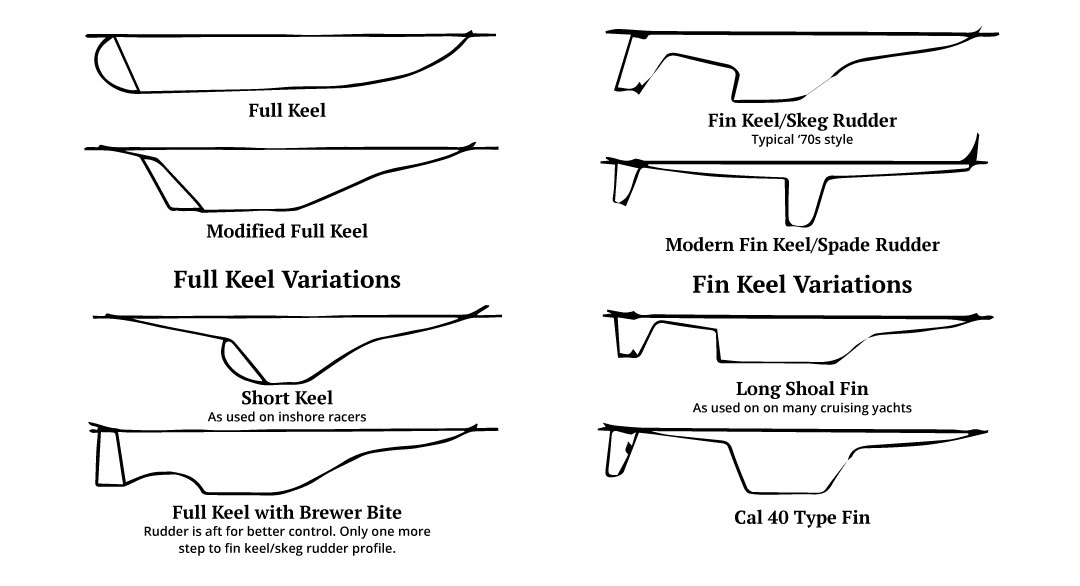
The cutaway keel was revived for ocean racing by Olin Stephens in the late 1920s, with his lovely yawl, Dorade, still sailing and winning classic yacht races more than 70 years after her launching. Her offshore racing successes finally proved that the full keel was not essential to seaworthiness, and it definitely detracted from speed and weatherliness. As a result of its improved performance and handiness, the “modified full keel” form caught on quickly once Dorade showed the way and became the standard for the next 35 years. This type of lateral plane is still sailing in many popular older designs such as the Albergs, the Folkboat, the Luders 33, the Whitby 42, and even some newer yachts.
The modified full-keel form features generally good handling and directional stability plus reduced wetted surface, compared to her true full-keel sister. The yachts can perform well in all conditions and, as they are generally of heavier displacement than contemporary ballasted-fin boats, they do not give away much in light air, despite the added wetted area. A yacht with a modified full keel can sail right up with the best of them if she is given sail area commensurate with her typically heavier displacement.
In my own work, I developed a modified full keel, with the rudder set aft and vertically in the contemporary fashion, in order to improve directional stability and handiness. Then, to reduce wetted area, the lateral plane is substantially cut away ahead of the rudder in what some have termed “the Brewer bite.” The Cabot 36 and Quickstep 24 of my design were early examples of this form. The size of the cutout depends to a large degree on how insistent my client is on having a “full keel,” and I try to make the cutout as large as I can decently get away with. I don’t claim to have originated the shape, though, as the late L. Francis Herreshoff used a not dissimilar profile many years earlier in the design of the lovely 57-foot ketch, Bounty.
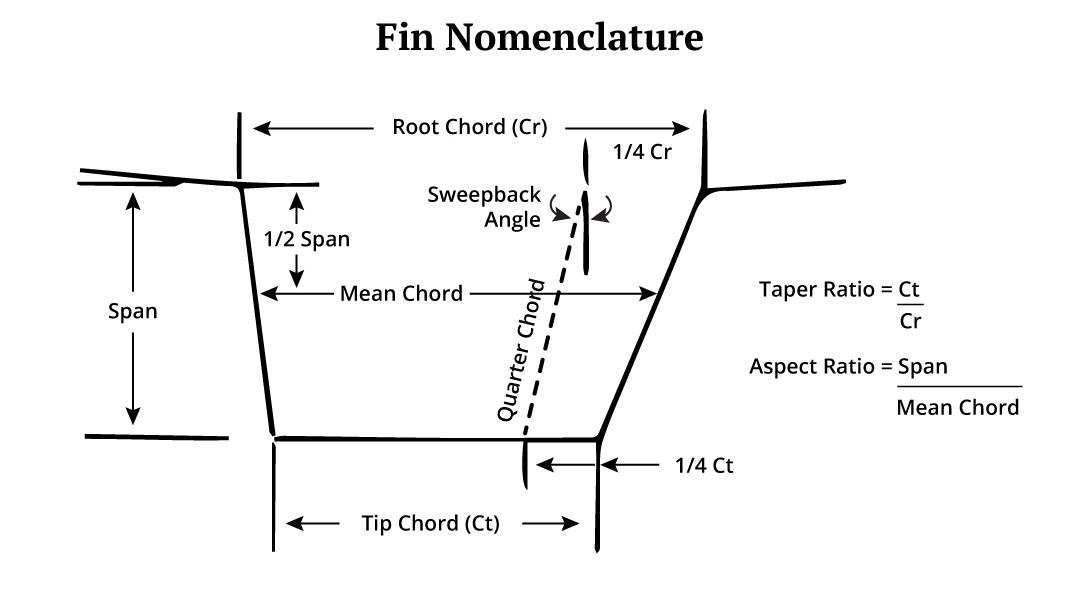
Taken to Extremes
Like all good things, the modified full keel was cut away more and more for bluewater and inshore racers in an attempt to reduce wetted area until, finally, some designers took it to extremes. This reduced directional stability and produced craft that were almost impossible to steer in breezy conditions, broaching with monotonous regularity. I can recall working on the design of many short-keel 5.5-Meter yachts in the 1960s, and we always said they were three-man boats with six-man spinnakers! It’s hard to believe none of them were knocked down and sunk, as they were extremely difficult to control on a reach or run, and the hulls were pure leadmines, with 3,500 pounds of ballast in their very short keel and only 1,000 pounds of wood and rig above it!
Olin Stephen’s genius began another fad in the mid 1950s, the keel-centerboard design. After Finisterre showed the way, keel-centerboard yawls were built in sizes from 24-foot midget ocean racers, to the largest offshore yachts, in order to take advantage of favorable ratings under the CCA rule and emulate Finisterre’s record of wins. The keel-centerboard hull has gone out of fashion now, but the type still has merit where a stable, beamy, shoal-draft yacht is desired with little sacrifice of weatherliness or seaworthiness. Indeed, the Bill Tripp-designed Block Island 40 and Bermuda 40 are keel-centerboard ocean racers from the old school and have been in production for more than 30 years now. These classic yachts have made many long ocean voyages, including several world circumnavigations and are first-class bluewater cruisers in every respect.
Keel Types Here to Stay

A rather squared-off fin, not unlike the Cal 40 keel.
The fin shape is not new either, as ballasted fin yachts were pioneered by Herreshoff at the turn of the century for inshore racing. Then, due to excesses and bad design, the shape died out, except for a few one-design classes, until Bill Lapworth dropped a bomb on the ocean-racing scene in the mid-1960s with his Cal 40 design. The Cal 40s made believers out of many yachtsmen who could not believe that a ballasted-fin/spade-rudder yacht was a serious bluewater ocean racer. After wins in the Trans-Pac, many East Coast races, and the 1966 Bermuda Race, it became evident that the fin was here to stay for ocean-going and coastal cruising yachts. Please note that I do not use the term “fin keel” anymore, as I feel it is a misnomer. The keel is the structural backbone of the vessel, and the fin hangs from it. Fish have both backbones and fins; so do yachts.

A less extreme fin keel, with a more parallel tip.
A well-designed fin, in conjunction with a skeg-hung rudder, can provide excellent directional stability, handiness, reduced wetted area and improved weatherliness. The fin/spade rudder combination reduces wetted surface even more. It may have a little (or a lot) more sensitive helm than a fin/skeg rudder yacht, but it has one big advantage over it and all other forms of lateral plane: it can be steered in reverse under power. This can make life a great deal easier in today’s crowded marinas, as many have discovered.
These are some of the reasons that we see fins on the great majority of our new yachts today; they are not simply a fad. There are good fins and bad fins, of course, and it is not always easy to tell them apart. The shape of fins over the years has been limited only by the designer’s imagination. Fins have been set at every angle from the vertical to highly raked aft. They have been deep and narrow, shoal and long, resembling a shark’s fin or whale’s tail, or boxy fins similar to the original Cal 40 design.

A contemporary bulb fin with winglets.
Major Problem
A very deep, narrow fin can be a problem to haul on a marine railway, so the cruising skipper should consider haulout ease when boat shopping. A crane or travel lift is the best method for hauling yachts with extreme fins, but may not always be available in out-of-the-way areas. There is also the danger of damage to the shaft or strut if slings are improperly positioned. Still, the major problem of the high-aspect-ratio fin is structural strength, as it can impose extreme loads at the point of attachment to the keel. Indeed, some years ago I was an “expert witness” in a court case concerning three men who drowned when their yacht sank as a result of its fin tearing off when the vessel ran aground.
The cruising skipper would do well to avoid yachts with extreme fins, both for considerations of haulout ease and structural strength. Fortunately, the heavier, deeper hull and generally shoaler draft of the typical cruising yacht mean there is less height available between the bottom of the hull and the point of maximum draft. So, a longer, lower-aspect-ratio fin is the only solution. On the other hand, the racing sailor will want a fin with an aspect ratio as high as the draft rule will allow. Such a fin is more efficient per square foot, so the area can be smaller and the wetted surface reduced. In Aero-Hydrodynamics of Sailing, C.A. Marchaj recommends about 4 percent of the sail area as a good guide for fin area, and I feel the cruiser should err on the high side, as a small increase in resistance is preferable to increased leeway. On the other hand, I have used as low as 1.75 percent area with good results on an extreme racer with a fin of 2.75 aspect ratio.
Sailboat Keel Aspect Ratios
This “aspect ratio” is the ratio of the span (depth) squared to the fin area; that is, my extreme fin had an 11-foot span and 44 square feet of area, so its aspect ratio was 121/44, or 2.75. If it had a 4-foot span with 44 square feet of area, not uncommon proportions for a cruising yacht, its aspect ratio would be 16/44, or a low 0.3636.
The aspect ratio can also be described as the span divided by the mean chord, the average fore-and-aft length of the fin, and this gives the same result.
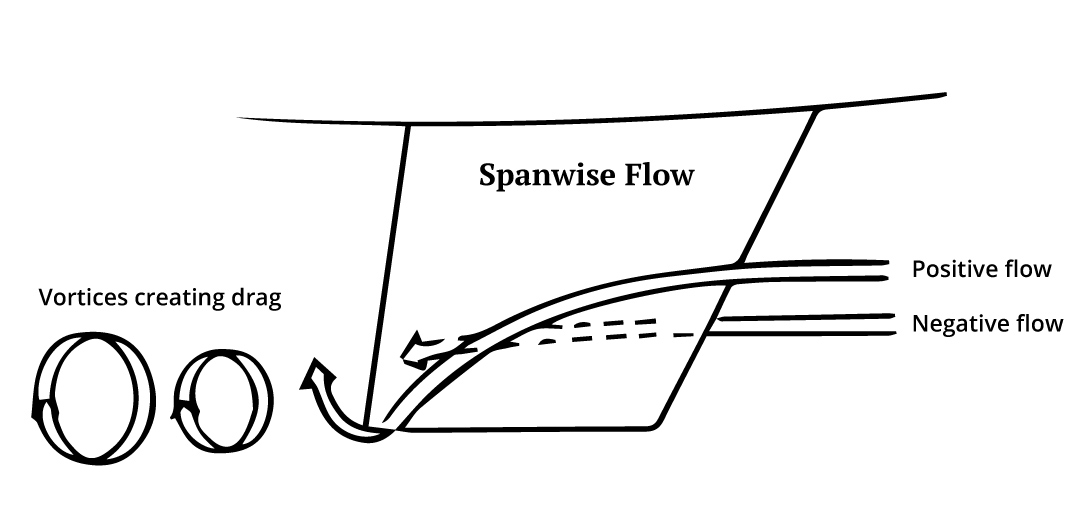
A large part of the resistance of a keel is created by the vortices, similar to miniature whirlpools that form when the water flows across the bottom of the keel from the high-pressure (leeward) side to the low-pressure (windward) side. It requires energy to form those vortices and that energy is then not available to propel the boat forward. Obviously, the shorter the keel or fin tip, the smaller and weaker those vortices will be, and that translates to reduced resistance. This is one reason that racing yachts usually feature high-aspect-ratio fins with short tip chords.
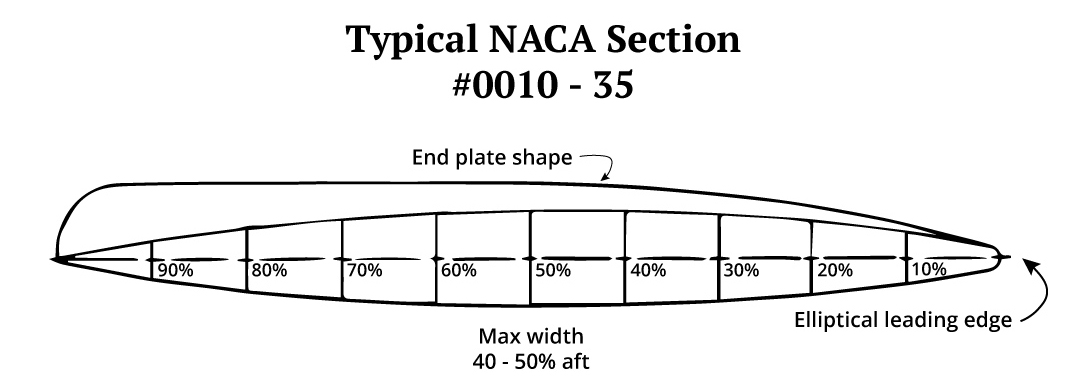
However, the formation of vortices can be greatly reduced by using end plates, or wings, to change the flow direction and eliminate crossflow. My own preference, for a fin of average span, is for an end plate that is but a few inches wider than the maximum width of the fin bottom. We tested an actual yacht with such an end plate on one side only and noted a substantial improvement in performance when she was heeled so that the end plate was on the leeward side. Where the draft is shoal and the fin span is on the small side, then a wider end plate, or even a wing, might prove beneficial. However, a wide wing can be a structural weakness, particularly if the boat goes hard aground and has to be towed off, or pounds on the rocks for any length of time.
Sweepback Angles
In the 1970s, I saw more than one very-high-aspect-ratio fin with tremendous sweepback angle. This certainly gives an impression of speed but, as Marchaj pointed out, tank tests have shown that the sweepback angle can be related to the aspect ratio: the higher the aspect ratio, the more vertical the fin should be. Indeed, the very-high-aspect-ratio fin on my BOC racer was set absolutely plumb until a hard grounding set the tip back a quarter inch or so, the result of taking a yacht with a 13-foot draft through a channel dredged to 11 feet! Most cruising-yacht fins are of low aspect ratio, of course, so should have substantial sweepback, up to 57 degrees, with an aspect ratio of 0.5, according to Marchaj. Although most designers try, it is unfortunate that obtaining the perfect sweepback angle is secondary to locating the fin to balance the sailplan, as well as fitting the ballast at the correct spot for proper fore and aft trim. The taper ratio (tip chord length/root chord length) also deserves consideration. Tests on one series of fins showed that a fin with 0.32 taper ratio was 1 percent more efficient than an untapered fin and had very slightly less resistance. This is a small difference but cannot be ignored by the racing skipper. Again, the reduction in drag may be due to reduced vortices from the shorter tip chord. Marchaj also states that the taper ratio should be reduced as the sweepback angle increases. However, the very-low-taper-ratio fins may not be the best solution for a cruising yacht. The tip chord should be long enough so the vessel can be hauled on a marine railway with no major problems. Too, on a moderate-draft cruising yacht, a short tip chord forces the ballast higher, so stability can suffer.
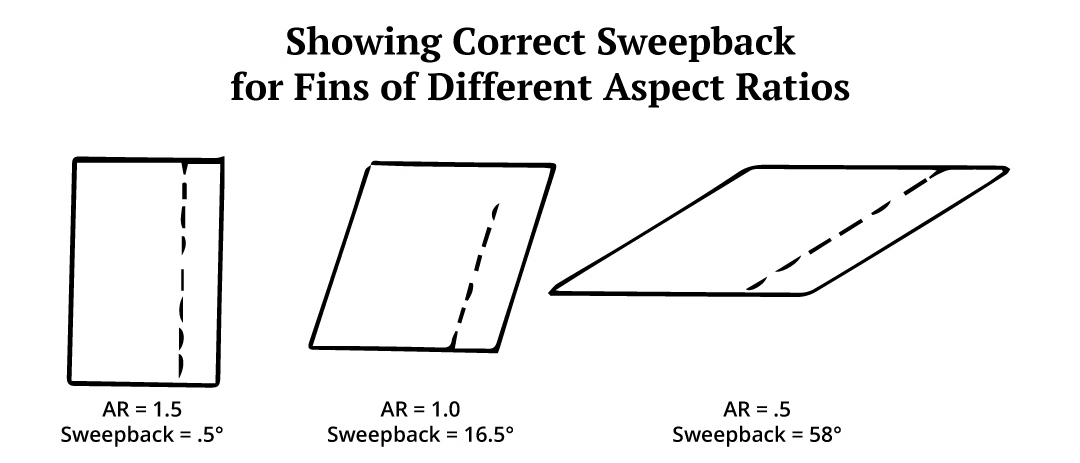
Lower Ballast
Another consideration in the fin profile is whether the tip chord is sloped down aft or parallel to the waterline. The parallel tip chord makes good sense. It allows the ballast to be lower for added stability, it eases blocking up the boat when hauling and, fortunately, tests have shown that it is also superior to the sloped tip chord in other ways. Having the aft edge of the tip chord deeper than the leading edge has no practical effect on aspect ratio, and such a fin develops less lift and more drag than one with a parallel tip.
The National Advisory Committee for Aeronautics (NACA) tested a large variety of streamlined shapes for lift and resistance and the information on these is available in a book, Theory of Wing Sections, by Abbot and Von Doenhoff. These are the shapes that designers refer to when they say their new magic fin has an NACA section. Generally, the shape selected will be similar to NACA 0010-34 or 0010-64 series. The leading edge will be elliptical, as a blunted nose increases resistance while a pointed leading edge promotes stalling. The maximum width will be about 40 to 50 percent aft, and the shape will be streamlined to a fairly sharp (but not razor-sharp) trailing edge. The thickness ratio will be 0.8 to 0.12 of the chord length, although this may be increased to 0.15 to 0.16 at the tip chord. There are advantages to having an increase in thickness ratio at the tip chord, including being able to fit the ballast lower. This need not mean that the fin is bulbed, though. For example, a fin that is 8 feet long at the root and 5 feet long at the tip may have a 0.10 thickness (0.8 feet) at the root and 0.15 thickness (0.75 feet) at the tip. The fin is still slightly thinner at the bottom than at the top, but the thickness ratio has increased.
Increased Resistance
It is not uncommon to see fins wider than 10 to 12 percent of their length, as the designer may need to fatten the fin in order to locate the ballast in the correct spot for proper trim. Very shoal-draft boats may require fatter keels or fins in order to get the ballast as low as possible for stability. Still, extra width does increase resistance so there is a tradeoff; added stability increases performance while a thicker fin reduces performance. Thirty-five years ago, when I worked for Bill Luders, we tank-tested dozens of 5.5-Meter models. These very short-keeled 30-foot sloops had a minimum keel width of 4 inches under the rule, and whenever we tried a model with a wider keel in order to get the ballast lower, we found that overall performance suffered.
We also tested a number of bulb keels on the 5.5 models but they never proved out in the tank, either, although several different shapes were tried. Then, in the late 1970s, I tank-tested the model of the new Morgan 38 at Stevens Institute, first with a fairly fat NACA fin in order to maintain the desired 5-foot draft, and then with a patented bulb fin that we let its designer draw up, with no stipulation on draft. The bulb saved only 2 inches of draft but showed so poorly against the NACA fin that the 38 was put into production with the more conventional shape.
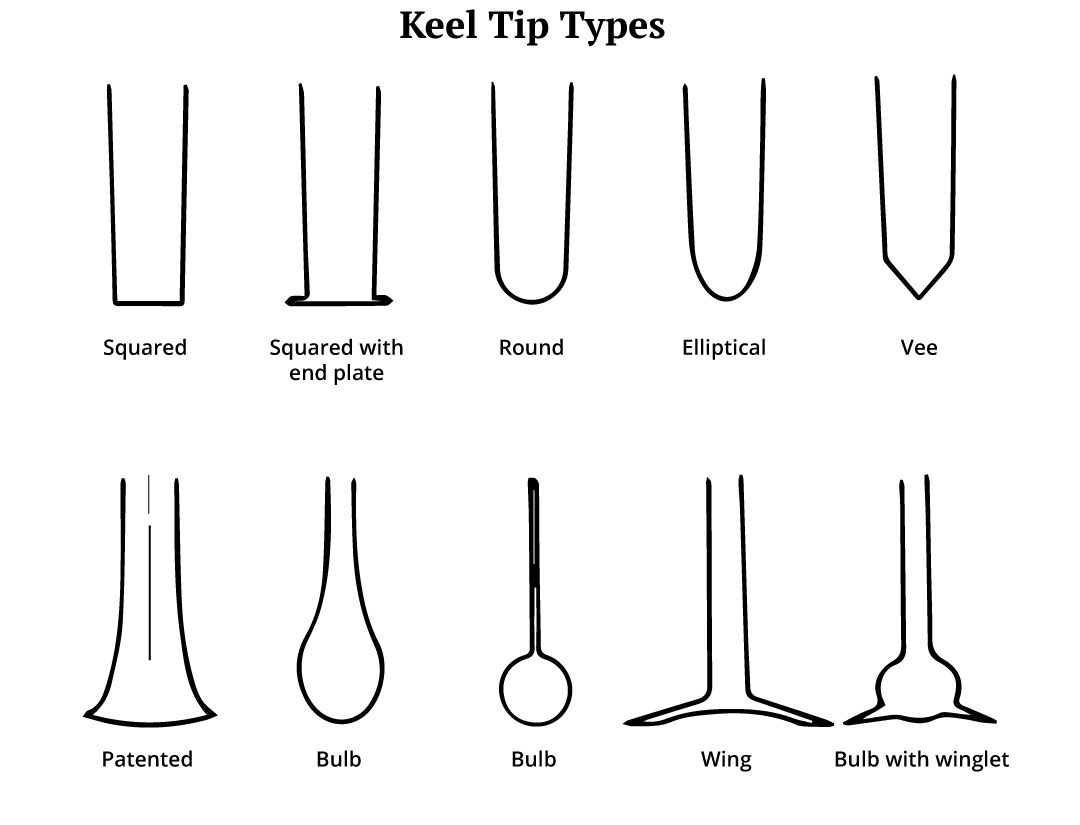
The tip shape, viewed from ahead, may be flat, round, elliptical, or bulbed. Tests show that the flat, squared-off tip develops a bit more lift to windward and that the round or elliptical tip has less drag on a run. The differences are slight but, today, I favor the squared-off tip with an end plate for yachts of average draft. A vee tip was tried in the 1960s on a few yachts, but never became popular. Bulbs and wings, often in combination, are fairly common on contemporary production boats. Usually, they are an attempt to produce a very shoal-draft yacht for use in waters where the bottom is close to the top and, in those cases, they may make sense.
There is a never-ending variety of fin shapes and, to be honest, I’m not sure which is best. Generally, I prefer a fin similar to the old Cal 40, a little shorter perhaps, and fitted with an end plate. Such a fin provides a desirable combination of good performance, ease of haulout, and structural strength, all very important factors for the cruising skipper.
Article first appeared Good Old Boat magazine: Volume 3, Number 4, July/August 2000 .
About The Author
Ted Brewer is one of North America's best-known yacht designers, having worked on the America's Cup boats, American Eagle and Weatherly, as well as boats that won the Olympics, the Gold Cup, and dozens of celebrated ocean races. He also is the man who designed scores of good old boats, the ones still sailing after all these years.
Related Posts
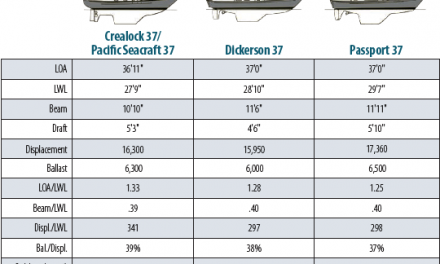
Crealock 37/Pacific Seacraft 37 Boat Comparison
June 10, 2020
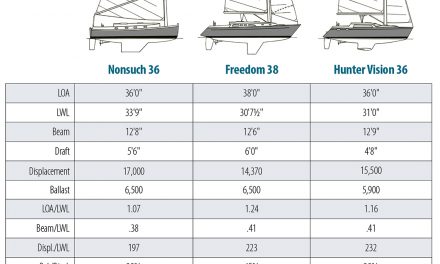
Nonsuch 36 Design Comparison
August 4, 2020
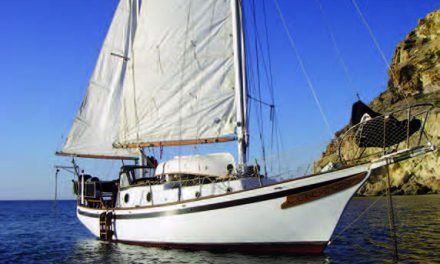
Timeline for Sailboats Built In Japan
January 1, 2014
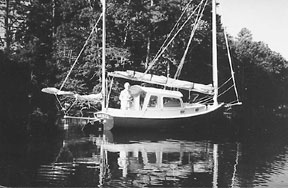
Good Old Catboat
July 17, 2019
Current Edition
Join Our Mailing List
Get the best sailing news, boat project how-tos and more delivered to your inbox.
You have Successfully Subscribed!

The global authority in superyachting
- NEWSLETTERS
- Yachts Home
- The Superyacht Directory
- Yacht Reports
- Brokerage News
- The largest yachts in the world
- The Register
- Yacht Advice
- Yacht Design
- 12m to 24m yachts
- Monaco Yacht Show
- Builder Directory
- Designer Directory
- Interior Design Directory
- Naval Architect Directory
- Yachts for sale home
- Motor yachts
- Sailing yachts
- Explorer yachts
- Classic yachts
- Sale Broker Directory
- Charter Home
- Yachts for Charter
- Charter Destinations
- Charter Broker Directory
- Destinations Home
- Mediterranean
- South Pacific
- Rest of the World
- Boat Life Home
- Owners' Experiences
- Conservation and Philanthropy
- Interiors Suppliers
- Owners' Club
- Captains' Club
- BOAT Showcase
- Boat Presents
- Events Home
- World Superyacht Awards
- Superyacht Design Festival
- Design and Innovation Awards
- Young Designer of the Year Award
- Artistry and Craft Awards
- Explorer Yachts Summit
- Ocean Talks
- The Ocean Awards
- BOAT Connect
- Between the bays
- Golf Invitational
- BOATPro Home
- Superyacht Insight
- Global Order Book
- Premium Content
- Product Features
- Testimonials
- Pricing Plan
- Tenders & Equipment

Solleone — every inch the modern high-performance racing yacht
When a world-famous yacht builder like Nautor’s Swan debuts a new model, the sailing world pays heed. It’s especially true when this launch is its biggest current production model and the second largest yacht it has ever built – for company chairman Leonardo Ferragamo , no less.
Add to the equation Germán Frers as the naval architect of the all-carbon vessel and it is clear that 35.2 metre Solleone is a truly noteworthy newcomer. Does she live up to expectations? I’m on the Côte d’Azur to find out.
The first test of a yacht’s potential success is its appearance and Nautor’s Swan has always understood that owners must be able to take pride in their boats. Solleone – whose name combines the owner’s and two of his children’s names but also suggests summer heat – certainly fulfils this ambition.
Her low silhouette, near-vertical bow, wide stern, broad beam and high-aspect ratio rig create the very image of a modern high-performance yacht.
In fact, with her carbon rig sporting twin masthead backstays as well as runners, and a “fat head” North 3Di mainsail slab-reefed on to her Park Avenue-style boom, Solleone could well be mistaken for a new generation racer.
But this is Nautor’s 115 S cruising version, as opposed to the yet-to-be-launched race-oriented 115 FD , which has only a low blister of coachroof rising from an otherwise flush deck. Both of these elegant variants pass the beauty test with flying colours.
Another necessity for a yacht of this stature to be successful is that it must sail like a true thoroughbred. Few Swans have ever failed this test, so when I join Solleone in Villefranche, I have high expectations, despite the sub 10-knot wind forecast.
Moored alongside Solleone is Ferragamo’s previous Swan 90 S . It is readily apparent that the deck layout of the new 35.2 metre owes much to the smaller model.
Both sport ultra-clear foredecks, a well-organised area around the foot of the mast, guest cockpits set behind the low rise of the coachroof and helm stations sunk on a slightly lower deck level further aft.
I begin to grasp the yacht’s simplicity of operation as soon as we motor out of the harbour and raise the sails. Despite her length and cruising appellation, Solleone has no push-button captive winches for sail handling.
Three huge Harken drum winches, positioned on either side of the sailing cockpit, handle the jib, staysail and asymmetric spinnaker, while the main – tacked down to a single point on the centerline – is tailed on a seventh winch, centrally positioned between the helm stations on the higher deck level.
The North 3Di main works with the perfection of an aircraft wing and Solleone soon demonstrates her light-air performance in very able fashion. Immediately, I notice that the helm’s sunken position offers no impediment to visibility forward.
Indeed, because of the low-profile deckhouse, the set-up is better than on many cruising yachts with raised helm positions, and it even offers a modicum of shelter.
With the mainsail hoisted and the jib unrolled from a Reckmann furler, our close-hauled speed climbs to 8.2 knots with the true-wind speed reading just 7.5 knots on the mast-mounted B&G 40/40 display, a speed she holds even when reaching with a true-wind angle of 90 degrees.
Captain Diego Manuta reports that the best speed he has experienced so far is 25 knots when surfing down a wave off the Portuguese coast under double-reefed main and staysail. Speeds of 14 to 17 knots are commonplace while reaching, he adds.
Ferragamo was on that passage, helping deliver the boat from Finland to the Med. “It was raining, it was foggy, the wind was always head-on,” he says. “The waves were not enormous, but they were always there – and from the front.
"It was challenging, I have to say. But Solleone was fantastic. It’s such a comfortable boat, and is always very quiet inside – even in a rough sea. Going below was like entering another world.”
The steering system is entirely manual, with a chain and cable connection linking the wheels to the twin rudders and their quadrants. The small rudder movement required to keep the yacht on course (typically less than four degrees) testifies to the boat’s excellent balance.
The helm is light and responsive, and feedback can further be improved by uncoupling the autopilot pistons from the quadrants.
Nimble tacking in light-air conditions further demonstrates Solleone ’s good breeding. Instead of the standard main with single backstay, Ferragamo opted for an optional “fat head” (usually associated with racing yachts). While it offers a huge mainsail area for the mast’s height, it also requires using twin backstays.
The clear advantage of this large sail area is that Solleone sails particularly well in the light breeze of Mediterranean summers, although it requires five people on deck to do a trouble-free tack, in addition to the helmsman.
Completing Solleone ’s sail arsenal is a staysail that is power-furled on its halyard by means of a roller-head sunk in the foredeck, and an asymmetric spinnaker, raised with the aid of North’s inflatable-mouthed sock that is flown from the bow in winds of up to 20 knots.
Certainly Solleone ’s attributes will please even the most demanding sailors, but fair-weather types who prefer their yachting paired with a glass of wine and sunshine will be happy, too.
The cockpit caters for dinners or cocktails, with adjustable tables that lower to seat-height to produce a huge, cushioned sunbathing area, with more seating facing towards the stern.
A bimini, the hydraulically powered skeleton of which rises from a near-invisible locker, shades most of the cockpit. An easy-to-use canvas sunscreen, stiffened by bowed battens, is manually deployed from its stowed position at the front of the structure. Additionally, panels can be fitted to an autonomous dodger that closes off the forward portion for further protection from wind and weather.
Across a deck caulked attractively in pale grey (much cooler for bare feet than the traditional black), the stern opens in clamshell fashion to create a huge bathing platform with easy access to the sea.
The below-decks spaces benefit from Nautor’s advanced construction techniques that have reduced weight, which allows the designer to add volume.
A wide beam carried well aft gives a very spacious interior, which is clearly designed to appeal to owners who have progressed through various sizes of Swan.
“I think the interiors are astonishingly beautiful,” says Ferragamo. Florence-based interior designer Michele Bönan has added an Italian twist and sophistication with a high-gloss varnish finish applied to the vertical surfaces.
They offer a pleasing contrast with the matt white of the leather deckheads and the satin varnish of the teak-and-holly floor planking. Although solid to the touch and beautifully crafted, it is not pure teak but teak veneer on an ultra-lightweight foam core.
Light displacement equates to speed, so savings such as this are important. Throughout, carefully matched luxurious fabrics and linens embellish the effect to create a calm environment.
The deck saloon, positioned above the engine room, provides sheltered lounging and dining for up to 12 guests and good exterior views.
Aft on the lower deck is a supremely comfortable owner’s suite that occupies the whole beam and offers a good lounge area, as well as a shower room incorporating twin basins and a walk-in closet.
Just forward are two equally sized cabins with twin beds. A third guest cabin, this time fitted with a double bed, is forward of the saloon and adjacent to a lower deck saloon/dining area furnished with a settee and teak and canvas campaign-style dining chairs.
Crew quarters and service areas, including a spacious galley equipped with premium household appliances, a small laundry area and three cabins for a maximum of six crew, fill the bow section.
The technical aspects of the Swan 115 S are also very sound. The engine room is ergonomically laid out and neatly assembled around its major components: a 450hp Scania main engine and a pair of Fischer Panda 32kW genets.
The propulsion system uses a standard shaft with a Hundested four-blade fully feathering propeller with reverse pitch. An option exists for a fully retracting shaft and propeller, and this system has been taken up on hulls three and four, both more racing oriented.
“I’m particularly proud of everything the Swan 115 S represents,” says Ferragamo, “from its performance, to its modern lines, sleek hull, well thought-out configuration and astonishing interiors, yet at the same time it still has true Swan elegance.”
The fact that four yachts of this size were ordered straight from the drawing board must surely confirm this view and promises a great future for this latest Swan, which is sure to live up to the highest expectations of the brand’s enthusiasts.
All photos courtesy of Carlo Borlenghi
More about this yacht
Similar yachts for sale, yachts for charter, more stories, most recent, from our partners, sponsored listings.

Berthon Winter Collection

Latest issue

August 2024
In the August 2024 issue of Yachting World magazine: News Few finish a tempestuous Round The Island Race European rules are eased for cruising to France and Greece Olympic sailing…

Yachting World
- Digital Edition

The French JPK 1080 ticks all the boxes for a successful racing keelboat, says Matthew Sheahan
- Matthew Sheahan
- June 1, 2015
This unusual-looking French 35-footer is a high-performance yacht that works well fully crewed and short-handed, says Matthew Sheahan

The JPK 1080 is a good example of an appealing and versatile racer All photos: Jean-Marie Liot
Today, success in the racing keelboat market relies on far more than delivering an exciting-looking boat that goes like a runaway train off the breeze. To win the wallets of owners a new boat has to satisfy three key conditions: first, it must rate well under a popular rating system such as IRC; second, it should have the potential to be a one-design class, ideally with an international following; and third, it should be capable of being raced competitively by both a full crew and short-handed.
Tick all three boxes and as a builder you will have provided three good reasons for potential owners to put your boat at the top of their list. Blathering on about how a boat is as much at home family cruising as it is racing round the cans is no longer a compelling argument. Instead, a boat that is suited to short-handed sailing will often find favour with those who go family sailing anyway.

The JPK 1080’s tall, high aspect ratio rig has provision for fractional kites to make short-handed sailing easier in strong winds
In this respect, niche French builders such as Pogo Structures, Archambault and others in the Brittany boatbuilding region are hitting the bullseye on a regular basis and adding regatta success to their winning list as quickly as there are new customers.
Among builders leading the charge is Brest-based JPK. Its first major success was winning its class in the 2007 Rolex Fastnet Race with the JPK 960. But it was its performance in the 2013 Fastnet that launched the company into the spotlight when one of its JPK 1010s, Night & Day , sailed double-handed by Pascal Loison and his son Alexis, hit the headlines.
Double-handed success
The pair not only won the two-handed class and beat an identical fully crewed boat, but bested the entire 340-boat Fastnet fleet to take overall victory.
The design was no one-trick pony either; various JPK 1010s had already delivered some impressive results round the cans, demonstrating the boat’s versatility. This provided a good starting point for the company to work on a slightly bigger boat.
Designed by Jacques Valer, the first 1080 was launched in February 2014 and quickly made an impression, not least for her looks – her angular stepped-in coachroof gave her the look of the cab windows on a steam locomotive when viewed from head on. But this detail, along with others, is more than just styling; it has practical benefits.

The coachroof ‘bubble’ module provides protection for the companionway area as well as facilitating a good view of the rig and sail plan from below
“Stepping the coachroof inboard allowed more space for the transverse genoa tracks while also providing good visibility forward from below,” says company founder Jean Pierre Kelbert. “This is especially useful when you’re sailing short-handed.”
On deck the recess also provides a good means of bracing yourself when working on the foredeck, and an area forward and to leeward for the full crew to huddle in when the breeze goes light.

The yacht has twin rudders, but a single tiller, which provides more space in the cockpit than twin tillers. A single rudder can be fitted for inshore racing
Originally a professional windsurfer with European titles in 1988 and 1999 to his name, Kelbert started his business building quality sailboards before moving into keelboats. An enthusiastic and successful short-handed and solo sailor himself – he has regularly participated in short-handed events such as the Transquadra, a transatlantic race for over 40s in which Kelbert won the single-handed class in 2008 – Kelbert was inspired to create a practical and easily worked cockpit layout based on many thousands of miles offshore.
Apart from the large, movable foot chocks – why don’t more builders do this? – key control lines such as the coarse and fine-tune mainsheets, the traveller and backstay controls are all placed close to hand for the helmsman. In addition, the mainsheet can be led onto a primary winch on the windward side if required, making it easy to trim the main while helming in any amount of breeze. Other controls can also be reached with ease from the helm.

The foredeck looks straightforward, but the decent-sized toerails and the coachroof position and proportions make the JPK 1080’s deck easy and secure to work
Yet the clever part is that this has been achieved without compromising the layout when the boat is fully crewed. Keeping the mainsail trimmer and mainsheet system abaft the helmsman is one example.
One of the clearest is her single tiller and twin rudders, perfect for short-handed sailing as the rudders provide surefooted control on long offshore legs. The single tiller allows plenty of space in the cockpit while also making it easier to retain full control through manoeuvres. But this boat goes even further as you can switch between twin rudders and a single blade to achieve more nimble performance round the cans if required.
Another example is the option to fit a robust hood over the companionway, which offers greater protection, along with the ability to look up at sail trim from below decks – the ‘bubble’ as JPK refers to it.
Powerful performer, good rating
Under way the JPK 1080 is a powerful yet modest-looking boat. She is light enough to get up into the teens in boat speed in a modest breeze and yet does so without taking a major hammering on her IRC rating.
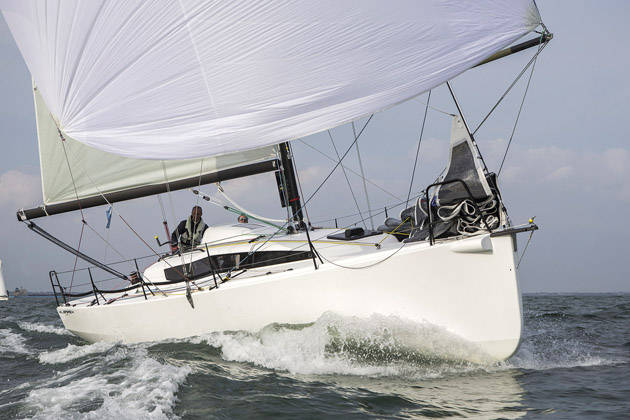
Rigged here with a symmetrical spinnaker and a conventional pole, although, as you can see, the hull has a moulding for a retractable bowsprit for asymmetrics
She has a powerful hull form that keeps the waterline beam to a minimum. Her forward sections carry a decent amount of volume, and her aft sections are beamy and fair with a flat run aft thanks to her aggressive chines. The net result is a hull that generates plenty of righting moment from form stability, particularly useful for short-handed racing when you don’t have anyone on the rail.
Kelbert also says that her resin infusion construction technique keeps the weight in the structure to a minimum while creating a robust and stiff hull, which allows more of the weight to be placed in the keel bulb.
As for her sail plan, Kelbert and Valer were keen to keep the fractional rig in order to achieve better and easier control over the fore and aft bend while allowing smaller fractional kites to be flown in stronger breezes, particularly when short-handed.

The interior is simple, but attractive and effective
Below decks she’s spacious, simple and open, although not quite as well-finished as her arch competitor the Jeanneau Sun Fast 3600. The 1080 is a touch more basic in her finish, although one benefit is a reminder that this boat has no inner liners, with structural members laminated to the hull.
It is still early days for this design, but her pedigree is something to note, as is her most recent win in the European Yacht of the Year awards where her ability to tick off the three major boxes saw her nudge ahead of some stiff competition.
Specifications
LOA 10.80m/35ft 5in
LWL 9.40m/30ft 10in
Beam 3.65m/12ft 0in
Draught 2.20m/7ft 3in
Displacement 4,750kg/10,471lb
Ballast 2,150kg/4,739lb
Mainsail 40m 2 /430ft 2
Genoa 33m 2 /355ft 2
Asymmetric spi 120m 2 /1,291ft 2
Symmetric spi 105m 2 /1,130ft 2
Price ex works ex tax €132,943 (£99,366)
Designed by Jacques Valer
Built by JPK Composites
This is an extract from a feature in Yachting World April 2015 issue
Introducing
Deep draft performance without compromise.
A key benefit of the variable draft keel is not only shallow draft opportunities but also enhanced performance from a deep high aspect ratio keel when fully lowered.
In practise, the boat is stiffer as a result of the improved righting moment, therefore carrying her sail better than other yachts and carving her way efficiently to windward in a seaway. The keel’s aerofoil shaped cross section, with weight concentrated at the tip, is optimised for sailing to windward, allowing you to point as high as 30° apparent with minimal leeway.
The variable keel geometry allows the keel to be set at any position between fully raised and lowered, enabling the keel to be set and optimised according to your point of sail.
An example of this is having the keel fully raised when sailing downwind.
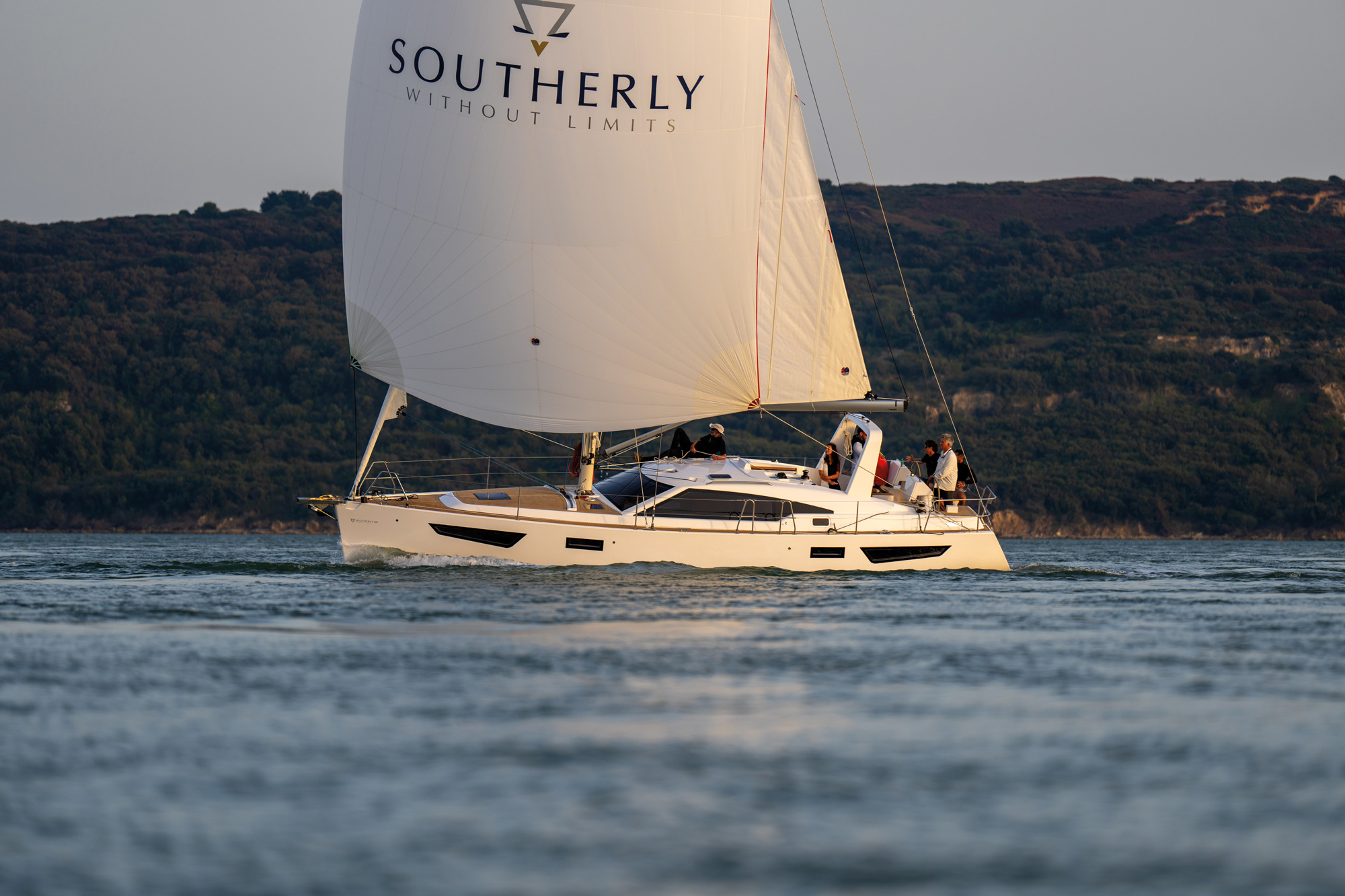
EXPLORE WHERE OTHERS CANNOT
Southerly’s trade mark variable draft keel enables the draft to be reduced to as little as 0.84m (3 feet). The opportunities are endless for accessing and exploring remote anchorages, harbours and inland waterways worldwide, without the draft restrictions imposed on other yachts.
Shallow draft capabilities can save precious time when entering or leaving locked marinas or even crossing a shallow bar in some harbour entrances. When approaching shallow waters, the keel can simply be raised to avoid grounding, and killing time for a safe height of tide.
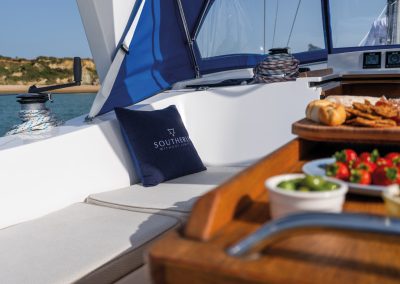
Design Dimensions
Length Overall 13.30 m 42 ft 7 ins
Length Waterline 11.11 m 6 ft 5 ins
Beam 4.03 m 13 ft 3 ins
Draft – Keel Up 0.84 m 2 ft 9 ins
Draft – Keel Down 2.72 m 8 ft 11 ins
Displacement 11,341 kg 25,003 lbs
Ballast Weight 2,100 kg 4,630 lbs
Keel Weight 1,570 kg 3,461 lbs
Total Ballast 3,670 kg 8,091 lbs
Air draft 18.50 m 60 ft 7 ins (not including whips)
Main Sail 44 sq m 477 sq ft
Jib Area 31 sq m 334 sq ft
Optional Code 60 sq m 645 sq ft
Engine Yanmar 57hp
Fuel Capacity 310 L 82 Gal
Water Capacity 325 L Min 86 Gal Min
Download a brochure
Email Address

Professional BoatBuilder Magazine
The rudimentaries of rudders.
By Steve D'Antonio , Jul 12, 2018

Even stoutly constructed rudders are vulnerable to deterioration over time, especially when mild steel or high-carbon-stainless steel is buried in composite foil sections, which inevitably become saturated with seawater.
Like other systems and gear aboard cruising and commercial vessels, rudders have terms to identify their parts and functions. When measuring a rudder, the span and chord are the vertical height and fore-and-aft width, respectively, while the top of portion closest to the hull is referred to as the root , and the bottom is called the tip . Another term frequently used when discussing rudder design, particularly for sailing vessels, is aspect ratio —simply the square of the rudder’s span divided by the rudder’s area. As a rule of thumb, longer, narrower rudders are more efficient than short, wide rudders, and the aspect ratio describes precisely this relationship. Thus, rudders on high-performance sailing vessels are said to have a high-aspect ratio. Walking around a boatyard one day and measuring a few cruising sailboat rudders, I came up with aspect ratios of between 1.7 and 2.1, while one high-performance sailing vessel’s rudder came in at 3.5. The 20-knot semi-displacement lobster yacht’s rudder I measured yielded an even 2.0 aspect ratio, which is considered respectable for this application.
More identifiable rudder components include the stock ; web or armature ; rudderport or log ; stuffing box or compression tube ; bearing ; gudgeon ; and pintle . Not every rudder has all these components.
Rudderstocks
The rudderstock is essentially a shaft or tube that protrudes from the top and sometimes the bottom, depending upon type, of many rudder designs. Because this component provides the primary connection between the rudder’s blade (the flat section that imparts the steering force) and the vessel’s steering system, its design, construction, and material are consequential.
Most stocks are made of stainless steel, bronze, or aluminum, while some are carbon fiber, and they may be solid or hollow. Stainless steel is by far the most common, but it has a penchant for crevice corrosion when exposed to oxygen-depleted water. Insidiously, corrosion nearly always occurs in places where it cannot easily be seen—such as inside many composite (fiberglass and core material) rudder blades and beneath flax-type stuffing-box packing (the problem is exacerbated when the vessel is used infrequently).
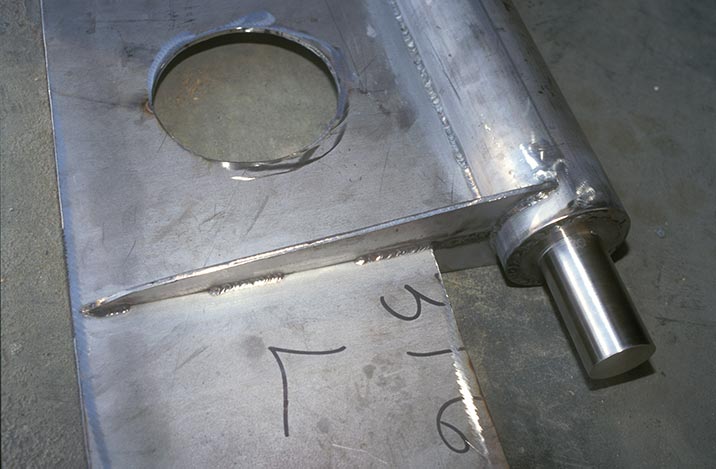
This all-stainless rudderstock and webbing is well crafted and ready to be covered with its composite shell.
Of the stainless steel alloys, some resist this corrosion better than others. Stainless-steel rudderstocks should be manufactured with strong, highly corrosion-resistant proprietary shafting alloys such as A22. The next best choice is 316L stainless steel, which also resists crevice corrosion well. Critically important is the L suffix, meaning “low carbon,” a requirement if it is to be welded, as nearly every rudderstock must be, to the support within composite rudders, or to all-metallic plate-steel rudders. Failure to source low-carbon stainless steel for the stock or the web leads to weld decay, sometimes referred to as carbide precipitation, where the region around the weld loses its resistance to corrosion and rusts when exposed to water.
Aluminum rudderstocks are nearly always tubular. Common on aluminum vessels to reduce the likelihood of galvanic corrosion, aluminum stocks are also relatively common on fiber reinforced plastic (FRP) vessels, particularly large ones. Rudder blades, particularly on aluminum vessels, are often fabricated from aluminum. Of the various aluminum alloys, only a few possess the necessary corrosion-resistance and strength necessary for use as rudderstocks. Of these, the 6000 series, and 6082 in particular—an alloy of aluminum, manganese, and silicon—are popular for this application.
Because aluminum, like stainless steel, suffers from corrosion, it should not be used as stock or web material in composite rudders. Referred to as poultice corrosion, it occurs when aluminum is exposed to oxygen-depleted water. Because oxygen is what allows aluminum to form its tough, corrosion-resistant oxide coating, the metal should never be allowed to remain wet and starved of air as it would be inside a composite rudder blade after water makes its way in around the stock and pintle.
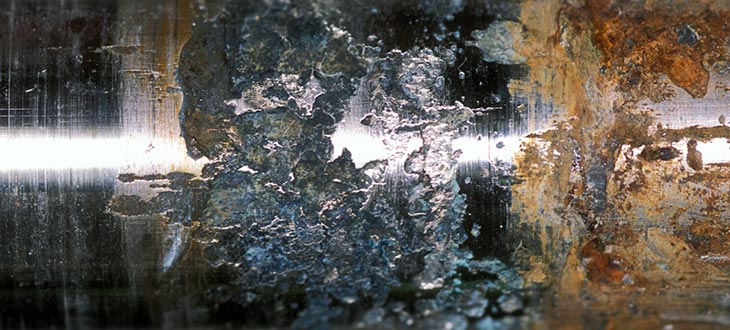
Rudderstock material can corrode in way of the oxygen-starved environment around the packing in a stuffing box.
Bronze, a once popular rudderstock material, is no longer common in today’s production vessels. Although strong and exceptionally corrosion resistant (immune to crevice corrosion), bronze is not easily welded to attach to a rudder’s internal structural webbing, and has thus been supplanted by stainless alloys. Bronze rudderstocks, particularly those that have seen many sea miles, are also known for wearing, or hourglassing, within stuffing boxes, where the flax rides against the stock. If a bronze stock rudder is chronically leaky, disassemble the stuffing box and check for excessive wear. The same is true for stainless and aluminum stocks: chronic leakage is often an indication of corrosion at the packing. Finally, because of their galvanic incompatibility, neither bronze nor copper alloys should be used aboard aluminum vessels for rudderstocks or any other rudder or stuffing box components.
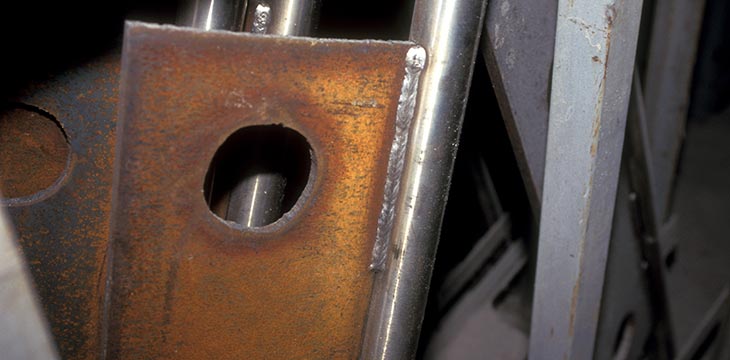
Mild-steel webbing welded to a stainless-steel rudderstock is a recipe for eventual corrosion and failure.
The webbing, or internal metallic support system, in most composite rudders must be strong enough to carry the loads of service and be made of the appropriate material. At one time, many rudders were built using stainless-steel stocks and ordinary, rust-prone mild or carbon-steel webbing. Inadvisably, some still are. The union between a stainless stock and FRP rudder blade is tenuous at best (the two materials expand and contract at different rates) and stainless steel’s slippery surface makes adhesion to the laminate resin a short-lived affair. Once water enters the gap between these two materials, it will reach the webbing and associated welds. Thus, all the materials within this structure must be as corrosion- and water-resistant as possible, and the core material must be closed-cell—often foam—and nonhygroscopic.
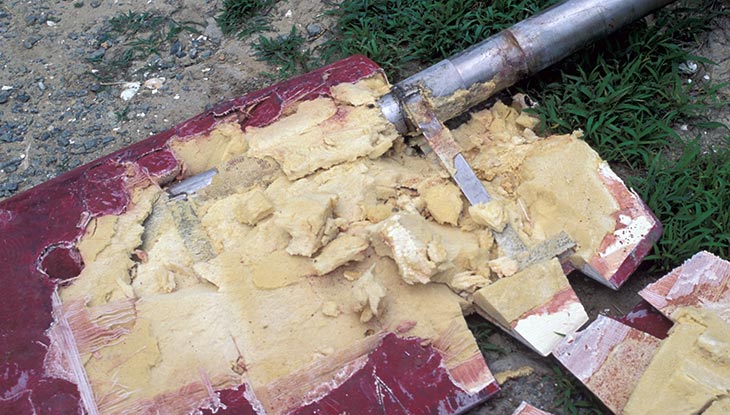
This destroyed foam-core and stainless-steel rudder reveals the conventional construction of such appendages.
Additionally, where possible, the stock should consist of a single section of solid or tubular material; i.e., it should not be sleeved, reduced, or otherwise modified or welded unless done so in an exceptionally robust manner. The webbing must be welded to the stock, but the structure of the stock should not rely on a weld that would experience cyclical, torsional loading.
The webbing in the form of a plate or grid should be welded to the stock with ample horizontal gussets (small wedges welded where the stock and webbing interface), which will reinforce welds 90° to the primary web attachment.
Whether the rudder is spade (supported only at the top) or skeg hung (supported at the top and the bottom), the stock must pass through and be supported by the hull. This is usually accomplished by a component known as a rudder log, or port. In its simplest form it’s a tube or pipe through which the stock passes. Nearly all logs incorporate two other components—a bearing and a stuffing box. The bearing may be as simple as a bronze or nonmetallic bushing or tube inside of which the stock turns; or it may be as complex as a self-aligning roller-bearing carrier that absorbs rudder deflection and prevents binding.
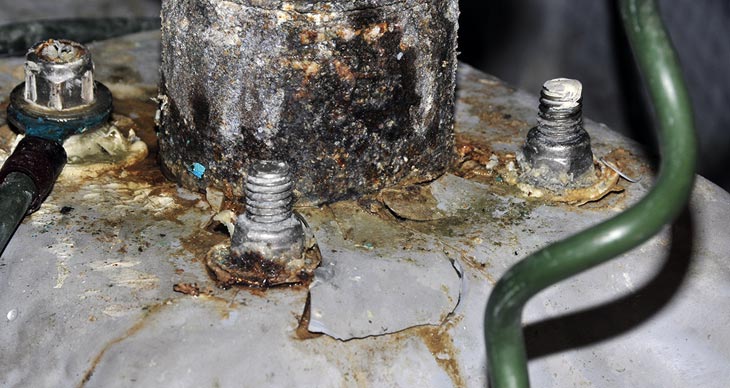
This rudder log is leaking, corroded, and poorly supported, with washers compressing into the backing plate and gelcoat cracking off.
The log transfers tremendous loads and must be exceptionally strong and well bonded to the hull. Fiberglass vessels should rely on a well-tabbed-in purpose-made tube (its filaments are wound and crisscrossed and thus quite strong) that is supported with a series of vertical gussets that distribute the load to the hull’s surrounding structure. On some spade rudder installations, particularly where the log is not, or could not, be long enough, an additional bearing is used at the top of the stock, above the quadrant, where it is supported by the vessel’s deck.
On metal boats the design is similar but with a metal tube welded in place, supported by substantial gussets. For vessels with skeg-hung rudders, the strength of the rudder log is still important. However, because the loads are not imparted by a cantilevered structure, logs used in these applications may be less substantially supported.
Stuffing Box
Unless the rudder log’s upper terminus is well above the waterline or on the weather deck, it is typically equipped with a stuffing box similar to those used for propeller shafts. But unlike a shaft stuffing box, the rudder’s stuffing box shouldn’t leak much, if any, seawater. Because the rudder turns slowly, friction and heat are not a problem. Packing (i.e., waxed-flax packing like that in traditional stuffing boxes) can typically be tight enough to stem all leakage, and lubricating it with heavy water-resistant grease will reduce friction and leakage.
Stuffing boxes that are above the waterline while the vessel is at rest, such as those on many sailboats, are often the most chronically leaky, because the packing tends to dry out and contract. To avoid this, liberally apply grease to the packing material itself; this requires partial disassembly of the stuffing box. Alternatively, a galvanically compatible (316 stainless or Monel for bronze stuffing boxes) grease fitting may be installed and periodically pumped with grease to keep the packing lubricated.
Rudder Bearings

Well-engineered rudder bearings support and lubricate the rudderstock.
Rudder bearings range from the basic rudderstock turning inside a bronze log, to the sophisticated aluminum, stainless, or nonmetallic roller bearings installed in a self-aligning carrier. For most cruising vessels, the choice of bearing is not as important as knowing which type of bearing is in use and its strengths, weaknesses, and maintenance needs. The simple shaft that turns inside a bronze log is durable and reliable but more friction-prone than roller bearings. If lubrication access or a grease fitting is available, it should be pumped with grease periodically, although most rudders rely solely on seawater for lubrication, which is perfectly acceptable.
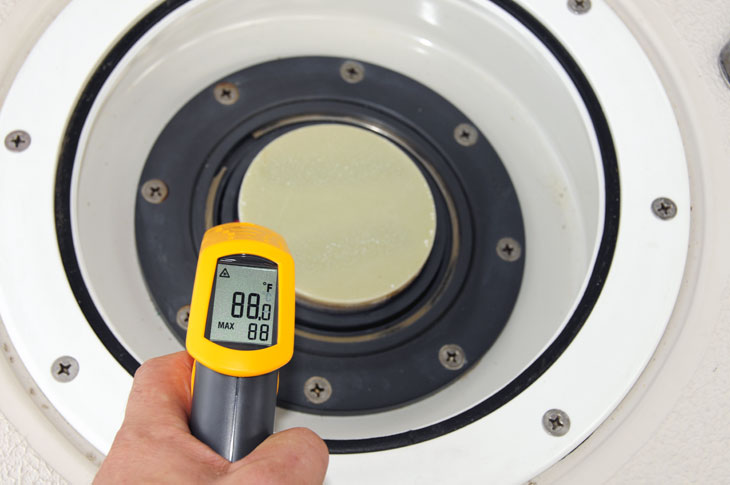
This synthetic upper bearing worked fine in cool temperatures, but when it heated up in the sun, the material expanded and caused binding in system.
Nonmetallic sleeve and roller bearings, often made of ultra high molecular weight polyethylene (UHMWPE), require no maintenance, are extremely slippery, and will not absorb water, an essential attribute for nonmetallic bearings. Delrin and nylon, for instance, will absorb water, expand, and lead to rudder binding. On several high-performance sailing vessels, I’ve had to replace nylon or similar bearings with UHMWPE to restore the steering to its proper specification and effort level.
Propeller Removal
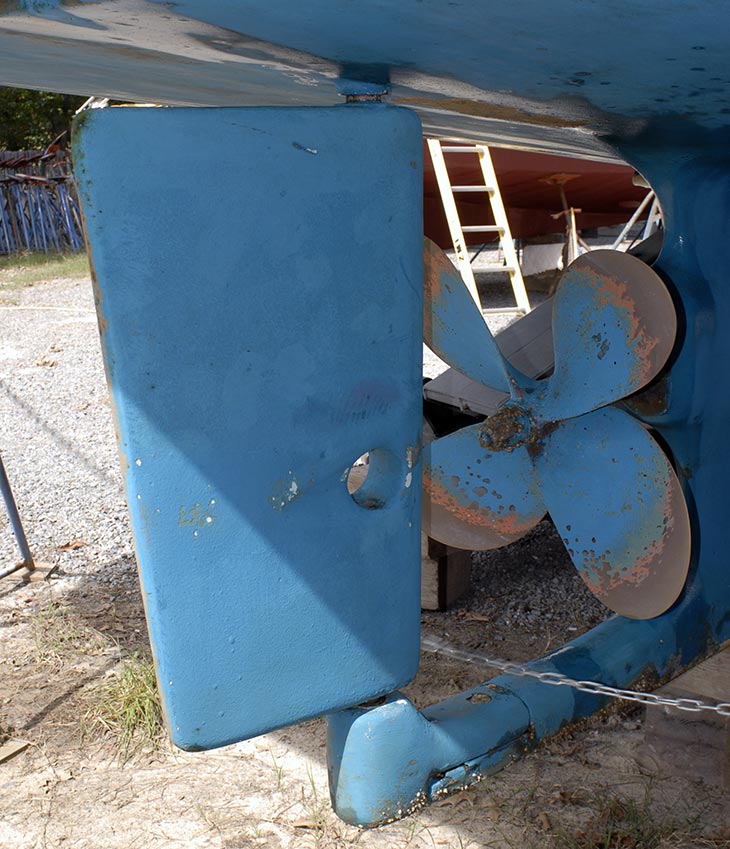
Shaft removal should be possible with the rudder in place. This conventional skeg-hung rudder has a hole to facilitate shaft removal when the rudder is swung hard to port or starboard.
Whether a rudder is a spade or skeg-hung design, it’s important to determine how it will affect the removal of the propeller or the propeller shaft. Is there enough clearance between the shaft’s trailing end and the leading edge of the rudder to allow the propeller to be removed or to use a propeller removal tool? Can the shaft be slid out without removing the rudder? Some rudders are equipped with shaft-removal holes, while others are installed slightly offset from the centerline; or the rudder’s leading edge has an indentation to allow the shaft to be removed. The propeller should be removable without having to unship the rudder. The dimensional rule of thumb calls for clearance of at least the prop’s hub length between the aft end of the shaft and the leading edge of the rudder.
Rudder Stops
The rudder’s movement should be unimpeded as it swings approximately 35° in either direction, making no contact with hull or propeller. Just as important as the rudder travel is how its movement is checked. Other than for the smallest runabouts with jacketed cables, all inboard rudders should rely on hydraulic cylinders to check rudder travel (provided they are designed to do so, and most are) or be equipped with robust stops. Stops must be integral to the hull, supported by substantial tabbing or a welded and through-bolted structure for fiberglass vessels, or by welded angle and shelves for metallic hulls.
About the Author: For many years a full-service yard manager, Steve now works with boatbuilders and owners and others in the industry as Steve D’Antonio Marine Consulting. He is an ABYC-certified Master Technician, and sits on that organization’s Hull and Piping Project Technical Committee. He’s also the technical editor of Professional BoatBuilder .
Read more Repair articles
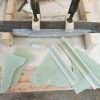
Quick Custom Molds
Making one-off composite parts in the shop.
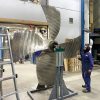
Repairing Bent Props with TrueProp Software
With all the advances in automation and electrification of boat propulsion systems, propellers remain critical to the task of converting power into propulsion. Made of bronze, nickel, aluminum, stainless steel,… Read more »

VacPuc Checks Your Vacuum Bags
It’s possible to monitor houses, cars, cats, and boats by smartphone, so why not check vacuum bags during resin infusion? Now composite technicians have this option with VacPuc, a new… Read more »

Recent Posts
- AIRMAR Achieves World’s First OneNet Product Certification
- Infusing a Workboat Hull with Elium
- Counting Carbon with LCA
- From Langan Design Partners, a Classic Cutter
- Isobel Combines Classic Looks and Modern Tech
- Companies (91)
- Construction (115)
- Design (168)
- Drawing Board (11)
- Education (29)
- Environment (18)
- Events (22)
- Materials (55)
- Obituary (18)
- People/Profiles (49)
- Products (18)
- Propulsion Systems (35)
- Racing (17)
- Repair (37)
- Rovings (326)
- Short Cuts (3)
- Sponsored Partner News (19)
- Systems (80)
- Task Sheet (1)
- Uncategorized (28)
- Wood to Glass (8)
ProBoat.com Archives
- New Sailboats
- Sailboats 21-30ft
- Sailboats 31-35ft
- Sailboats 36-40ft
- Sailboats Over 40ft
- Sailboats Under 21feet
- used_sailboats
- Apps and Computer Programs
- Communications
- Fishfinders
- Handheld Electronics
- Plotters MFDS Rradar
- Wind, Speed & Depth Instruments
- Anchoring Mooring
- Running Rigging
- Sails Canvas
- Standing Rigging
- Diesel Engines
- Off Grid Energy
- Cleaning Waxing
- DIY Projects
- Repair, Tools & Materials
- Spare Parts
- Tools & Gadgets
- Cabin Comfort
- Ventilation
- Footwear Apparel
- Foul Weather Gear
- Mailport & PS Advisor
- Inside Practical Sailor Blog
- Activate My Web Access
- Reset Password
- Customer Service

- Free Newsletter

Mason 33 Used Boat Review

Beneteau 311, Catalina 310 and Hunter 326 Used Boat Comparison

Maine Cat 41 Used Boat Review

Cheoy Lee Clipper 36 & 42 Used Boat Review

Tips From A First “Sail” on the ICW

Tillerpilot Tips and Safety Cautions

Best Crimpers and Strippers for Fixing Marine Electrical Connectors

Thinking Through a Solar Power Installation

Stopping Mainsheet Twist

Working with High-Tech Ropes

Getting a Clue for the Blown-Out Clew

Monel Seizing Wire is Worth the Extra Cost


Fuel Lift Pump: Easy DIY Diesel Fuel System Diagnostic and Repair

Ensuring Safe Shorepower

Sinking? Check Your Stuffing Box

The Rain Catcher’s Guide

Boat Maintenance for the Technically Illiterate: Part 1

Whats the Best Way to Restore Clear Plastic Windows?

Mastering Precision Drilling: How to Use Drill Guides

Giving Bugs the Big Goodbye

Galley Gadgets for the Cruising Sailor

Those Extras you Don’t Need But Love to Have

UV Clothing: Is It Worth the Hype?

Preparing Yourself for Solo Sailing

How to Select Crew for a Passage or Delivery

Preparing A Boat to Sail Solo

On Watch: This 60-Year-Old Hinckley Pilot 35 is Also a Working…

On Watch: America’s Cup

On Watch: All Eyes on Europe Sail Racing

Dear Readers

Chafe Protection for Dock Lines
- Sailboat Reviews
Measuring Performance
What do the numbers tell us about seaworthiness, stability and speed.
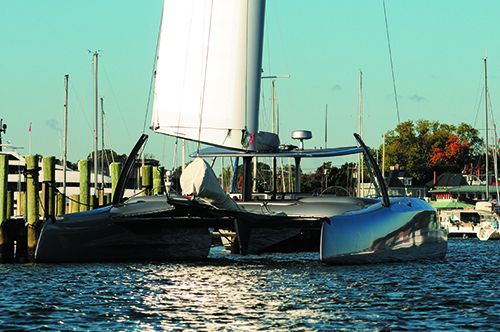
All sailors are performance oriented. It’s only when we delve into the details that differences arise. One-design racers know that their place in the fleet hinges on tactics as well as boat speed. Those racing to Bermuda, Hawaii or even more distant landfalls, discover that a timely finish depends upon boat speed in the fog, in the middle-of-the-night and during light air interludes—not just when everyone is rolling along at hull speed.
A cruiser faces a different quest. Their perspective on performance is shaped by a smaller crew members, more reliance on self-steering gear and a propensity to enjoy the ride rather than shave seconds off each mile. So, when it comes to defining your performance perspective, make sure you and your crew agree on the traffic lane in which you prefer to sail and make sure your boat aids and abets that effort.
Race boat designers are innovators, and when it comes to an empirical approach to yacht design, they and their computers juggle a wide range of variables. Speed under sail isn’t the only frame of reference. At the same time they also have to contend with rating rules meant to penalize what makes a sailboat go fast. The goal is to come up with a design that favors boat speed, safety, sail-handling efficiency and creates a sailboat that’s minimally penalized by the rating rule. At times this “shaped to a rule” approach can lead to some unwanted attributes. In this overview, we will ignore the trend to design to a rating rule and look at the features that make some sailboats much better performers than others.
Our version of performance is more than a singular focus on polar diagrams and boat speed. We agree that good performance needs to be realized in a wide range of wind and sea states. But we also place considerable emphasis on seaworthiness, seakindliness, ease of boat handling and crew comfort. These can be contradictory elements, and which gets most emphasis helps to define the differences among the sailboats being built today.
Boat speed-related features are fairly easy to recognize. For example, most sailors have caught on to the idea that tall rigs, large sail plans and light displacement are more than a subtle promise of speed. Shorter rigs, sprouting from heavy displacement hulls are fine in windy parts of the world. But they don’t deliver much drive in light air. When a yacht broker mentions that, “you don’t need to tuck in a reef until it’s blowing over 25 knots,” take a close look at the rig and the vessels displacement. Then ask yourself if it’s not more likely that delayed sail shortening is really due to a shortfall in sail area? You can also answer the question by working out the sail-area to-displacement ratio following the details below or go online to www.tomdove.com/sailcalc/sailcalc.html . The answer gives you a good idea of the boat’s potential power under sail.
Decades ago, in the heyday of the cruiser/racer, a single design stereotype defined most of the fleet. In those days, the majority of sailboats on Long Island Sound, Tampa Bay or berthed in Marina del Rey slips were white hulled sloops sporting blue mainsail covers. This was an egalitarian era when cruisers raced and racers cruised. The net result was better seamanship. Cruisers could set spinnakers and racers knew how to anchor. Today, sailboats have become more differentiated. The fast, agile, nicely fitted out cruiser/race is still around by much less common. The result is even fewer racers are going cruising. Modern race boat deck layouts make anchoring a gymnastic event and there’s little likelihood that there’s even a properly sized anchor on board. Cruisers are missing out on the seamanship development linked to racing and how it benefits sail handling while cruising.
Yacht design guru Bill Lee, coined the apt phrase “Fast is Fun.” He also recognizes that too fast can be trouble and what defines the latter is often determined by the skill set of the crew. Knowing when and how to shorten sail is a talent every sailor should cultivate. Some put that lesson on hold, and that’s OK as long as they master the art of avoiding challenging situations. This is hard to do and can lead to a lot of anxiety. Plus, it also takes much of the fun out of sailing. It’s better to prepare your boat and her crew to cope with the unexpected. This begins with developing an awareness of the boundary between being reasonably powered up versus being on the edge, about to lose control. It’s not a situation enumerated by a specific boat speed, wind velocity or angle of heel. But as one crusty old Maine coast cruiser put it, ”I can’t say exactly where trouble lies, but you’ll know when you get there.” The best solution is knowing how to depower in a hurry and safely cope with reductions in sail area.

Singlehanders, along with most shorthanded crews, really value the uptick in performance they get from the right gear. It improves efficiency in reefing, setting and dousing sails. Cruisers with an aversion to performance sailing have usually been through too many fire drills. Their version of how much sail area to set is often based upon bad experiences with less than adequate gear. Today’s sailing hardware and furling systems are rugged and reliable, but they still need to be carefully maintained. The crew must also know how to operate the gear in all kinds of conditions—from a midday thunderstorm to a midnight gale.

What to look for
The next time you go to a local boat show, do a little DIY performance profiling. At most shows, you’re likely to run into a full spectrum of sailboat designs. Start with the speedsters and tally up the go fast features. Sail area leads the list and with it comes lower windage, lighter weight rigging and spars—all have benefitted from better engineering and higher modulus materials.
A GZ curve illustrates righting lever. The high peak represents a boat’s maximum righting arm, which is only a part of the overall stability picture.
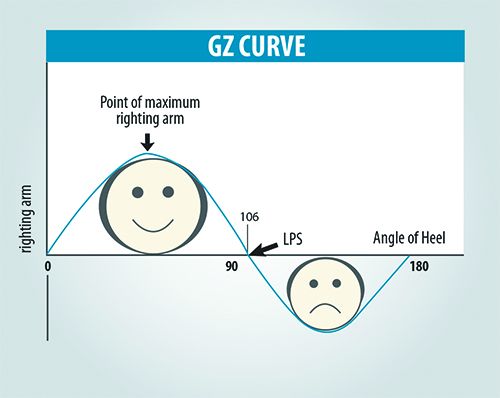
An offshore sailboat should have a limit of positive stability (LPS) (also known as the angle of vanishing stability- AVS) of 120 degrees or more. It is this ability to recover from a deep capsize that’s like money in the bank to every offshore passagemaker.
- The area under the positive portion of the GZ curve should be compared with the area under the negative portion. The higher the ratio between the two, the more seaworthy and less likely a monohull is to capsize and the more likely it will recover from a deep knock down.
- Lowering ballast lowers the CG and increases a vessel’s limit of positive stability. In these examples, three identical 30 footers with the same amount of ballast, but differing keel stub depths, alter their draft and GZ curves. Boat 1 (5’ draft), Boat 2 (6’ draft) and Boat 3 (4’ draft). Note that Boat 3, the shoal draft option, has the lowest LPS and Boat 2, has the deepest draft, highest LPS and will sail to windward better than the other two boats.
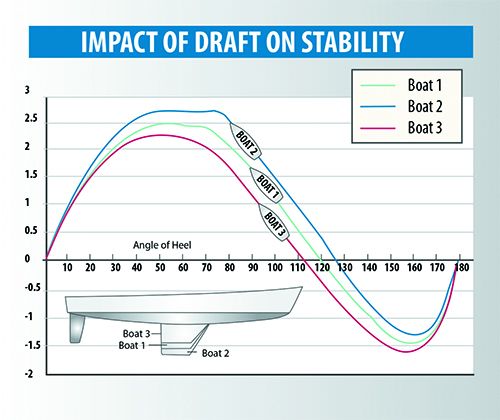
A growing concern among many offshore cruisers has been a trend toward increased beam, diminished draft and a reduction in ballast. Sailing a reach makes these design changes less noticeable, but as soon as you harden up, a performance shortfall comes into play. With less ballast and no one perched on the rail, excessive heel necessitates a reef. In many cases, the shallow draft keel is almost completely hidden as the leeward portion of the hull submerges. This causes the sailboat to slide sideways and every beat to windward becomes a lesson in leeway.
The preference for deep draft is one thing that hasn’t changed too much among race boat designers. Centerboards, dagger boards, drop keels and can’ting keels are also in the mix. And it’s clear that there’s been a downward trend in displacement that fits into the performance-enhancing puzzle. Today, the “less is more” rule prevails. In the 1980s, a race-winning, IMS 40-footer weighed around 18,000 pounds. Now many 40 footers tip the scale at around 10,000 pounds and carry more sail area than their predecessor. The trend flips, however, when it comes to the price tags and sticker shock. It gets quite expensive to shave weight and add speed due to the need for more esoteric materials and aerospace construction skills. The bottom line is how much is it worth to you to add a few tenths of a knot?
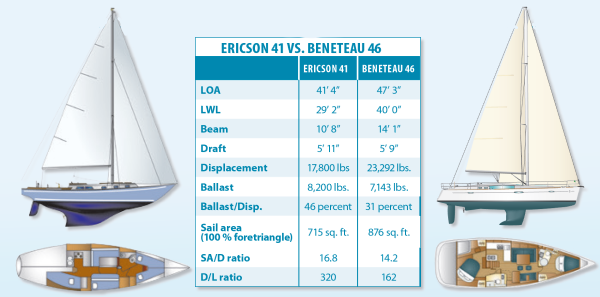
Multihull aficionados continue to assail the logic of lead. Monohull designers are using less but locating it more strategically at the tip of a high aspect ratio foil. This lowers the CG, increasing the righting moment but greatly adds to the stress focused at the keel to hull junction. Keel failures have become enough of an issue that the ISAF Technical Committee has been looking into the problem and they are favoring recommendations that builders increase the hull laminate thickness in the area around the keel attachment. This is a good example of how performance-enhancing features must be considered in the greater context of overall vessel design and construction. Good performance is desirable, staying afloat is essential.
Stability Examined
Righting moment and buoyancy are forces that work together to resist the heel induced by wind pressure on the sail plan. The more sail area, the greater the heeling moment. Multihulls have very high initial stability that’s derived from their wide beam. Monohulls have less initial stability, so when sailing to windward they soon begin to heel over. However, their “ace in the hole” is a highly appreciated attribute called secondary righting moment. It’s derived from ballast and keel geometry.
Multihulls might have been a side show a few decades ago, but they now hold a mainstream role in the sailboat marketplace. Like cruising monohulls, they range from comfortable houseboat like cruisers to absolute speedsters. The latter features more sail area, lighter displacement and much more clearance between the sea surface and the underside of the bridge deck.
Fixed wing masts, C and T foils and all carbon construction can help to juice up the ride. However, the downside to state-of-the-art, aircraft quality carbon fiber construction, seen aboard $7.8 million Fast Forward Composites Eagle 53, can result in serious sticker shock. But the ride says it all, acceleration with the fixed-wing spar is near instantaneous. Time will tell if it’s all just too radical or a full-scale glimpse of what lies ahead.
Displacement/length ratio
I prefer to preview a sail in a new boat by tallying up the numbers. For example, the J/99 is a 32’ J/Boats, Inc racer/cruiser with enough Spartan accommodations below to do some fast passage making. She looked like a double-hander’s delight and with an ISO Cat A rating and the following vital signs, the performance potential is clear:
8,900 lbs. displacement
6.5 ft. draft
11.2 ft. beam
137 limit of positive stability
37 percent ballast ratio
170 D/L ratio
24.1 SA/D ratio
The data indicated an excellent performer in a wide range of wind speeds and the boat lived up to expectations.
For decades, naval architects and yacht designers have been putting complex as well as simple equations to good use. We’ll take a look at a few of the latter and see how they can help to put a more definitive label on specific sailboats.
Displacement length ratio is a comparative tool that allows us to group sailboats into five different performance categories. The ratio itself is a non-dimensional number that defines the relationship between weight and length of a vessel. Most sailboats fall between 100 and 400 on this rating scale. At the low end reside light weight speedsters and at the high end are heavy vessels that need a lot more sail area to attain the performance of vessels toward the lower end of the scale. The D/L ratio is a handy way to empirically make boat-to-boat comparisons.

The equation used in this calculation is based on a vessel weight expressed in long tons (2,240 pounds) and the load waterline length (LWL) measured in feet. Don’t let the math bother you. It can be followed like a recipe and a calculator will insure the accuracy of your arithmetic. D/L = DLT ÷ (0.01 X LWL)3
So, let’s assume we are calculating the D/L ratio of a sailboat with a 32’LWL and 18,000 pounds of displacement:
- Convert displacement (D) in pounds to D in long tons (18,000 ÷ 2,240 = 8.0357)
- Multiply the constant 0.01 times the 32’ LWL (0.01 x 32 = .32)
- Cube the result (.323 = .0328)
- Divide displacement (in long tons) by the modified LWL (8.0357 ÷ .0328 = 245)
- The displacement length ratio is 245 , it lies in the upper half of the moderate category, a highly populated portion of the scale and a region representative of many offshore cruising boats. (Ultralight <90, Light 90 – 180, Moderate 180 – 270, Heavy 270 – 360, Ultraheavy > 360)
When looking at D/L ratios, it’s important to know the trim state of the vessel when it was measured. The weight of fuel, water and a cruising payload will affect the trim. Brochures often provide “light trim” statistics, but “half trim” status is used by most designers and presents a more realistic profile.
Whatever the case, make sure that the boats you compare are all in the same state of trim. The lighter the vessel, the more of an impact a sizeable payload will have. Also recognize that sailboats with no overhang and those with long overhangs skew the ratios in opposite directions. Plumb bowed, long LWL vessels earn lower ratios while long overhangs contribute to higher ratios.
Sail Area/displacement ratio
Sail-area/displacement ratio is a performance-linked statistic that defines potential power under sail. The comparative metrics are vessel displacement and sail area—a sailor’s rendition of an automotive horsepower-to-weight ratio. In this case, sail area is measured in square feet or meters. No attention is given to how efficient or inefficient the hull shape happens to be. In other words, it doesn’t matter if the hull shape looks like the city dock or the underbody of the first to finish in the Newport-to-Bermuda Race. As long as their displacements and working sail area are the same, so will their SA/D ratios. The value of this metric lies in its ability to depict potential power for a given displacement—another useful tool in boat-to-boat evaluations. Solving the equation does involve changing vessel weight into the volume of water it displaces.
Headsail area in the formulae below refers to the working sail area or more specifically (J x I) ÷ 2 = SA (headsail). The mainsail area has become the actual square footage because the large roach (race boats) or the hollow leech (associated with in-mast furling systems) cause simple triangle area calculations to be too inaccurate.
In the following calculation we look at a sailboat that displaces 18,000 pounds and has a working sail area of 750 square feet.
- Convert water volume to weight one cubic foot of salt water = 64 pounds (18,000 ÷ 64 = 281.25)
- Calculate the sail-area displacement using (SA/D = SA sq.ft. ÷ (D cu.ft. ÷ 64)2/3) ( 750 ÷ (281.25)2/3 = 17.44)
- So our SA/D is 17.44, which puts it near the top of good performance. ( <15 under-canvased, 15-18 good performance, 18-20 excellent performance, 20< a handful)
Ballast ratio
Ballast Ratio—is a quick and easy calculation that doesn’t involve long tons or a weight-to-water volume conversion. It’s a simple comparison of weight of ballast to weight of the entire boat calculation, expressed as a percentage. B ratio = (Bwt ÷ Disp) x 100.
Assume an 18,000 pound sailboat has 7,200 pounds of ballast.
B#ratio = (8200 ÷ 18000) x 100 = .40
A 40 percent ballast ratio contributes to a sailboat’s secondary righting moment. How much it contributes,depends on how deep the ballast is placed. The big plus behind a substantial secondary righting moment is that it results in a very small negative portion to the boat’s stability curve. This means that the vessel is much less likely to capsize and quite able to quickly recover from a deep knock down.
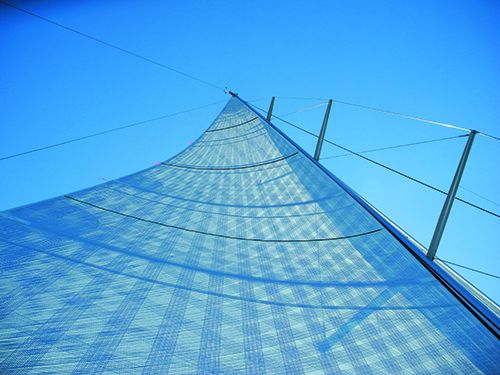
Many naval architects consider a 120°-130° limit of positive (LPS) a minimum for smaller to mid-sized offshore cruising sailboats. This can be accomplished with a high ballast ratio and less draft or a lower ballast ratio and deeper draft. The latter often entails a fin and bulb or anvil shape at the very tip of the keel.
These numbers aren’t SAT scores and higher isn’t better. They should be thought of as a sequel to a compass heading rather than a patient’s vital signs. For those targeting a specific type of sailing—a high latitude ocean crossing, for example—it makes sense to favor a mid-range D/L ratio and the “good performance” range of the SA/D ratio. It’s also important to take a close look at the ballast ratio in conjunction with the boat’s LPS.
Those cruising summer weekends, exploring anchorages close to home, don’t need to lug along as much lead or iron and can look favorably at ballast ratios around 30 percent. However, if it’s a light to ultra-light displacement, a beamy boat with a high SA/D ratio and a shoal-draft keel, beware of a low ballast ratio. This combination means you’ll need lots of friends on the rail when it starts to blow and if you heel beyond the initial righting moment’s sweet spot (around 40-60 degrees) there’s very little secondary righting moment to prevent a knock down.
Multihull sailors put all their eggs in one basket, but it’s a big basket. Extreme beam delivers immense initial stability that peaks around 10-15 degrees of heel. With this powerful heel stopping ability there’s an assumption the secondary righting moment will never be needed. Sailed appropriately, and never caught over canvassed, the initial stability does its job.
However, no multihull designer or builder offers a “can’t be capsized” warranty. Avoiding that outcome is the job of the skipper and crew who must keep careful track of the sail area set, the sea state being encountered and the potential for major fluctuations in wind velocity. Wave face geometry and a changing water plane also affect capsize avoidance. It’s no surprise that the SA/D and D/L ratios of the multihulls in the charter trade are very different than the same ratios calculated for the multihulls that race to Bermuda.
Sailboats, like automobiles, are designed to excel at specific jobs. Just as a Ford F-150 and a Ferrari 488 Spider have decidedly different missions, so does an Island Packet 42 Motor Sailor and a Farr 400. In between these two specialty boats lies a wide range of other sailboats that target a compromise between the two. Sailors, like the boats available, range significantly in how they prefer to spend time on the water.
Hopefully, those seeking to make fast passages end up aboard a boat that can perform up to those standards. And likewise, those out to savor slower meandering and enjoy a comfortable life aboard won’t step below into a cabin lacking head room, festooned with pipe berths, and accessorized with a two burner camping stove and an unenclosed head. The same goes for performance upgrades and making decisions as to whether to invest in light wind sails or add another fuel tank to bump up range under power. Perhaps both.
Contributing Editor Ralph Naranjo is the author of The Art of Seamanship . He is an adjunct lecturer at the Annapolis School of Seamanship.
RELATED ARTICLES MORE FROM AUTHOR
Thanks Ralph a well put together article with very little bias. Very impressive.
Likewise to above. I’ve tried many times to lay this information out for relatively new sailboat buyers and I wish I could do it half as well as Ralph did in this article. Bravo, Matey
Ralph – recheck your math and formula for SA/D…
Not clear if you multiply the entire formula by 2/3 or juts the denominator – either way it does not seem to come out as you show.
Last year, due to delamination and lots of water intrusion, I replaced the ‘barn door’ rudder on my ‘83 Cal 35 with a slightly shorter and more elliptically shaped rudder. There was a noticeable difference in performance and I moved up more than several places in the one race I enter every year.
D/L is not a dimensionless number (it’s dimensions are are long ton / ft3), neither is SA/D (ft2/ton). Nevertheless, the numbers can be useful at least when comparing boats with similar hull shapes.
Some more discussion of the impact of hull shape (i.e. impact of hard chines, impact of location of max beam, amount of buoyancy in bow & stern, etc.) would be meaningful, as (esp the french) modern cruisers and races have dramatically different shapes than 1970s or 80s cruisers and behave quite differently when compared at similar ratios.
Very nice article. I think the confusion about the 2/3 factor is that the denominator is taken to the 2/3 power. So the equation for denominator is (D in pounds / 64)**2/3. I believe the ** or ^ symbol is missing. Again, good overview with excellent examples. Jim
LEAVE A REPLY Cancel reply
Log in to leave a comment
Latest Videos

The Perfect Family Sailboat! Hunter 27-2 – Boat Review

Pettit EZ-Poxy – How to Paint a Boat

The Boat From True Spirit – Sparkman & Stephens

Top 5 Boat Hacks – Boat Maintenance Tips and Tricks
Latest sailboat review.

- Privacy Policy
- Do Not Sell My Personal Information
- Online Account Activation
- Privacy Manager
Yachting Monthly
- Digital edition

Bowsprit power for downwind sailing
- Graham Snook
- December 30, 2020
Bowsprits are all the fashion on new boats these days, but do you need one? Graham Snook looks at how a bowsprit can make your sailing easier and faster

Walk down any marina or boat show pontoon and you could be for thinking there was some sort of nautical jousting competition afoot.
Older yachts too can get in on the act with retrofitted deck-mounted retractable bowsprits, but do you really need one and do they improve performance?
There’s nothing new about bowsprits – sailing ships have been using them for centuries as a means of creating more real estate from which to fly canvas as well as to balance a vessel’s rig – but they are more popular on cruising yachts than ever before.

Permanent bowsprits are often built with integral bow rollers
With advancements in sail-handling technology, a furling spinnaker can now be set up in port by one person and stay rolled up until it’s ready to be used.
At that point, it’s a case of unfurling it, sheeting in, and you have a spinnaker!
Taking it down is almost as easy: ease the sheet and take in on the furling line until the sail is neatly rolled away and perfectly tamed, a feat that would have been unmanageable by a single cruising sailor a few decades ago.
Why so popular?

Older masthead rigs tend to have large overlapping genoas, which are less efficient upwind
Their popularity has mostly been brought about by modern yacht design and the quest for better accommodation.
The IOR rules of the 70s did much to determine hull shape, but the demand for more space and accommodation has changed yachts forever.
One big difference is the rig.
Gone are the stumpy masthead rigs and vast overlapping genoas encouraged by the IOR without penalty, which have been replaced by tall, efficient high aspect ratio rigs.
The increase of popularity in cruising, and the lack of rules constraining it, gave designers a free hand.
Mast sections and materials became lighter and stronger, enabling rigs to go higher.
By moving the mast forward in the boat, it enabled designers to open up the saloon, and by moving the chainplates outboard and attaching them directly to the hull, eliminated the need for tie rods that eat into accommodation, increasing the feeling of space below while also reducing manufacturing costs.
Over the last 15 years bows have become less raked and more vertical.
This change has improved performance as the static waterline length and forward buoyancy in the hull have increased.
On deck, things weren’t as rosy for the cruising yachtsman.
Plumb bows and anchors are not good bedfellows, as anchors seem to be as attracted to them as curious hands are to ‘wet paint’ signs.
In no time there were battle-scarred bows all around the world.
To right this wrong, bow rollers started protruding forward.
Outboard chainplates reduce the loads on the mast and rigging, but to get good windward performance the sheeting angle has to be as small as possible.

Modern high aspect ratio rigs sail better upwind, but lack power off the wind
Clearly this conflicts with an overlapping genoa which has to go outboard of the shrouds.
Leading the sheet through the shrouds improves the sheeting angle, but spreaders still prevent an overlapping genoa from being used.
With the high aspect ratio rigs and the increased ‘I’ measurement (foretriangle height), and a reduction in the J (foretriangle base) jibs went from being 150-130% of the foretriangle down to 110% or less.
Not only did this increase upwind performance with more efficient sail shapes, it also made sail handling easier:
A shorter foot can be tacked faster as half of the sail doesn’t have to be dragged around the front of the mast before being sheeted in – 90% headsails have the advantage that they can also be self-tacking.
This is wonderful when tacking upwind, but in light winds, and when sailing off-wind, you start paying the penalty for reduced sail area.
A narrow headsail loses more power at the head of the sail as the leech falls away and it is increasingly blanketed by the larger mainsail the further off the wind you sail.
This is where bigger off-wind sails became popular and, necessary.

Continues below…

Experts tips for downwind sailing
Download our comprehensive step-by-step guides to using spinnakers and cruising chutes

A Pontos winch could change the way you sail
Basic winch design has changed little since the 1970s, but change is here. Graham Snook travelled to St Malo in…

Monohull or multihull: which is best for blue water?
As former editor of Yachting World, David Glenn has plenty of experience of both monohull and multihull cruising. Here he…
Sails for bowsprits
On older yachts with larger headsails that could be poled out, it was easy to forget the colourful but unruly spinnaker – many kites lived their life under the forward berth, used only when there are crew in abundance or on a perfect day.
Some are put off by the hassle of setting it up, others may have had bad experiences and been put off.
But with many owners opting for a more manageable headsail of 135% – to make tacking easier and reduce the need for early reefing – the lack of sail area is noticeable.
Those with a smaller headsail area, found an easy-to-use downwind sail was needed.
Asymmetric (A-sail) spinnaker

A removable bowsprit creates space for more sail area, and keeps it clear of the genoa
Unlike a symmetrical spinnaker that requires a pole to take the load from the tack and the guy, an asymmetric (A-sail) can simply be flown by attaching the halyard and sheets, with its tack taken to a fixed point forward on the yacht.
With the bow roller now sticking out ahead of the bow it made the perfect location to attach one – although many needed to be reinforced to take the upward load as they were originally designed only for the downward load of the anchor chain.
When furling systems became smaller, by using a single continuous line and the advent of the top-down furler, it sped up the demise of the symmetric spinnaker.
Although symmetrical spinnakers are better for sailing dead downwind, once rigged, a furling asymmetric can be set, gybed and furled by one person, all from the safety and comfort of the cockpit.
The crew no longer had to dance around on a rolling foredeck, wielding a long pole while shouting instructions back to the cockpit – guidance, if needed could be spoken to the person next to you.

A symmetrical spinnaker offers the most sail area for dead downwind, but is more complex to rig

An asymmetric spinnaker has a loose luff and large area for offwind sailing
The downside of furlers is that they are expensive.
However, they are quality bits of kit that enable you to extinguish a sail with the pull of a rope.
The cheaper alternative is a snuffer or sock, but this requires someone to go forward when launching or recovering the sail and it can’t be left in position when not in use.
As bows became more vertical so did pulpits, so a line from the top of the mast could go to the bow roller without fouling the pulpit.
But on many older yachts, that had pulpits inclined forwards, to gain the clearance from the genoa furling drum they needed a bowsprit.
To get the best performance advantage from your sail, the bowsprit needs to protrude forward of the genoa as much as practicable, while still retaining the support needed to take the loads.
Taking it to the maximum
Some yacht designs, notably J-Boats, take this to the maximum with their retractable carbon-fibre bowsprit.
Others, like Fauby, have an inclined bow and have a reinforced raised fitting in the pulpit to take extra sails.
A smaller headsail area (in newer and older yachts) means if you’re trying to sail in less than around 10-12 knots of true wind, it’s time for the engine.
It’s at this time sailing folk of the 1970s would be heaving the large but lightweight ghosting headsail on deck.
Nowadays, we have furling genoas, and changing headsails is usually only performed on racing yachts or during a storm.
This is where we turn to the Code Zero.

A Code Zero has a straight luff and is flatter cut for sailing closer to the wind
A Code Zero is technically a racing sail, but Code Zero-style sails are popping up, as many sailmakers have their take on it and now the moniker covers sails that are usually flown on an internal luff rope, although various sailmakers have followed Elvstrøm’s lead with a cableless Code Zero.
While aimed primarily at the racing market, the lack of a torsion cable around which the sail is furled reduces weight and stowed size, and allows the luff to project further forward when halyard tension is slightly eased.
Code Zero sails are usually lightweight nylon or mylar and are furled and stowed while not in use.
They aren’t intended to live rigged for longer than they are in use.
One exception is Crusader Sails’ Super Zero aimed directly at the cruising market, which is made from laminate cloth and has a UV sacrificial strip material so it can be rigged at the start of your cruise and removed at the end.
Because of the loads and the luff rope within, a Code Zero will often require a bobstay from the end of the sprit to a point just above the knuckle of the bow to help the bow roller or bowsprit take the loads.
How furling asymmetric spinnakers work

Most furling asymmetric systems work in a fashion known as a top-down furling.
A shallow furling drum that accepts a continuous line is attached to the bow or bowsprit.
On top of the drum is a swivel to which the tack of the sail attaches; this swivel can rotate independently of the drum.
The furling drum is fixed to a torsion rope (one designed not to twist), and the head of sail is fixed to the top of this, above which a swivel connects the torsion rope to the halyard.
When the sail is ready to be furled, the sheet is eased and the furling line is pulled and the drum rotates.
Because the tack of the sail is on a swivel the rotating drum does not affect it, but turns the torsion rope, which starts the furl at the top of the sail.
As you continue to pull on the furling line, the sail is wrapped around the torsion rope and tamed from the top down until the whole sail is furled and the furling line can be cleated off.
Often a patch of velcro on the sail’s clew will help prevent the furls unfurling.
The luff of the A-sail has to be short enough not to hang down over the furler, and have a shallow enough draft to allow it to roll away.
Therefore, using an existing asymmetric and converting it to a furling asymmetric may be impossible.
With some furling asymmetric systems, such as Crusader Sails’ ‘Magic Furl’ system, the furling sail is pulled onto the torsion rope by lines attached to the luff of the sail at intervals up the luff.
Pulling the furling rope pulls these grab-lines, wrapping them, and then the sail, around the torsion rope.
Off-wind sail for bowsprits

Asymmetric sails (A-sails) benefit from longer bowsprits – something that has been known in the dinghy and sportsboat world for decades – as it enables them to sail deeper downwind and the sail is less blanketed by the mainsail and has a more usable sail area.
A-sails cover many different styles of loose luff asymmetric spinnakers for use from 60-170° apparent wind angle.
A-sails run from A0 to A6 although as cruisers we tend to just use one – a cruising chute, which is an asymmetric spinnaker with less sail area than its racing counterpart.
Narrower shoulders make it easier to handle when it comes to trimming.
Variations in sails
A-sails vary in fullness; if a sail is cut flatter it’s designed to sail higher to the apparent wind – the deeper the draft the further off the wind the sail can be used.
Sails also vary in size as foot length is typically 1.6-1.8 times the length of the ‘J’ and a percentage of this measurement at a distance halfway up the sail (known as the mid-girth measurement).
Many will have heard of a Code Zero sail; it’s a lightweight genoa for light winds.
Under IRC rules a sail that has a mid-girth measurement 75%, and over, rates as a spinnaker, so technically the Code Zero is a spinnaker but it’s attached to a torsional luff rope that supports the sail so it can be used from around 40-90° off the apparent wind.
They are usually flown on a furler and give extra sail area in light winds – handy if you reduced your genoa’s overlap for easier handling.
Fitting a bowsprit

If you want to add a furling headsail on a boat that does not have attachment points ahead of the forestay, you may need to fit a retractable bowsprit.
This will also give the advantage of creating space for more sail area.
I did exactly this on my Sadler 32 . Here’s how it’s done…

Sprit length is defined by the distance so the luff rope can clear the pulpit
1. Using the spinnaker halyard, determine the best length for the bowsprit – this is usually decided by your pulpit design.
I could have mounted the bowsprit forward or aft of the forward edge of the pulpit.
I wasn’t keen on the pole being in the pulpit because of the sail’s proximity to my navigation lights
Using the spinnaker halyard, determine the best length for the bowsprit – this is usually decided by your pulpit design.
I wasn’t keen on the pole being in the pulpit because of the sail’s proximity to my navigation lights.

The pole bracket can be deck mounted, or to the side of the bow roller
2. The pole is supported by a circular bracket at its forward end – the bracket can be deck, side or bow roller mounted.
Having a single bow roller (to starboard) it was decided that the pole should exit to port.
The support was bolted to the deck, and access to my anchor locker made access easier.
A spacer was added to raise the pole above my bow fitting.
3. The aft end has a spring-loaded lock that attaches to a padeye on deck (in my case just aft of my anchor locker).
Once the pole is cut to the correct length, the end fittings are drilled and riveted in place.
4. The finished pole is stowed along the guardrail to avoid fouling the anchor locker lid when not in use.
My Sadler 32 required the largest 72mm diameter pole because of its unsupported length forward – thanks to the Sadler’s forward-swept pulpit – and my wish to fly a Code Zero-style sail.
After fitting I installed a Dyneema bobstay to further support the upward forces on the pole.
- 72mm Seldén Pole kit, including end-fitting and pad eyes, £705
- Bow bracket ring £130
- Installation by Crusader Sails from £250

The pole is stowed inside the pulpit

The rigged pole, with bobstay secured through the anchor locker drain holes
- Faster, more enjoyable sailing in light winds
- Less motoring
- Easy to use single-handed
- Pole stowage
- Covers anchor locker when set
- Additional hardware cost
The Seldén bowsprit is easy to install and rig, but less easy to stow.
With a bit of thought, though, this isn’t a problem.
Once, when sailing into a quiet anchorage and going forward to take the anchor out of the anchor locker, I realised I couldn’t because the pole was rigged over the top – I had to de-rig the sail to access the anchor.
It’s a mistake I only made once.
Now if I’m anchoring, I’ll take the anchor out and leave it on the bow roller.
This test is as much about the Magic Zero from Crusader sails as it is the bowsprit.
Sailing single-handed , I think nothing of rigging in the marina and using it on the water.
Comparing performance, my 135% genoa would make 4.5-5 knots (with an apparent wind of 12 knots at 60°), the Magic Zero would take my Sadler 32 to 7 knots.
In light winds, where before I’d have to motor, I can happily coast along at 4 knots with the Magic Zero drawing nicely.
Rarely has a trip gone by in the five years since installing it when I haven’t used it at some point.
About the author

Graham Snook is a photographer and journalist who has been testing yachts and equipment for over 20 years. He cruises a Sadler 32.
For all the latest from the sailing world, follow our social media channels Facebook, Twitter and Instagram .
Have you thought about taking out a subscription to Yachting Monthly magazine?
Subscriptions are available in both print and digital editions through our official online shop Magazines Direct and all postage and delivery costs are included.
- Yachting Monthly is packed with all the information you need to help you get the most from your time on the water.
- Take your seamanship to the next level with tips, advice and skills from our expert skippers and sailors
- Impartial in-depth reviews of the latest yachts and equipment will ensure you buy the best whatever your budget
- If you are looking to cruise away with friends Yachting Monthly will give you plenty of ideas of where to sail and anchor
Messing about in boats since 1975. Online Since 1997.
Home | Intro | Our Design Process | Stock Design Info | Motor Yacht Designs | Sailing Yacht Designs | Prototype Designs Plans List | Articles | Our CAD Design Stream | Maxsurf | News..! | SITE MAP..! | Site Search | Design Team | Contact Us Please see the AVAILABLE BOAT PLANS web page
What's the Ideal Sailing Rig...? Kasten Marine Design, Inc. Copyright 2001 - 2020 Michael Kasten Rig Choice Cat, Sloop; Cutter; Ketch; Schooner... these are the basic configurations. How shall we choose among them? The type of rig is often a pre-ordained choice once one has determined vessel size, the preferred layout, and the maximum size of sail one can handle. While this may seem somewhat heretical at first, there is no arguing the fact that no one wants a mast in the middle of their double berth...! Therefore, if a double berth right forward is a priority, it is likely to rule out the schooner rig on a vessel under around 50 feet. For that layout, we would instead tend toward the ketch or cutter rig. On a fairly small vessel though, we might make excellent use of the Cat rig. How shall we choose? It is always a benefit to windward performance to limit the number of sails. A cutter will perform better for example than a ketch or a schooner due to there being less windage in the rig, in other words less drag, and less turbulence introduced per sail area by the masts. Since lift is important for windward sailing, one might then ask which sails provide the most lift...? The answer to this depends on the sail rig, and on the relative proportion of total sail area given to each sail. Since headsails can be varied, their relative contribution to overall lift can be varied as well. It also tends to be that area for area a headsail will provide more lift than a sail mounted on a mast, mainly due to the turbulence caused by the mast. However that can be mitigated by the use of dual-skinned sails that create a true foil with one sail on each side of the mast, as is done on the Ljungstrom rig. Why would we consider a split rig then? In nearly all cases this choice boils down to the simple question, "What is the maximum size sail you are comfortable handling?" In answering this question honestly, we nearly always discover that on all but the smallest of boats, for general cruising we will probably be better off with a split rig, such as a ketch or schooner. This will serve to limit the size of the main sail for easier sail handling, and still allow a generous overall sail area. It will also give us the benefit of having a rig that is less tall, so better able to be supported. Rather than having a preference for any one rig type, I believe this question will best be answered during the course of developing a design. The rig should naturally be suited to the specific purpose for which the vessel is being developed. The following is intended to shed some light on these questions... Racing or Voyaging...? We know that lift is important when sailing to windward, across the wind on a reach, and possibly as far off as a broad reach, but not so much when sailing directly off the wind. The farther off the wind you sail from 90 degrees, the less important is lift, and the more important is drag. Of additional importance is a vessel's handling and steering behavior. These factors result in two extremes... and a middle path... RACING For racing, it is important to maximize lift and mimimize drag so that windward efficiency is achieved. Given that racing yachts must maximize lift, the aspect ratio of their sails and their keels are designed to be at the maximum that the boat can carry. The more time the boat will spend sailing to windward, the more important its windward performance becomes. Since most races are won / lost on the windward leg, maximizing aspect ratio, and therefore maximizing the amount of lift to drag, that wins the race. However, with many such boats fairly severe handling problems can arise due to the fact that a higher aspect rig exerts a greater turning moment on the vessel as it fills with wind. In other words, the taller mast provides a longer lever with which to turn the boat to windward. The keel does the same, i.e. a deeper keel provides a longer lever with which to resist and augment the windward-turning force of the sails. This tends to make the boat relatively stable to windward, with both forces in balance, but makes the vessel very unwieldy and hard to manage down wind. Along with the enhanced windward performance provided by high aspect sails comes rather poor off-wind performance, therefore the use of big spinnakers on racing boats in order to make up for the poor efficiency of the high aspect sails off the wind. This comes at an additional price in terms of steering stability. Moreover, spinnakers themselves are not so easy to handle, nor so well behaved. Often the boat itself is not optimum for off-wind sailing. For example, the usual wide, shoal body, fat-transom racing type with a deep fin keel and spade rudder will always be unstable downwind, especially when flying a spinnaker, requiring constant attention at the helm. VOYAGING By contrast, since any long distance sailing adventure will be specifically planned to take advantage of following winds, or at the very least to make use of favorable winds, if a vessel’s design is to be optimized for sailing with the wind, the aspect ratio should be reduced. In fact, the best sail rig for off-wind voyaging is the square rig, with an aspect ratio of one. In combination with the low aspect sail rig, the keel should also be low aspect, i.e. long, spread out, and not too deep. This is for the sake of steering stability; to match the aspect ratio of the sails; and so the boat is not so easily tripped by its keel and rolled over in a beam sea. Although this combination is perfect for running in the trade winds for weeks on end, it can hardly be recommended for sailing well to windward... MODERATION Naturally, no modern sailing vessel ALWAYS sails off the wind even if it will be primarily used for voyaging. Neither extreme is appropriate, therefore a compromise is needed. If a boat is to be optimized for all-around sailing, including voyaging , it makes no sense whatever to provide the kind of high aspect rig optimized to win a round-the-buoys race. Nor does it make any sense to do the opposite, i.e. provide a square rig and long shoal keel. The best is somewhere in-between, i.e. with an aspect ratio for the sails on the order of that recommended below. In order to match the aspect ratio of the sail rig, the keel should also be something in-between, thus a cut-away forefoot and reduced wetted area, without becoming too deep, nor too long and shallow. This moderate configuration will provide good efficiency all around, the sails will be less tall and easier to handle, and the hull will be better able to provide the all-important course keeping ability desired for ocean crossings. What About Windward Performance? To reiterate the above, if the keel is very long and shoal, and the rig is similarly low and spread out with gaffs and bowsprits and multiple masts ( say like a mid-1800's US coastal fishing schooner) then provided there is adequate sail area, performance will usually be excellent when reaching or running, but less than optimum to windward. At the opposite extreme (disregarding hull form for now) is a deep high-aspect fin keel, with a tall high-aspect Marconi sloop rig. This type of vessel will ordinarily perform very well to windward, but will be quite inferior on other points of sailing, requiring spinnakers and a sizable inventory of reaching and running sails. As noted above, these are two extremes. Given all that we have learned about windward sailing since the days of old, there is no reason to suffer poor windward performance on any vessel, nor poor off-wind performance necessitating a large sail inventory (read expense and hassle) often accompanied by poor down-wind handling. There is a wide middle ground...! Examples among my designs that have maximized voyaging ability, but still have reasonably good windward ability, are Redpath , and Zephyr , both excellent for voyaging. If one were to take the keel design on those vessels just a few notches farther toward reducing wetted surface, but still good for voyaging, you have a keel configuration like that on Jasmine , with separate keel and combination skeg / rudder. In each of these designs, a modern NACA foil keel and modest aspect rig has been provided for the sake of all around sailing both on and off the wind, and good steering stability. If one were to take this a few steps farther in the direction of windward performance, a configuration like that shown for my prototype design called Sonja makes good sense, in this case having a NACA foil bulb keel and a NACA foil spade rudder. It is worth mentioning that Sonja is not yet a completed design, and when finalized might have a slightly deeper keel, although possibly not. The reason to be equivocal on this point is because the bulb on the keel bottom acts as an “end-plate” effectively doubling the aspect ratio of the keel without having to make it deeper... If it is desired to not have a bowsprit, then in order to achieve adequate sail area the rig must simply become taller yet, and the keel deeper. Quantifying Performance The type of rig one chooses will certainly have an effect on performance, as will the amount of sail area. For maximum performance, there is much benefit to be had with a good hull and keel design, and with well proportioned and well cut sails. We tend to observe many older vessel types which may have neither optimum hull design nor well proportioned sails, and then pass judgment on the type without considering those mitigating factors. Instead, we should look at the components of good cruising performance, and optimize the hull and sails to suit those highly specialized requirements. Aspect Ratio is defined as the height of the sail squared, divided by the area of the sail. A perfectly square sail would have an A/R of 1. A 450 sq. ft. triangular sail with an A/R of 6 would have a 52' luff and a 17' boom. They are both extremes. It is well known that higher aspect sails produce greater lift when close hauled. It not so widely known however that high aspect sails stall much more readily as the angle of attack widens. As A/R gets higher, sails get less and less efficient at pulling when anywhere but close hauled. For racing, where windward performance is of prime importance, it has been shown that an aspect ratio greater than 6 is of little use on monohull racing craft. An appropriate range for optimum windward sailing will be an A/R of from 4 to 6. A polar diagram showing lift vs. drag plotted for sails having the same area but differing aspect ratios very graphically shows that the favored lift / drag position is quickly handed off to shorter and shorter rigs as a sail is eased. If you would like see this data graphically presented, please have a look at the Aero-hydrodynamics of Sailing by Marchaj, p. 444, Fig. 2.138, also shown below... A study of this data shows that the most favorable aspect ratios for ocean cruising, where all-around performance is the goal, an aspect ratio from 2.5 to 3.5 is very appropriate , with an approximate upper limit of around A/R 4. Naturally, these are not "hard" boundaries, only guidelines. In most cases, a compromise is struck in consideration of the times inevitably spent sailing to windward and according to owner preference. In the data presented by Marchaj in the above graph, the angle of incidence of the sail is plotted against lift vs drag. A sail having an A/R of 6 performs exceedingly well at an angle of attack to the apparent wind of 10 degrees, where lift divided by drag (L/D) yields a ratio of around 8.5. At 10 degrees, a sail with A/R 3 has an L/D ratio of 6.5. At 15 degrees, the A/R 6 sail has an L/D ratio of 4.47, and the A/R 3 sail has an L/D ratio of 4.5. At 20 degrees, the A/R 6 sail has an L/D ratio of 2.7, while the A/R 3 sail has an L/D ratio of 3.3, and so forth. By the time an angle of attack of 30 degrees is reached, the favored position is handed off to a sail with an A/R of 1...! Note that A/R as used here refers to the A/R of each individual sail. If the A/R of each sail is, say 3, when adding the sails together the overall height of the rig would not increase, but the overall base dimension WOULD increase, therefore the A/R of the whole rig would be less. The optimum A/R discussed above - and as measured, discussed, and graphed by Marchaj as above - is that of each individual sail. The salient point is that extremely high aspect sails are not "bad" sails, they are just not optimum for general ocean cruising where it is rare to be sailing dead to windward. When required to do so, sails with an A/R of from 3 to 4 will perform quite well, in particular when eased off a few degrees. The benefits of lower aspect sails become much more evident when performing the engineering stunts required to keep an A/R 6 sail's mast from collapsing..! The simpler rigging made possible by lower aspect sails will be its own reward in terms of ease of construction, less rig stress, easier maintenance, and greater rig longevity. Reduced maintenance and greater longevity... the holy grail for cruisers...! Whether using a Bermuda rig, a "Marconi" rig, or a Gaff rig, the above factors encourage keeping aspect ratio of the individual sails under around 3.5 to 4 for an ocean cruising vessel. To see an example of this type of modest Bermuda rig, please check out my Fantom design - a perfect all-around cruising vessel. Rig choice is mainly a matter of assessing one's priorities. If those priorities tend toward racing, then the choices will be quite different than the choices made by a cruising sailor. Keel Profile If the rig is tall and the keel deep, the lever arm will be relatively longer from the center of lateral resistance to the center of effort of the sails, therefore the amount of horizontal lead of the CE forward of the CLR must be proportionately greater to compensate. If on the other hand, the rig is kept fairly low, there will be less draft, and the ideal amount of lead will be much less, even though sail area and stiffness are not reduced. For the best steering and course keeping behavior, and for the greatest overall structural strength, a long full keel offers the most benefit to the long distance cruising sailor. This type of long and relatively shoal draft keel is ideally suited to the lower aspect sail rigs, say up to an aspect ratio of around 3.5. An example is my design Redpath , having relatively shoal draft and generous sail area, yet good sail carrying ability (stiffness). Other examples with similar A/R and keel configuration are Benrogin , Lucille 42 , Lucille 50 , Grace , Zephyr , and Shiraz designs. For the ketch Shiraz , the rig height was limited to 60' off the water for convenience while traveling the ICW along the East Coast, and the draft was limited to 5' - 6" for sailing in the Bahamas. Since Shiraz is an aluminum vessel, there is actually greater sail carrying ability than necessary, so we have the option to give her more sail area, or we may on the other hand choose to keep the rig as-is and assume there will be an extra margin of safety when flying a mule or a spinnaker. Taking the Shiraz a bit further in the direction of windward performance, we might increase the aspect ratio of the mains'l and mizzen, and deepen the keel. At that point, it might be desirable to consider splitting the keel into a deeper portion to contain the ballast, then a shallow portion to contain the shaft alley, then another deeper portion to act as a skeg for the rudder. This would allow a very efficient foil shaped "cruising fin" type of keel, and a similarly efficient combination skeg / rudder combination, while also limiting wetted surface. When the aspect ratio of the sails becomes greater than around 3.5, this kind of long "cruising fin" and skeg hung rudder will usually be preferred. Primarily this choice will be made in order to deepen the keel (and the ballast) but to avoid extra wetted surface. For quick maneuvering, this kind of keel will always be a bit more responsive. The "cruising fin" keel, having a higher aspect ratio and therefore greater lift vs. drag, will naturally have better windward performance than a long and relatively shoal full keel. If not carried to extremes, this will not materially degrade course keeping ability nor the strength of the keel and rudder. Of course when the rig becomes very tall, the keel will become still deeper. Windward performance will be improved, but performance on other points of sail will be degraded, as will course keeping ability. Taken to its logical extreme with deep fin keel and spade rudder, when running in a sea of any size attention to the helm will be critical. This is especially so with fast high aspect sea-going sleds having very fine entries and broad flat sections aft, where lack of attention to the helm may result in an instant broach. While there is no question that this is exhilarating sailing, it can hardly be recommended for safe family cruising... For long passages with the helm unattended, a long and relatively shoal full keel will always be more steady than any other type. For long distance cruising, a longer keel will "track" somewhat more like it is on rails. In harbor, maneuvering turns will have a larger radius. The tactic in that situation is to use a bit of reverse gear to take headway off the boat, then give it a burst in forward gear with the helm over, then another burst in reverse, etc. With that, any full keel boat can be pivoted in her own length. Rather than there being any right or wrong choice, the type of keel profile is a matter of preference, usually based on the type of sailing that is planned. During the design process, once the preferred keel configuration and rig type are chosen, it is simply a matter of balancing them against each other in order to obtain the required lead for the sail area vs the lateral area, and to place the ballast where required for proper trim. Regardless of whether a design is given a long full keel or a "cruising fin" keel, it will benefit performance both on and off the wind to make use of an efficient NACA foil shape. The particular choice of foil type will depend on the keel profile in order to maximize lift, and minimize drag. What About Winged Keels...? Should the cruising sailor consider a winged keel...? An excellent question. The wing keel concept is not brand new. It has come to us as an evolution of various approaches from the past. For long full-keel applications, the idea was promoted by Henry Scheel from the 1960's onward. It became known as the " Scheel Keel " which has the form of a modified "bulb" along the base of the keel. The particular configuration is to widen the base of the keel via a broadly curved keel bottom (athwartships), with a concave return to the body of the keel above. This creates both a large envelope for the ballast down low, without having to increase draft, and also provides an "end plate" to reduce the induced drag from eddy making at the base of the keel foil, effectively increasing the A/R of the keel without having to make it deeper... Among racers, this concept is transformed into a blade with a distinct "bulb" at the base containing the ballast. This serves the same function as the Scheel type of arrangement, i.e. to lower the ballast and to reduce eddy making at the tip of the keel. A few bulb keel examples can be seen on the 96' schooner Zebulun and the 50' ketch Sonja . The further evolution of the simple bulb is a "bulb with wings." Quite a few combinations have been developed, including several that are aimed more at the cruiser / racer types. In moulded fiberglass or cast lead, nearly any shape can be achieved. In metal construction however, one of the basic challenges in order to keep building costs within bounds is to make use of shapes that are both easily fabricated, and that are also efficient in use. For a cruising boat, an additional priority is to create a structure that is sufficiently robust to withstand serious abuse. In metal construction, for the greatest economy of labor during fabrication (i.e. the most bang for the buck) the most reasonable approach is to make use of simple and distinct shapes, rather than "blended" surfaces as would be more typical with fiberglass construction. For metal construction therefore, if a bulb is planned, it will ideally be a distinctly formed shape, attached to another distinctly formed shape, the keel foil. If wings are provided on the ballast bulb, they will also ideally be distinct "appendages" having a long low aspect shape. If a Scheel type of keel bottom is planned, then for ease of construction it will ideally make use of large diameter heavy wall tubing for the bottom shape, and sections of similar tubing for the concave "return" to the keel foil. The cruising sailor empirically observes, " What sticks out, breaks off ." To address that observation, appendages to the hull are approached with an extreme conservatism... With a winged keel, we have added an appendage to an appendage...! I believe an approach such as that taken by Scheel, or possibly a bulb or modest bulb / wing arrangement, will have the greatest merit for the long distance cruiser. The primary requirement is that the boat be able to take the ground and heel right over on the hard without any chance of structural damage, for which the plain keel, the Scheel arrangement or the bulb keel are ideally suited. Is the Gaff Rig Suited to Modern Cruising...? If windward sailing is of paramount importance then of course the Bermuda rig has much to recommend it. For modern day cruising the gaff rig is often maligned. In my view, for blue water voyaging the gaff rig has much to offer. If a vessel's keel is shaped efficiently and if the sails are cut for maximum efficiency on the wind and if the sail plan has been designed well, a gaff rigged boat will perform incredibly well, in many cases besting the performance of a high aspect ratio Marconi rigged boat. This is especially so if one is sailing on any course other than a hard beat to windward. A gaff rig provides the chance to set more sail area on a given length of mast. For a given sail area the mast can be quite a bit shorter, so the mast will be that much stronger and will require less complex rigging to keep it in place. The stiffness of a column is inversely proportional to the square of its length. A mast that is twice as long will fail with only one fourth the load, therefore must be four times stronger. One strategy is to use a heavier mast section. The more typical approach is to divide the mast into several "panels" by the use of spreaders. This is the "Marconi" rig. It introduces more stress, more places for failure, more cost, more maintenance, etc. For racing, this is of course justified. For general cruising however, we can make a good case for keeping things simple and strong. If set up simply, a traditional rig will be friendly and easy to use. For example, one will be handling soft lines rather than harsh stainless wire and winches. If the sails are laced, we will have eliminated sail track and other hardware, along with its relatively much greater expense. This is not to say that one should be old fashioned... far from it! For example, nearly all the masts I specify are welded aluminum tube or pipe. These are perfect for the gaff rig as well as for the low aspect Bermuda rig. Compared strictly on a strength to weight to cost basis, aluminum pipe spars are impossible to improve upon. As further example, among the gaff rigs that I have drawn, one will observe that I prefer short gaffs without tops'ls. Primarily, this is for reasons of simplicity, efficiency, and ease of use. The penalty in excess rigging required for gaff tops'ls is more than I'm usually willing to fool with while sailing. In my experience, due to that added complexity, gaff tops'ls often just sit in their bags unused. In exchange for the added complexity of rigging, gaff tops'ls ordinarily provide little gain in terms of usable sail area. Notes on the Short-Gaff Rig My short-gaff sail plans are meant to address the shortcomings of the traditional types of gaff rig sail plan when used on smaller craft (say under around 60 feet). By using a short gaff with no tops'l, there is more luff length to the sail. With a longer luff on the lowers, the lower sails are able to perform much better when on the wind. As an added bonus, sails are not broken into such small units, so are able to be more efficient on all points of sail. As a further bonus, the short gaff arrangement permits a single halyard to be used with a fixed bridle (not a sliding bridle). With a short gaff there is no need for a separate throat halyard. The bridle legs are balanced during sailing trials, then permanently made fast at the best spot. Luff tension is thereafter adjusted at the gooseneck. As a bonus, the fixed bridle always keeps the gaff in the same attitude while raising and lowering. This works so well that all of the gaff rigs that I’ve specified for yachts under 60 feet on deck have a single halyard for the gaff. While it is possible to do this with a longer gaff, it works best with a short gaff. Certainly larger vessels can use the short gaff and single halyard, provided sails are not too large. As sails become too large to man-handle, a winch can be used for raising sail. Even on much larger sails the short gaff offers the benefit of greatly reduced weight aloft, and an easier job of raising sail. The short gaff - long luff sail is not my invention by any means... In fact, in its ideal form the short-gaff-sail is fairly close in profile to the shape of the fully battened elliptical plan form racing sails of today. The short-gaff rig was developed and was well proven on vessels such as the Dutch sloops, Bermuda sloops, and of course the pilot schooners that sailed out of Baltimore during the 1800's and early 1900's. The pilot schooners needed a foolproof rig that had superior performance, and that could be handled by a man and a boy. They were large vessels...! Applying the same strategy to smaller sailing vessels one can easily single hand a 50 footer. As far as their sailing properties, the improvement in windward performance is well documented among those vessels, and by my own experience having sailed with this arrangement on my own schooner Emerald . The benefits are to simplify the rig, to reduce windage, to reduce the work of raising and lowering sail, to increase luff length for better windward sailing, to reduce weight aloft, and to eliminate those pesky tops’ls. That said, on a schooner I do like to use a fisherman tops’l beetween the masts since it provides enough area to be worthwhile and is easy to set and strike. By comparison, gaff tops’ls are often more trouble than they are worth - another point strongly favoring the "bald headed" gaff rig. What About the Schooner Rig? The schooner is able to spread more sail per length of spars than any other rig. This allows a generous sail area, while the center of effort is kept low down. On a schooner of any size I like to arrange for both main and fore sails to be similarly sized. This is done to prevent the mains'l from becoming too big to handle. To determine the size of each sail, one should try to make use of sails as large as can be confidently handled, and no larger. Much of what is written about schooners and gaff rigs assumes that one will be using a traditional sail plan with long gaffs, two halyards for each gaff, main and fore tops'ls, fisherman tops'l, stays'l, jib, jib tops'l, etc. Added together even on a small schooner, that represents some twenty halyards and other control lines. As an example of how one might simplify that configuration, Lucille and her sisters, Redpath and Benrogin have only four halyards for the lowers, and two for the fisherman tops'l. The total: six halyards... ! Simple is beautiful... Redpath as Example We had the opportunity to sail two 34' schooners having exactly the same hull form and sail area against each other. One vessel had a "traditional" gaff schooner rig, with long gaffs, gaff tops'ls, stays'l and flying jib. The other vessel had a short-gaff rig of my design with exactly the same sail area. One feature of the rig I tend to prefer (as with designs like Redpath) is that the working sails are sized to be as nearly alike in area as possible, so there is no single dominant sail. All of these improvements served to simplify and lighten the rig and provided far less windage. The result...? Although both vessels performed more or less equally on a down wind course, we out sailed the "traditional" rig hands down both reaching and beating. With the short-gaff rig as I modified it, as compared the other vessel of the same hull design (but having a traditional long-gaff rig and gaff tops'ls) we could better their windward performance by around 5 degrees. What I had done is to eliminate the tops'ls and raise the throat of the gaffs up farther, like on Redpath and Lucille. The combination of better windward performance with a simpler, but still classic rig... it is a big success! Another bonus is that the simper short-gaff rig was far easier to build, to handle and to maintain. I liked it so much that I made an identical rig for my own schooner, Emerald . I attribute the improved windward performance to the following factors: Fewer sails, therefore more lift per amount of drag (reach, run or close hauled). Longer luff length on fore and main. Less running rigging and clutter (less than half the number of halyards) so considerably less windage. Flatter cut to the sails in order to maximize windward sailing. Hollow cut to the jib luff to allow for wire sag, so the sail still has good foil shape to windward. Redpath was yet another refinement of the concept, having been designed to take best advantage of the optimum rig right from the beginning. A further refinement on Redpath has been the use of a NACA foil keel. The combination of the improved keel with the taller and more efficient short-gaff rig will provide some 7 to 10 degrees closer sailing tack to tack (the "real" measure of performance) than does a more traditional schooner type having tops'ls, multiple jibs, a nest of extra halyards, and a long straight shoal draft keel. The improvement to windward has been accomplished without sacrificing reaching or running performance, and at the same time whilst improving the vessel's tracking ability on all courses. Redpath is relatively light in terms of displacement to length, and has a high sail area to displacement ratio in her working sails. This not only makes the boat fast, but also makes the rig ultimately easier to deal with, since there are no light weather spinnakers and so forth to fool with. For light weather sailing, the Fisherman Tops'l is kept very well controlled between the two masts, having a line at each corner. If one could say there is any single factor responsible for providing excellent performance on Redpath, it would have to be attributed to the amount of sail area provided. The sail area given to Redpath is able to be generous because it is located relatively low down, rather than on one single tall stick. A Marconi type of rig will ordinarily require a deeper keel for adequate sail carrying ability. One cannot make reasonable comparisons of course to vessels having a fin keel, spade or skeg hung rudder, and sloop rig, as those types will always have superior windward performance. What those keel and rig types give up in terms of off-wind sailing is considerable... Steering stability off-wind is compromised, as is safety in taking the ground, as is the ability to heave to gracefully, etc. The main thing is simply to define the type of sailing one wishes to do. If it is "round the buoy" racing, then shoal draft and low aspect rigs will not be competitive and thus they will be very unsuitable. Nor are they intended to be suited to that type of sailing... It is the windward leg after all that inevitably wins a round the buoys race. For offshore voyaging, relatively more shoal draft and lower aspect rigs will ordinarily make the most sense. Redpath, for example, is designed for fast sailing. On any course from a close reach to a dead run, using only her working sail (not allowing the Fisherman, spinnakers, or any other light weather sails), Redpath simply will walk away from the majority of equally sized Marconi rigged boats. For offshore voyaging one would be hard pressed to do better... Particularly if ruggedness, ease of handling, economy and ease of maintenance are of any import. The Schooner Lucille Image, Copyright 1999 Other Useful Cruising Sails For Schooners: The Fisherman Tops'l On a schooner, the fisherman tops'l is an excellent tool, is easy to use, and provides plenty of area, so is well worth it. The fisherman tops'l is a thing of beauty and highly functional, without a lot of complicated rigging. It's like having overdrive... It's up where it can catch the breeze and it has a meaningful size, so that the reward for setting the fisherman is substantial. Of course, a Fisherman tops'l is not absolutely required, but it is almost silly to do without one on a schooner, given the outstanding opportunity between the masts to spread a large amount of sail without much fuss or bother. For all Sailing Vessels: The Stays'l or "Mule" One might be tempted toward even greater simplicity, eliminating the staysail and outer jib in favor of a single jumbo jib. We can quickly see however that a staysail and jib combination are a bit better suited to offshore sailing, as follows: The most obvious advantage of the stays'l, whether it is on a schooner, ketch or cutter, is to make the individual headsails smaller and easier to handle. A much less apparent advantage is that the stays'l also provides for easy self-steering. A "steering sheet" led from the stays'l boom, aft along the windward side, and then to a tiller will give reliable and easy self steering. It's hard to believe, but this really does work...!! The gaff rig being somewhat lower aspect, lends good self steering to the boat particularly when sailing long passages off the wind. Naturally this statement must be qualified by presuming that the rig is of good design, and that a good hull form for self steering has been provided. You can see example vessels of this type by clicking on the links to the schooners, Lucille and Redpath , and the very fine ketches Grace and Shiraz . For Nearly any Hull Type: The Junk Rig... Along with the Gaff Rig, the Chinese Junk Rig has much to offer in terms of simplicity, ease of use, and also in terms of safety, in particular for the long range voyager. For more information, please have a look at my web page on the Chinese Junk Rig . Choices... Overall, subtleties abound in copious amplitude...! One cannot say one thing absolutely... there exist many shades of grey. A given boat design is neither good nor bad, but instead simply optimized for a given purpose. This includes the full spectrum from the all-out racing machine, to the square rigged clipper. These choices are just a matter of degree; of one's intended sailing; and ultimately of one's preference. One type is not inherently "wrong" or the other inherently "right" but instead are just differing expressions of one's preferred style. Therefore... there really is no argument with regard to keel and rig choices. In the end, the these various design factors are simply a matter of the owner's preferences being expressed in the type of vessel being created. In other words, once you know what you want to do with a boat, i.e. its function , only then do you have a framework within which to create and / or judge its form . Image Copyright 1999 Other Resources... For further reading on self steering, please see the excellent book, "Self Steering for Sailing Craft, " by Dr. John Letcher. For further reading on the gaff rig, please have a look at " Hand, Reef and Steer ," by Tom Cunliffe.
Please see the AVAILABLE BOAT PLANS web page. Home | Intro | Our Design Process | Stock Design Info | Motor Yacht Designs | Sailing Yacht Designs | Prototype Designs Plans List | Articles | Our CAD Design Stream | Maxsurf | News..! | SITE MAP..! | Site Search | Design Team | Contact Us
- All Web Site Graphics, Layout, and Written Content at this Domain Created by Michael Kasten.
- All Graphic and Written Materials at this Domain Copyright © 1989 - 2023 Michael Kasten.
- All Content Registered with US Library of Congress and US Copyright Office.
- Copyright Violations will be Prosecuted. All Rights Reserved.
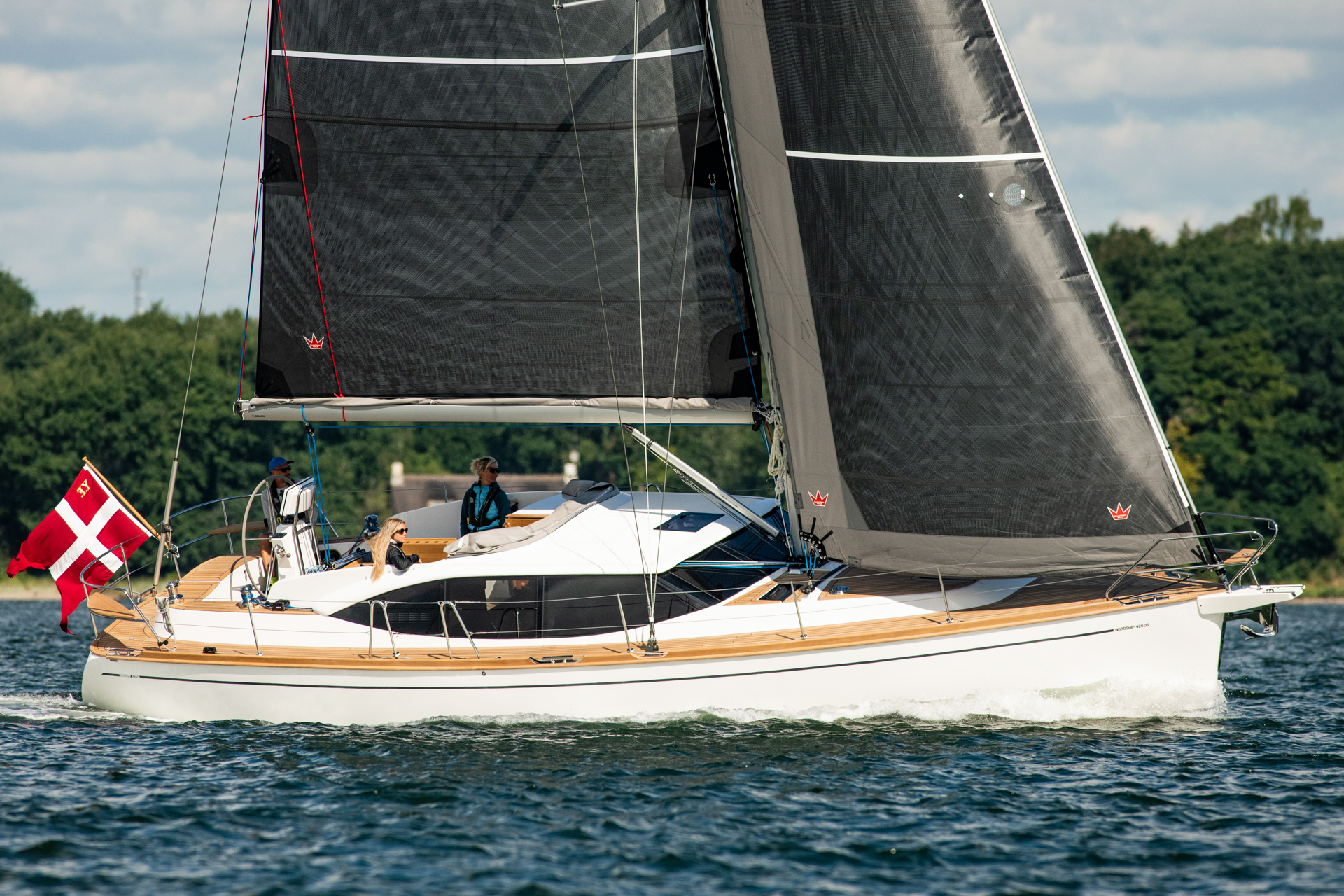
Specification
Many draft options, lifting-keels, twin keels and double rudder
Nordship 420
Our Nordship 420 DS, just like our other models, can be customized to fit to your needs. You get to choose the layout and design that works best for you, whether it be an extra bathroom on board, or an office in place of the fore cabin.
The modern wraparound windows and flush-mounted skylights don’t just provide a clean look to the boat, but they also let in plenty of natural light to the inside.
The standard interior layout includes a spacious deck saloon, which offers seating at a U-shaped sofa around a large dining table on the port side. Here, you get to enjoy the panoramic views. On the same level there’s also a navigation table with place for instruments. On the starboard side, forward from the saloon is a linear galley equipped for long-distance sailing, and with enough storage space to serve six people. The owner’s cabin in the aft is furnished with a large double bed, with easy access from both sides, while the walkway to it is a snug area with many opportunities for customization.
On the deck, the cockpit is divided into 2 sections: a forward part with seating to 6-8 people around a large cockpit table; and an aft cockpit, which houses a mounted steering pedestal with a wheel covered in leather.
Design: Buchwald/Borghegn
Virtual Tour
Grid slide - an ideal interior 1 - 420ds.
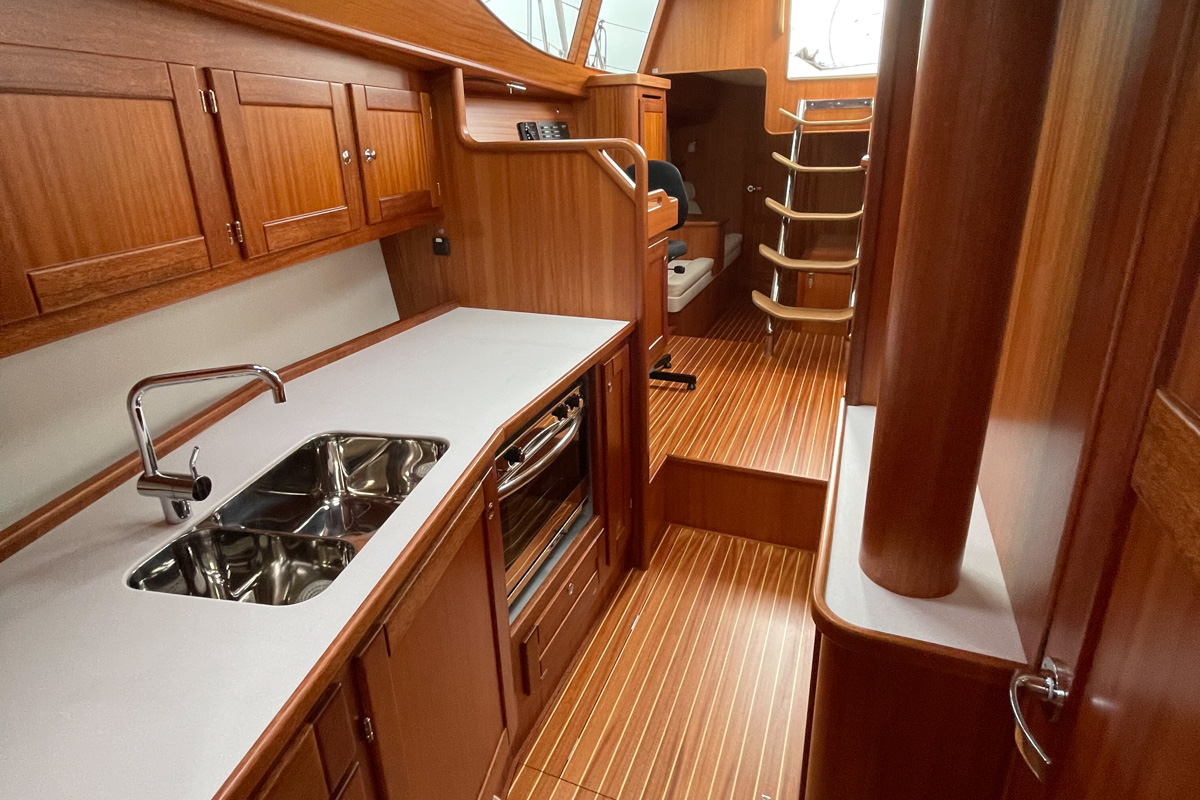
The interior is another area where our yachts excel. Not only are they hand-crafted by highly experienced Danish craftsmen, we can tailor the interior to precisely suit your personal preferences: your choice of layout, your choice of wood, your choice of styling.
Grid slide - An ideal interior 2 - 420DS
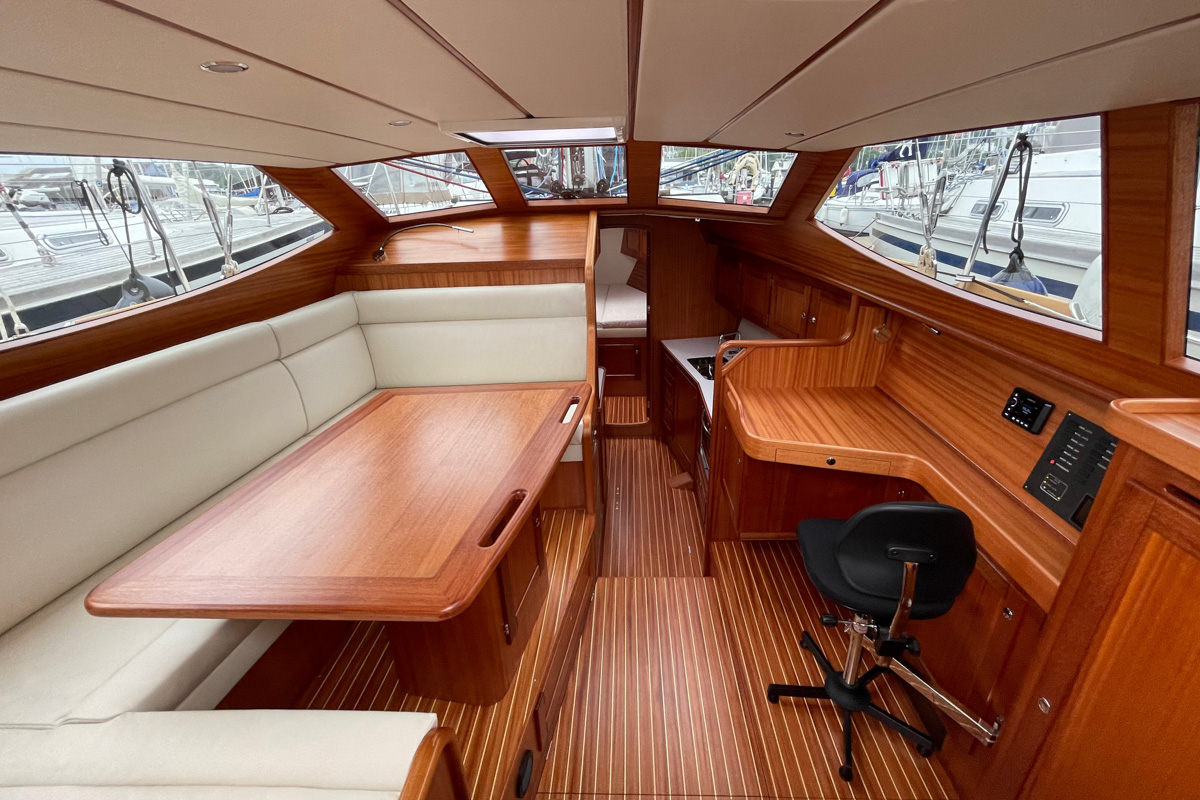
Our raised saloon in the centrepiece of all our yachts. The distinctive large coachroof windows give those inside a great view out, whichever direction they are facing and whatever the weather. You might want to shelter from the sun and its heat or seek warmth and refuge during a cold wet winter’s sail – either way, a Nordship saloon is a wonderful space to relax in.
Grid slide - An ideal interior 3 - 420 DS
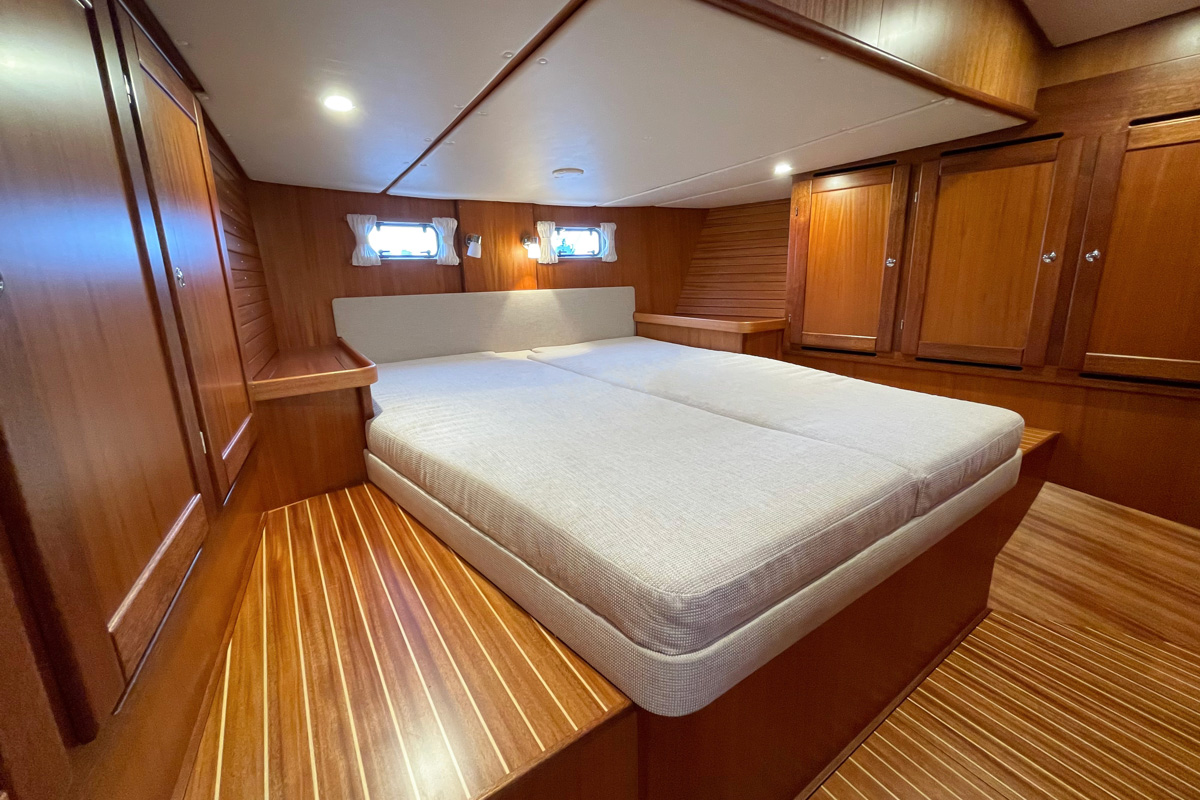
Whether you’re on passage or in harbour, the aft cabin has remarkable living space for the size of yacht. Unlike most other shipyards, we don’t try to cram accommodation for four people under the cockpit. Instead, we give you and your partner space and privacy away from the rest of the crew, with your private en suite toilet and shower compartment available on most models.
Grid slide - sailing qualities 1 - 420 DS
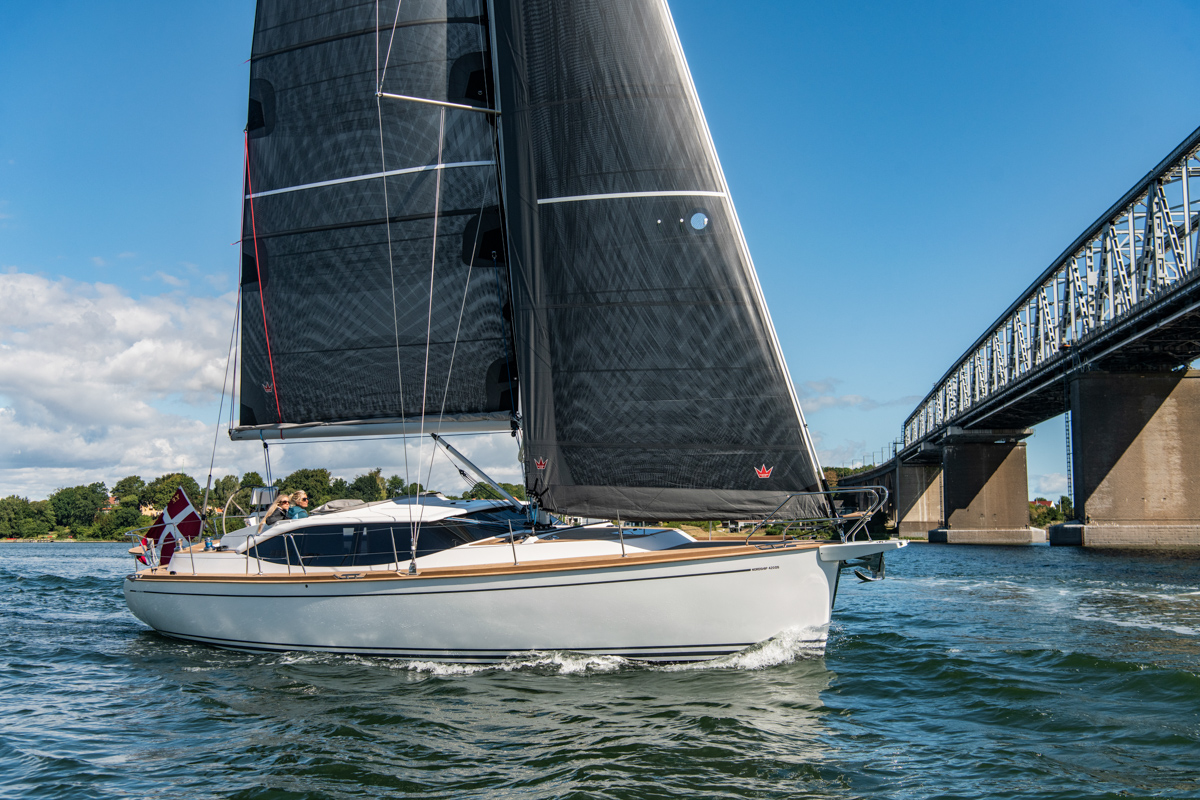
Don’t be fooled into thinking that because our yachts were built for comfort using top-quality materials, they weren’t built to perform well too. The use of a high-aspect ratio rig with a moderate sail area and a sweetly balanced, easily driven hull form with a lead-bulb keel, all Nordship yachts are nimble and rewarding to sail with a healthy turn of speed.
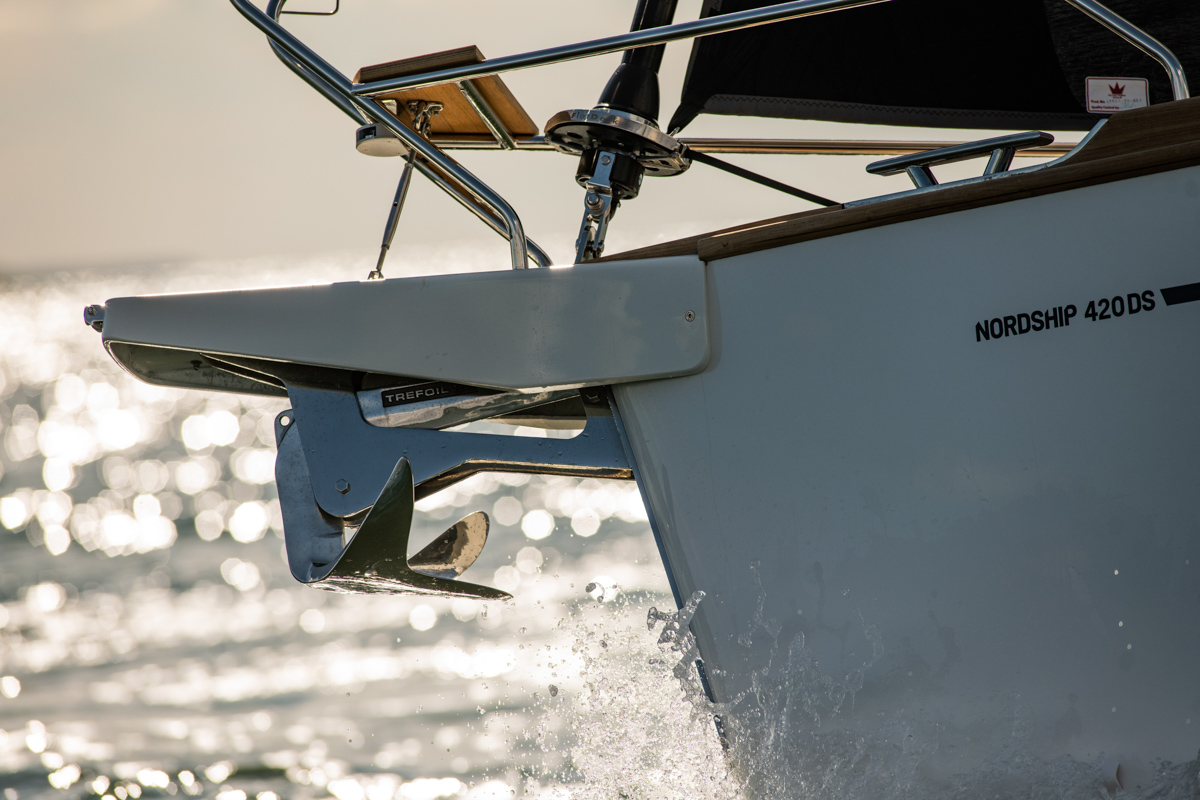
Grid slide - sailing qualities 2 - 420 DS
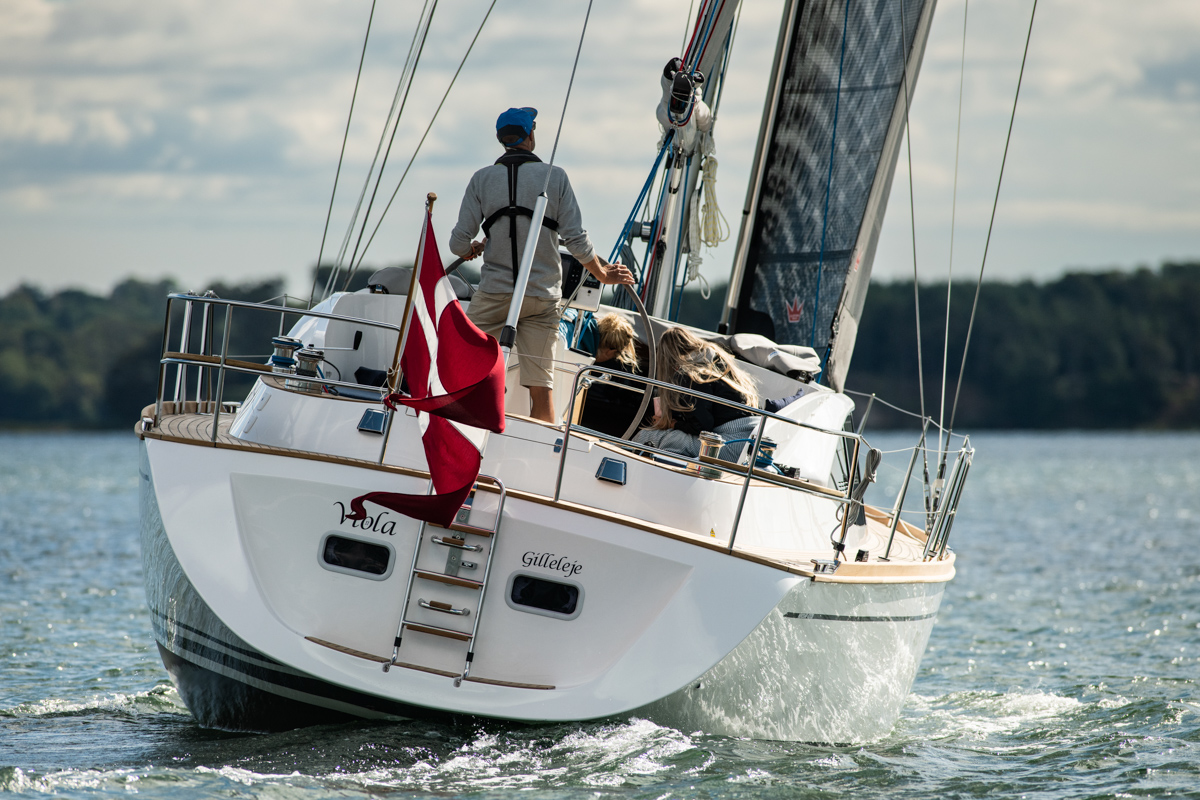
We make sailing easier and more enjoyable by offering a self-tacking jib as standard. This complements the modern high aspect ratio rig perfectly, keeping loads easily manageable whether you’re on deck alone or sailing with a crew.
Grid slide - sailing qualities 3 - 420 DS
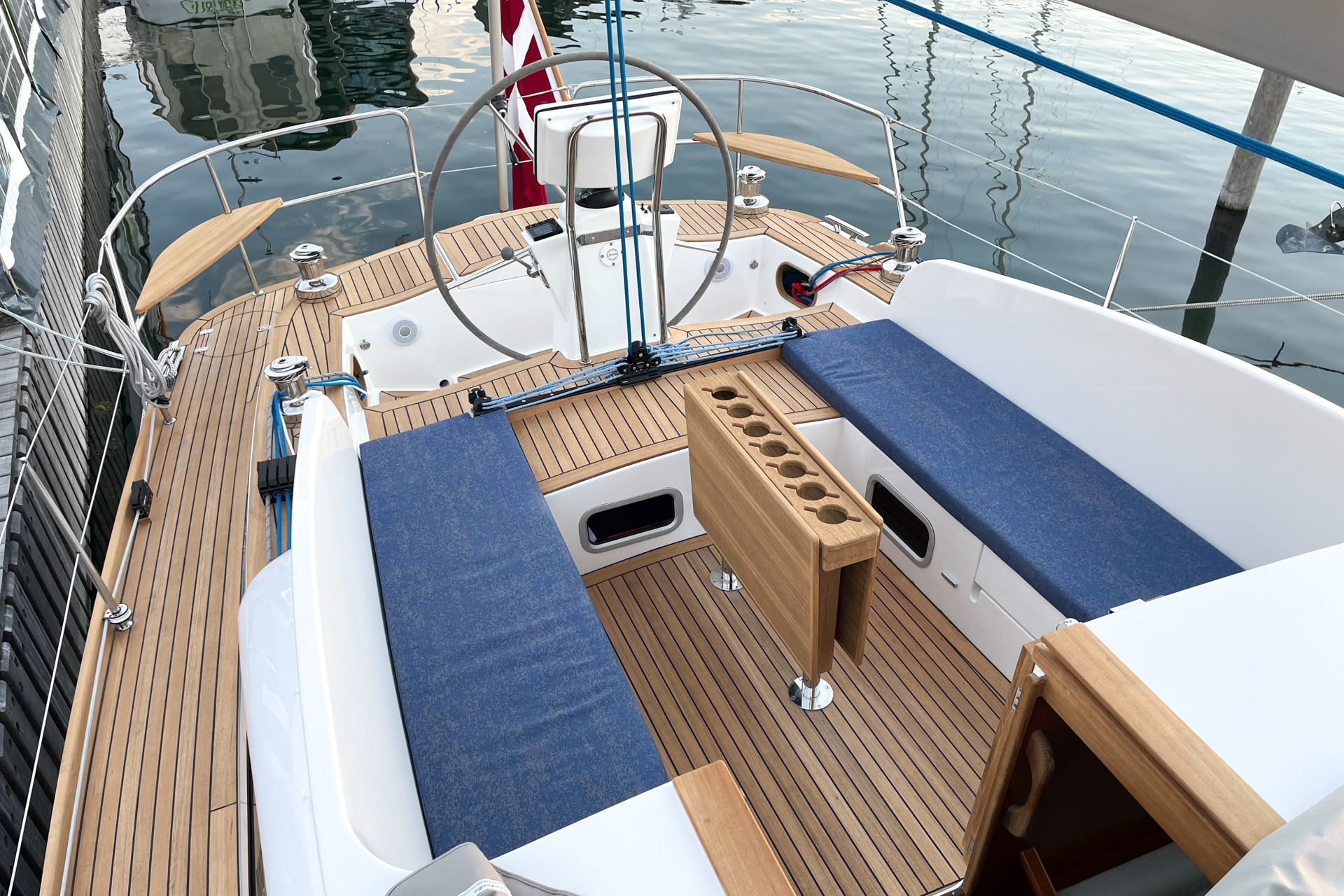
All Nordships are designed around the wheel, so that the helmsman has all the lines from the mast and all sail controls within easy reach. It’s important to us that no lines are led to the aft edge of the coachroof, as they are on many other yachts. With that arrangement, when you’re behind the wheel you can almost guarantee the line that needs adjusting is the one furthest away.
Grid slide - building process 4 - 420DS
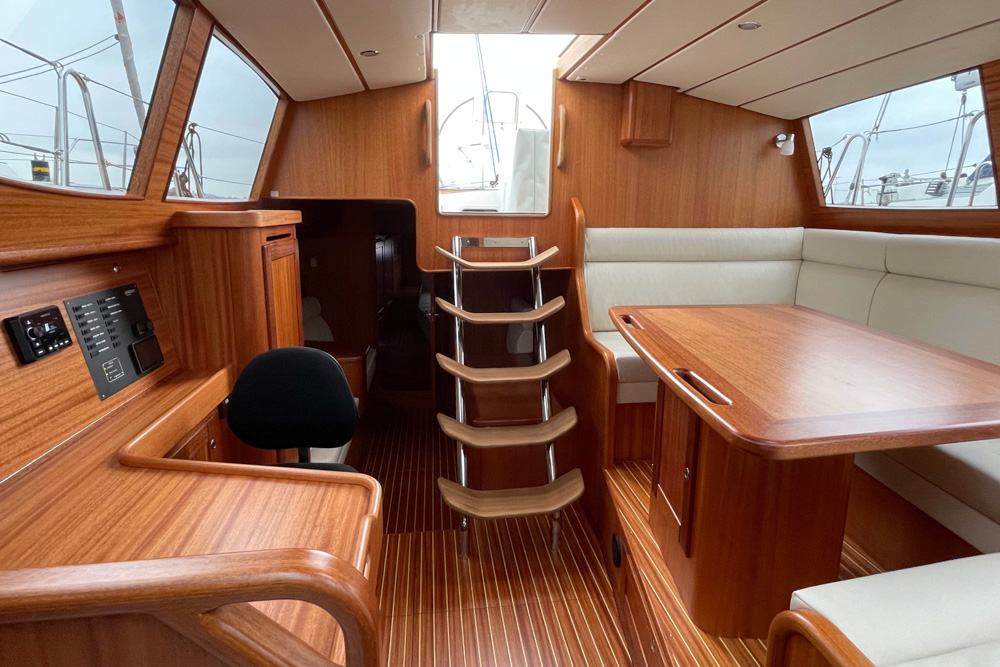
The interior layout is tailored to your personal design. We can incorporate your ideas into one of our recommended layouts, or you can have the interior modified in any way that best suits you.
Grid slide - building process 1
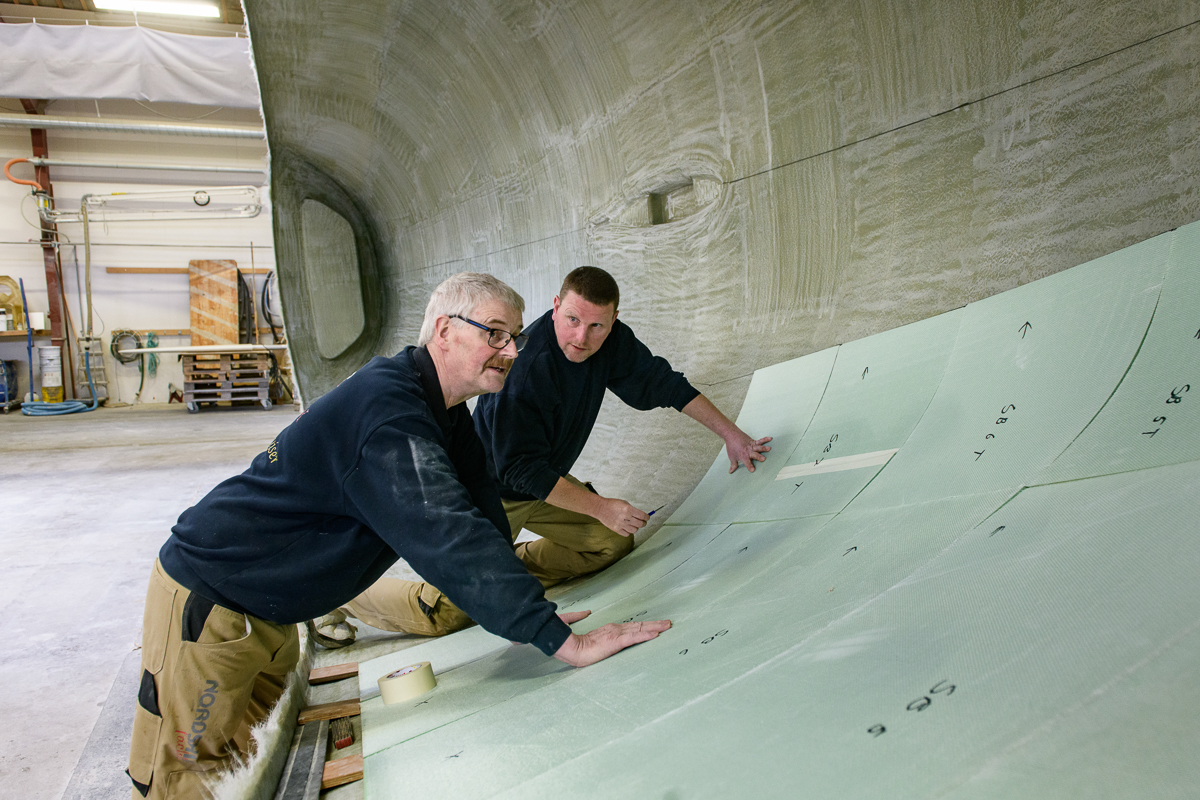
A Nordship yacht can be built to your exact requirements, even down whether you’d prefer to have a balsa or a Divinycell foam core in the hull to save weight and improve strength. Our semi-custom range gives owners free reign to get deeply involved with the design of their yacht, so before the gelcoat touches the mould you know you’ll have the right boat for you.
Grid slide - building process 2
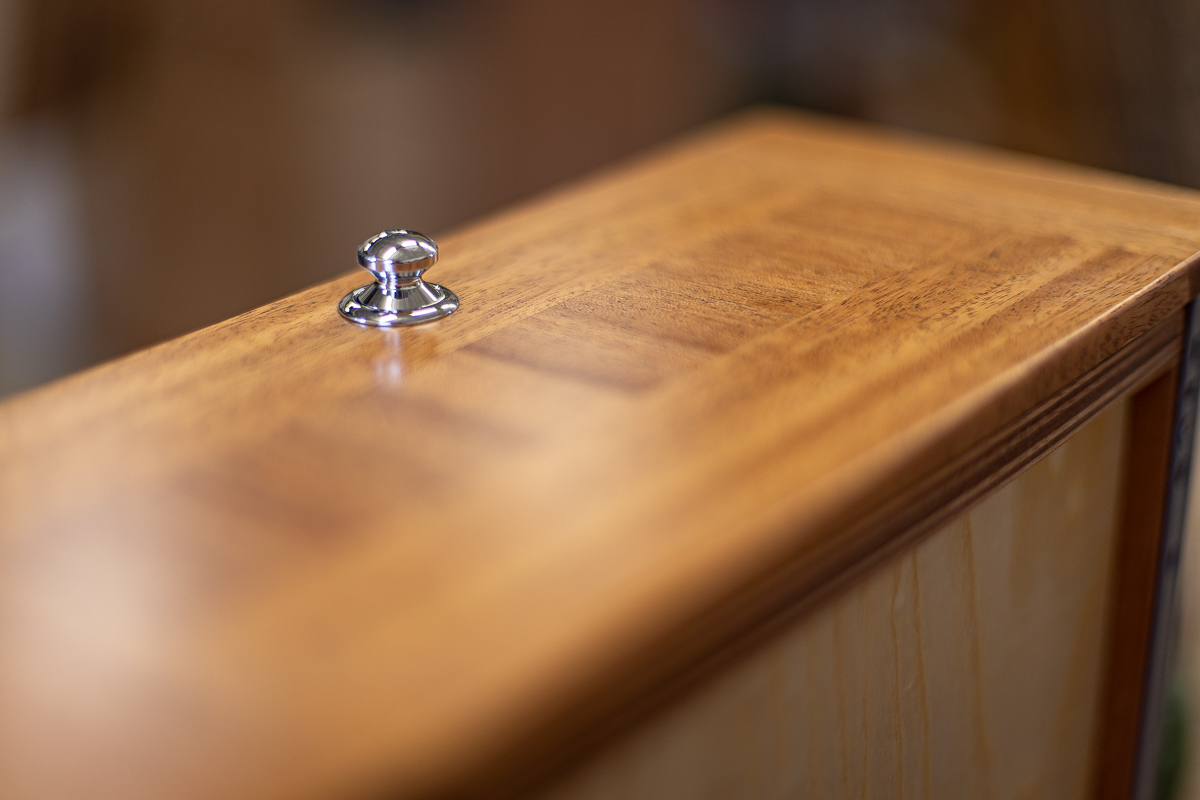
If you prefer even fewer constraints, our Custom Line gives you complete freedom to have the Nordship you’ve always wanted, built just for you. Whichever of our yachts you choose, she’ll be built with levels of passion and the craftsmanship that very few other yards can rival.
Grid slide - Building process 3

To make our boats strong and spread the loads associated with the keel and rig, we use a substantial galvanized steel frame laminated into the hull. But we don’t stop there. Every piece of furniture, bulkhead or seat base that lies against the hull is laminated into position, increasing the hull’s strength and its rigidity.
Please feel free to contact us if you have any questions. We look forward to hearing from you whether you are looking for the right launch, winter storage of your motor boat or maintenance and repair by our specialized craftsman

Thomas Dan Hougaard

Lars Buchwald

- Search forums
- Yachting Monthly's Scuttlebutt
High v Low aspect ratio
- Thread starter BlueSkyNick
- Start date 16 Dec 2007
- 16 Dec 2007
BlueSkyNick
Active member.
Question from YM Jan 08 Quick Quiz: Is an overlapping genoa described as having a high or low aspect ratio? Answer is Low. So, at the risk of being accused of ignorance, what measurements determine the aspect ration, then? And what is the benefit of calculating it?
Twister_Ken
Well-known member.
Height divided by width. The bigger the resulting number, the higher the aspect ratio.
you've got a high aspect outlook, mine's is low except when I'm on a ladder ..
- 17 Dec 2007
With a low aspect ratio, more of the sail is low down so will tend to have less heeling effect than a high aspect ratio sail of the same area. The high aspect ratio sail will be able to make more use of the - slightly - stronger and more stable air flow well above the water surface.
bilbobaggins
Many other things being equal, a relatively High A/R has a greater Lift/Drag Ratio than a relatively Low A/R. See C.A. Marchaj's 'Aero-Hydrodynamics of Sailing Part 1.C' and 'Sailing Theory and Practice' if you have trouble getting off to sleep..... [ QUOTE ] ....the aspect ratio AR has a profound influence on the magnitude of lift generated at a given angle of incidence... AR = Span² / Lateral Area ....With some reservations ( aspect ratio should be considered with taper and twist ) one must agree that high aspect ratio sailplan is more efficient for round-the-buoys racing.... many people question the advantage of a high AR rig in...boats intended solely for cruising. ....Where the close-hauled course is not the most important performance feature and the maximum lift coefficient ( is )..... gaff-headed or even square sails may prove superior.... [/ QUOTE ] Oh, dear! I hope this doesn't degenerate into an 'anchors'-type mud-slinging...... /forums/images/graemlins/smirk.gif
Bajansailor

Very well said! The rest of us with insomnia dont have to resort to Marchaj's bibles now, so we shall just have to remain wide awake.... BTW I met Tony Marchaj once - a fascinating chap. His other well known book is 'Seaworthiness - the forgotten factor' and written in his usual (occasionally controversial) style. Sails are basically aerofoils, rather like aeroplane wings, but unlike aeroplane wings the sails have to operate over a much broader range of angles of attack, from sailing close hauled to broad reaching and running downwind, hence one could perhaps say that they are more complex in many ways. Aeroplane wings have to operate effectively over a relatively small range of angles of attack, with the largest angle probably being when they are taking off. Once this angle starts exceeding about 30 degrees the lift forces start to drop off, and drag forces kick in, until the wing is stalled - rather like putting a rudder hard over (rudders also work most efficiently (re Lift /drag ratio) at smaller angles of attack). And rudders are sometimes equipped with 'fences' and or end-plates in the same fashion as the aeroplane winglets, to help reduce tip losses. Agree with you re these Mini-Transat boats, they really are rather wicked - I would love one too! I think they can consistently turn out over 200 miles a day when sailing hard in the trades - not bad for a 6.5m. waterline.....
True for a rectangular sail, but more generally: Height divided by mean chord and more generally still: Height squared divided by area
jimbaerselman
[ QUOTE ] use is made of so-called NACA wiglets to help control tip losses.... [/ QUOTE ] I like the idea of a little 'wiglet' on the top of the mast. Sound a bit like an anti-static wick. I guess a proper job would have to be gyro stabilised to make sure it didn't add drag when heeled . . . and then there's the extra heeling moment caused by the weight. A nice, expensive America cup project to counter those wiglets attached to the keel. Perhaps, back to the early Spitfire wing would be desirable instead, a neat ellipse, minimising the vortex generating area, rather than relying on twist with all its attendant wetted area drag? What was it called - wing sail? On a Cat to remove the need for gyro stabilising.

The other benefits of using a rectangular/ elliptical / high aspect ration sail is the "lift "is generated in the same relative position - if you think about it the " maximum draft" position on a sail relative to the mast changes as you as you move from the foot of the sail to the head. Hence, the lift moves forward as you go up the mast.
Members online
- Frayed Knot
- franksingleton
- MochiCraft35Fly
- Sticky Fingers
- Chiara’s slave
- justanothersailboat
- PabloPicasso
- Peterclayton68
- Hot Property
- FairweatherDave
- Puffin10032
Share this page

- Forum Listing
- Marketplace
- Advanced Search
- About The Boat
- Sailboat Design and Construction
- SailNet is a forum community dedicated to Sailing enthusiasts. Come join the discussion about sailing, modifications, classifieds, troubleshooting, repairs, reviews, maintenance, and more!
High Aspect keels and 'the groove'...
- Add to quote
David I've moved this (good) question/observation to its own thread to keep the Carbon Cutter thread on-topic. Cheers Ron (Faster) On high aspect ratio keels and "groove".. Here's what I think I know... In general, the higher aspect ratio of a keel, the more efficient it is, but the narrower the steering "groove"/ angle of attack is to realize this efficiency. This requires a more capable driver. My personal experience bears this out.. I used to sail on a 1D35, with a very high aspect ratio keel. When I stumbled into the "groove" it was very fast, but when we weren't there, the boat was embarassingly slower. Conversation with crew on a boat that was in Vic Maui this year validated my observations. The boat also had a high aspect ratio keel, and they had dramatic performance differences based on who was driving. So I guess I have a couple of questions.. 1) Am I generally correct about the relationship between between keel aspect ratio and "groove"? 2) How wide is the "groove" on Francis? I know she's fast, but does she take a highly skilled driver to optimize her speed? 3) Is the groove appreciably wider on a fullish keel boat like the cutters than a typical fin keel? Thanks! David
Re: Bob Perry's Carbon Cutters Denda: Tough questions. I'm hard at it right now. Let me get back to you with my thoughts on that.
Re: Bob Perry's Carbon Cutters Cool... Also hoping for a Jeff_H essay!
djodenda said: Cool... Also hoping for a Jeff_H essay! Click to expand...
djodenda said: On high aspect ratio keels and "groove".. Here's what I think I know... In general, the higher aspect ratio of a keel, the more efficient it is, but the narrower the steering "groove"/ angle of attack is to realize this efficiency. This requires a more capable driver. My personal experience bears this out.. I used to sail on a 1D35, with a very high aspect ratio keel. When I stumbled into the "groove" it was very fast, but when we weren't there, the boat was embarassingly slower. Conversation with crew on a boat that was in Vic Maui this year validated my observations. The boat also had a high aspect ratio keel, and they had dramatic performance differences based on who was driving. So I guess I have a couple of questions.. 1) Am I generally correct about the relationship between between keel aspect ratio and "groove"? 2) How wide is the "groove" on Francis? I know she's fast, but does she take a highly skilled driver to optimize her speed? 3) Is the groove appreciably wider on a fullish keel boat like the cutters than a typical fin keel? Thanks! David Click to expand...
I've moved this discussion to its own thread.. FWIW when our son was racing a Melges 32 he made the same comments, some could drive it, some could not. And when they got it wrong it was 'slow sliding sideways'...
It is god awful easy to pinch a 32. The narrow sheeting angle and high aspect main means you can keep pointing up and the trimmers will follow you, and the telltales look great. But there is no boat speed. It's just like beating on a ULDB no matter what the tell tales say you cannot allow the bow to climb until the boat speed is up. It's actually a lot like sailing downwind with a spinnaker just reversed. You reach down for speed then point up to bleed it away. So long as the speed is there you can hold it very high, but as soon as you slow down the leeway gets awful quick.
Thanks Ron, I recognized the probability this would grow its own legs, good call. I for one welcome the dialog.
Once that attached flow becomes unattached you're done. Maybe just like docking my old Boat with a modified full keel didn't want to blow around during windy marina maneuvers as badly as this one.
This is not a simple question to answer, especially typing on my cell phone. There is no doubt that very high performance foils are harder to trim, whether they are sails, the rudder or the keel. Highly efficient foils are intolerant of inaccurate angles of attack either way. Too flat an angle of attack and there is inadequate lift to do their job, and too steep an angle of attack and they can more easily stall than a less efficient foil. But when you talk about a narrow groove, the reality is that the keel is rarely the problem. Because keels cannot be finely adjusted for angle of attack as a rudder or sails can be, or adjusted for camber, twist or sectional shape as sails can, they are purposefully designed to be especially forgiving relative to the rudder and sails. There are times when the keel is the problem such as when you leave a dock or bungle a tack, and are moving extremely slowly relative the side forces. But those instances rarely occur when sailing in normal winds. As Ron (Faster) alluded, the problem is almost always tied to sail trim. Because modern sails can be trimmed to maintain air flow at wildly flat angles it is way too easy to try to pinch and not realize it and in doing so have speed dramatically drop. Contributing to this issue is that efficient modern designs are much faster in any given true wind speed, and that means that the apparent wind is very far forward compared to earlier designs. With these boats' lower drag and flatter sails they can achieve very high speeds at higher pointing angles. But with the most extreme designs and levels of racing, to achieve that performance the sails have to be changed in adjustment with precision as the boat accelerates and deaccelerates adjusting both angle of attack and camber. That rarely happens with a proper level of precision at more normal levels of skill. This becomes accentuated by the impact of apparent wind. To explain, If the boat decelerates for almost any reason the apparent wind quickly moves to windward and slows in apparent speed, so the sail should be eased until the boat accelerates back to speed. Properly done the sail is flattened again incrementally as the speed returns. What more typically happens is that when the boat slows, the sails suddenly look stalled. The helmsman turns the boat to windward in response. But that results in less drive and additional slowing, so the helmsman turns further upwind and are suddenly on the edge of luffjng. So it is that it is the expanded impact of apparent wind that is what makes the groove so narrow. It is not helped by the fact that flat sails have especially narrow groove. And so while it is true that at some point the keel will not have adequate flow to minimize leeway, but by that point the boat is aiming the wrong way and speed is gone for reasons that are not related to the keel. Jeff
I hardly know where to start here. I think my perspective on this subject may be a bit different than some of yours. I get this feeling that the example boat can be fitted with a variety of keels and rudders, some requiring a lot of attention and others being very forgiving. I don't see it that way. I see each boat individually. The boat that has the thin foils is a racing boat and everything about that boat is aimed at performance. Period! If the boat is hard to keep in the groove, then you get a better helmsman. That's how they get that job. I do not put demanding foils on my cruising boats. In those cases O strive for a forgiving boat. But I give up boat speed. Jeff covers it quite well, as usual.
- ?
- 176K members
Top Contributors this Month
Log in or Sign up
You are using an out of date browser. It may not display this or other websites correctly. You should upgrade or use an alternative browser .
Low Verses High Aspect Ratio Main Sail
Discussion in ' Boat Design ' started by viking north , Feb 5, 2011 .
viking north VINLAND
In planning ahead for my present build which will be sloop rigged, I have to make a decision. Sometime back i purchased a damaged 34ft. wooden sailboat.(Barkhouse motorsailer). It came with a new set of sails(Stevens sails, Chester) The marconi main's 16ft., foot was bolt rope mounted on a 17ft. boom and the 28 ft luff slide mounted on to the mast. Two reef points with 3 battens. Definately Low Aspect. My new build 27 1/2 ft overall length, 71/2 ft beam, Full keel(Brewer bite skeg) will have approx. the same height mast but in alum. not wood. I would much prefer a little higher aspect main, say with a 12ft foot.I would like to make use of this sail but have to make one of two choices. Recut the leach which effectively moves the pocket further aft(maybe not good). or set the boat up for it as it is, wear it out, then re position the mast and re rig for a higher aspect main.(not my preference) While this build will not be in the racing class by no means it still will be fairley good performance as a cruiser/motorsailer goes. I want to get the best out of her. Which lesser of the two evils should i choose, Tnx. Geo. A yacht is not defined by the vessel but by the care and love of her owner.
messabout Senior Member
If you intend to have similar area then the 12 foot foot will need 37+ feet of luff. That is pretty tall for a boat the size that you mention. The tall sail might (operative word might ) go to windward a little better than the shorter sail but probably not better on other points. The shorter sail will need less ballast and thus a lighter ship which will tend to make it faster on all points. For general purpose I would use the sails that you have and watch some of the boats, with high aspect rigs, vanish in your rear view mirror.
Landlubber Senior Member
...horses for courses...what do you want to use the boat for, cruising in "comfort", racing around the bouys, or something in between.....low aspect means far less mast height, leverage requirements, etc etc, so for sailing long term (cruising), i would go for the low.....
PAR Yacht Designer/Builder
The best thing you can do is talk with your sail maker. I know what he's going to say, but he may have some options for you. He'll know what you can "get away" with in regard to cutting up a sail. As far as the rig selection, you need to consider the hull and it's appendages in the equation. You might have a higher aspect rig, but will the hull and appendages be able to do much with them? Making huge changes to gain a couple of degrees of pointing ability isn't what a cruiser, particularly a motor sailor is all about. In most cases the hull just can't take advantage of the loftier rig.
michael pierzga Senior Member
Wind Gradient, sheer, mast height. http://www.onemetre.net/design/Gradient/Gradient.htm
Attached Files:
Gradient1.png.
In this case once again in reverse engineering i can see now i didn't go back far enought to give you guys enought proper info to really get into the subject, but at least now thanks to the education i have and am receiving on this forum i am able to see the error of my ways. First i should have determined if my new build can actually handle the origional sails area without being overburdened. That would take me all the way back to hull shape, Ballast to Disp., then on to Sail area to Disp. ratios. I might have a "given" hull to reverse engineer but from that point on it becomes standard forward engineering of the build.I have all my hull lines taken off but not compiled into standard drawings,(a designer friend now working on this using his computer program).I have keel info,ballast amount,and a final displacement goal, so maybe i can give you enought to get into a little more details.I really don't want to use a 17ft. boom, one reason,i want to attach the mainsheet to the aft. top of the wheelhouse as i have done on other builds.This keeps the cockpit clear with the back of the wheelhouse an ideal spot to hang the coiled up sheets. This attachment point is 8ft.back from the gooseneck and would be impossible on a17ft. boom. Looking over my rough drawings there is a possibility i can accomidate a 14ft. boom. PAR, you have possibly already answered that question on behalf of the sailmaker however if the 14ft. boom is feasible it might put a better light on the picture. Michael, good info, drive, twist, and set on a sail. I didn't realize how big a drop occured in wind pressure per given area occured from the masthead to boom, roughly 50%. Is the 8 deg. windshift typical of all sails regardless of mast height? Ok some specs. on my build and a couple of questions. Some Specs(surfboat to motorsailer conversion) Hull, Surfboat style lifeboat, LOA 27ft. 6in. Beam 7ft. 6in. Shape very similar to a Banger 37 scaled down, double ender fairely symetrical with max. waterline beam just aft. of midships. Low to med. deadrise with a full keel about to be attached. Displacement, completed build, 10,000lbs. min. empty, 12,000lbs loaded. Ballast, 3500 to 4000 lbs. encapsulated automotive wheel weights. Rig, 32ft, alum. mast deck stepped. Boom 14ft. Fore triangle approx. 180sq.ft.(mast approx. 12 ft back from stem head fitting.) Questions: #1 Is it feasible if i use an oversize boom extrusion, ovesized mainsheet tackle, and good strong attachments to the boom and wheelhouse aft, roof frame, that i could use a 14ft boom with the mainsheet attached 8ft. back from the gooseneck and 6ft. overhang back over the cockpit.In other words the attachment point is 6ft. in from the boom end on a 14ft. boom. I've done this before on past builds but the attachment point on the boom was only about 3ft. in from the end. #2 A 14ft. boom would require cutting 3 ft. off the leach at foot and gradually up the leach.This would still effectively move the pocket aft but if in the process i had the sailmaker enhanse the curvature of the leach as much as my backstays would allow and use full battens on the main would i still end up with a decent sail.? #3 I have in my boat fitting collection a new boom roller furling goose neck fitting, whats everyones opinion on this setup.? Thanks again for the info. Geo A yacht is not defined by the vessel but by the care and love of her owner.
FAST FRED Senior Member
For most cruisers about 6-1 Aspect ratio is as much as its worth using. This is the Airodynamic aspect ratio , not the boom to hoist. Span (hoist) squared /divided by sail area . Full battens can improve the performance by getting more of the area higher, with no need to increase the area. FF
Thanks Fred on the advice of the former posts and in order to maintain good stability with my shallower keel, CG, pretty well limits me to a low aspect ratio system which actually once pointed out to me makes sense. My problem was not knowing the dividing line between the two. I now assume that the closest to a sloop rigged heavy cruiser that would have a high aspect ratio sail would fall into the racer cruiser class, which certainly not you typical full keel heavy displacement vessel. De information is slowely penetrating thru capillary action into de rocks in de head. The more i learn the more i realize this boat engineering is a BIG game of trade offs, probably more critical than most other man made moving vehicles.Every majour decision of a design feature boxes you into a place of limited selections and from that thru the process of wise eliminations one ends up with a functioning product. Very challenging field, i think i'm getting hooked Ok so it's low aspect. The next question was can i modify my present sail without destroying it's drive, and possibly as PAR suggested, only a sail maker can answer that 100%, however you have answered one part of it, i can make up for some lost area thru leach curviture and full battens.I might be luckey and meet a sailmaker on the forum to give me a complete overview. The boom question would definately be one for the pro's. There must be a design out there that for reasons had to go with an attahment point this far up the boom. The last question of the boom roller furling, if an acceptiable system, would force me to attach at the end of the boom.Possibly future decisions made by another trade off and on and on it goes, consulting time is accumulating, capitalism is working .... Geo
Gee Viking...modifying a sail is normally a fools game...you modify the shape and reinforcement patterns right out of the sail. Youre best advised to seek a used sail for your application. A big mainsail that you chop the foot off of, not chop the luff and leach were the shape and reinforcements are. The race boats go thru sails like they were toilet paper. Check out the sailing club in Halifax , the big sail makers or a friendly yacht broker. . Pay no more than one cent on the dollar for used raceboat sails. If the sail comes with a nice sail bag throw in an extra 10 bucks. My old sails...still plenty of life left..end up as boat winter covers because no one wants them and I have to PAY to have them disposed. My sailbags get turned into shipyard fender...rubbertire...covers or motorcycle covers. Also consider an entire race boat mast , rigging and sail package. This nice gear often gets thrown in the dump , the local shipyard has a stack of ex race boat rigging, piled up, burning in the sun. .The typical raceboat junk come from trailorable 30 footers that got smashed in a trailer accident with only the sailing gear left When choosing sail power go.... MAX. You can always thrown in a few reefs and back off the power. . The most enjoyable boats to sail are the ones with good performance in light wind. This means a powerful sail plan.
Yes Michael, wish i had the money to do the 100% correct thing but might have to live with 75% efficiency for now. I am looking around for another main but they are not easy to find in good condition at the correct size. Regular guys wear them out then try to sell them.In the part of Canada that i live in money is tight, we live frugal.The lady who made the sail Michelle Stevens (Stevens Sails) is still very much in production so i will get her input. Thought i'd throw it out to the forum, maybe someone else has done the same and i wanted their feedback. Any ideas on the boom question. Is there a production boat out there that has it's main sheet attachment point 40% up the boom length? I am not an engineer but with a given triange of sail area 14ft. boom,(foot) 34 ft mast (30ft)luff that would give 210 sq.ft within the triangle (disregarding) the extra on the curviture on the leach) With a steady say 15kt. wind a certain pressure in lbs per sq. ft would be exerted on the sail resulting in an overall sail pressure of possibly tons. Assuming the boat maintains course, the boom then is the only moving part of the rig that is controlling this force. With the normal attachment point on the end of the boom there should be a way to calculate the bending force exerted on the booms mid section and the force exerted on the goose neck as well as on the main sheet gear and the attachment points. Ok taking it one step further as i want to do and move the mainsheet attachment up the boom 40% of it's length, what happens to the bending forces on the boom extrusion and the force on the mainsheet gear and attachment points. Logic tells me there will be less bending force on the boom along it's length as now the overall lenght is divided but logic also tell me there will be more force on the mainsheet and it's attachment point(the lever has gotten shorter)and resultant shock loads will effectively try to break the boom at the attachment point, as breaking a stick over your knee. So to offset this will i need a stronger boom.(thicker wall or bigger extrusion) What i need to know as i can't find any graphs in any books on this, is #1 What is the origional loads on the main sheet and attachment points and the % of increase by moving the attachment point 40% up the boom. From these info i can determine origional rope and pully size and attachment fittings and with the % of increase step them up to handle the loads. #2 If possible the % of increase in shock loading if significent enought to warrant an increase on boom strength. I realize we are now getting into stress engineering as on aircraft and i don't know if marine architects get into this level of engineering but maybe someone out there can refer me to a set of graphs especially on the mainsheet gear loads. The boom i can take an educated guess at, say 25% increase to be sure. This should open up some good info for me in particular and for all in general, a part of boatbuilding not often discussed( rig stresses). I want to stress this is not a thread for the fun of it, i am not wasting anyones time, I really need this info for the build as you will see in future photos of the build. Thanks everyone--Geo. A yacht is not defined by the vessel but by the love and care of her owner
Tackle arrangements are strictly (and easily) basic engineering 101 and available in most any reference (number of falls, purchase angles, etc.). Wind pressure loads can be estimated with fairly good results (wind pressure coefficients). Loading issues are also fairly easy to track down, such as breaking and working strengths of the various elements. A rough rule of thumb is 250 sq. ft. of sail equals 5 HP in a 12 to 14 knots (14 - 16 MPH) of wind. Naturally, you'll want a reasonable safety margin. You're getting into several different areas of understanding, some simple geometry, some simple math, others, basic engineering and physic principles. None especially hard, unless you're dealing with generics and generalities, on a hypothetical what ever. Rather then educating you, it would be much simpler to just provide the data and have the members crunch the numbers. I know this doesn't help your understand so much, but the problems get solved, which is the goal I would suggest.
mainsheet tackle size verses boom attachment location Thanks for responding PAR was hoping you would. Forget educating me, too old to warrant a return on inversment . As Paul Simons song preaches a one trick pony is just fine but be a good one trick pony.(Mine being a builder.) Just lookin for some feedback on if my idea is feasible attaching 40% up the boom as i really would like to have the mainsheet attached to the wheelhouse tops last roof beam aft where the back wall acts as a super webb to keep it all strong.This keeps it in full view, easy access and the cockpit clear of tackle. If I could get some idea of the increased loading on the mainsheet gear or what the loading would be in comparison to a larger boat, i could simply use that boat tackle as my install. I could just increase evrything by 50% and install it but would that be enought? The numbers i listed in my prev. post re the boom, boom attachment point, sail luff, mast height, and so on are the actual specs. i am working with. I'll do a drawing and post it to give a clearer picture. Tnx. Geo.
I think youre intuitive enough from messing around with boats to understand that when you move the mainsheet forward to mid boom you create bigger loads... several ways to overcome this...best to simply understand the relationship,. For instance a three point boom mainsheet attachment spreads load on the boom . A boom vang properly tensioned also helps. Leeding the mainsheet forward increases loading on the gooseneck .....if you dont want extra loads on the gooseneck...dont leed forward. To avoid overloading the gooseneck, dont dead end reefs on the gooseneck...use the mast wall or mast collar for the tack and boom walls for the leach spreading rigging loads is 90 percent common sense. And once again, be sure to check for discarded masts. Each evening I walk thru the shipyard and use two nice aluminum mast sections as a step bridge to clear a persistent shipyard puddle of water. These spars have been laid flat for years and will soon be sold as scrap aluminium .
purchase.jpg
Michael, a picture is worth a thousand words. It is reassuring that it is possible to do it and designers have actually done it. I like the idea of multible boom bales to spread the load. Do you know the make of this boat maybe it will give me some idea of sheet and block sizes. As suggested by PAR,I am going to do up a scaled drawing of my build that i can scan and post to give everyone and idea of what i am attempting to do and maybe from that everyone can get a better idea of mainsheet tackle size. Just great, thanks Geo. P.S. Stories of masts laying in the mud just breaks my heart, some got and some don't got. A yacht is not determined by the vessel but by the care and love of her owner
- Advertisement:
CaptBill CaptBill
I'm surprised nobody suggested a gaff rig yet.
1999 Lowe Trinidad Suncruiser 240
The Slow Pace of Change
Location of Thru-Hull on Shallow Bilge
Low Maintenance Boat Interiors - Anyone used TEDLAR from DuPont ?
Low power fishing boat project begins..
Catamaran wave pattern from deep to shallow water
Nautica rib jet 10. Plowing, undriveable
Low Aspect Bermuda Rig
I need help figuring this boat out please comment below
Steps for a slower planing hull
- No, create an account now.
- Yes, my password is:
- Forgot your password?


COMMENTS
The M42x Sailing Yacht by Morris Yachts, offers exceptional sailing performance features. Featuring, a carbon fiber rig from Hall Spars, high-performance 3Di sails from North Sails, a deep high aspect ratio fin keel and carbon fiber wheel. The X-Type models redefine what a luxury performance boat can be.
With just a quick hoist, the 7-foot deep-draft foil and bulb keel morphs into a 2-foot, 8-inch gunkholer thats trailerable, a feature that opens up North Americas most appealing cruising destinations. A high-aspect ratio, carbon fiber, tiller-steered rudder can be easily pulled out of its transom-mounted cassette.
Modern high-tech composite materials and rigging allow super-high single-masted sloops that were impossible to build in the old schooner era. ... The enormous height causes vastly more leverage than the same wind striking a "low aspect ratio" sailing rig. At anchor, deck hatches would be open. If the boat is heeled over far enough to put open ...
However, with the help of design ratios, you can not only compare and contrast different designs, but get a pretty good idea, sight unseen, as to how a boat is going to perform under sail. The Beneteau Sense 46 is a typical modern cruising boat, with an SA/D of 19, a Ballast Ratio of 28 percent and a D/L of 159.
On a reach or a run, gaff rigs provide power aplenty. Design expert CA Marchaj also said a low aspect ratio mainsail is more efficient than a high aspect ratio equivalent when sailing off the wind.; if you want to pile on more horsepower in light airs, the space above the gaff can also be filled with a topsail.
"A gaff rigged boat will perform incredibly well, in many cases besting the performance of a high aspect ratio Marconi rigged boat." Michael Kasten at KastenMarine.com; Disadvantages. The gaff rig absolutely has disadvantages as well, and I thought it'd be fair to briefly mention the most important ones below. Windward performance can be subpar
Sailboat Keel Aspect Ratios. This "aspect ratio" is the ratio of the span (depth) squared to the fin area; that is, my extreme fin had an 11-foot span and 44 square feet of area, so its aspect ratio was 121/44, or 2.75. If it had a 4-foot span with 44 square feet of area, not uncommon proportions for a cruising yacht, its aspect ratio would ...
Her low silhouette, near-vertical bow, wide stern, broad beam and high-aspect ratio rig create the very image of a modern high-performance yacht. In fact, with her carbon rig sporting twin masthead backstays as well as runners, and a "fat head" North 3Di mainsail slab-reefed on to her Park Avenue-style boom, Solleone could well be mistaken ...
This unusual-looking French 35-footer is a high-performance yacht that works well fully crewed and short-handed, says Matthew Sheahan. The JPK 1080 is a good example of an appealing and versatile ...
Length Overall 13.30 m 42 ft 7 ins. Length Waterline 11.11 m 6 ft 5 ins. Beam 4.03 m 13 ft 3 ins. Draft - Keel Up 0.84 m 2 ft 9 ins. Draft - Keel Down 2.72 m 8 ft 11 ins. Displacement 11,341 kg 25,003 lbs. Ballast Weight 2,100 kg 4,630 lbs. Keel Weight 1,570 kg 3,461 lbs. Total Ballast 3,670 kg 8,091 lbs. Air draft 18.50 m 60 ft 7 ins (not including whips)
CDI = CL ^ 2 / (Pi * AR) * (1 + Sigma) Sigma = 0 for an elliptical load distribution, and greater than 0 for other load distribution shapes. It is not a function of aspect ratio. It's obvious based on the plots mentioned above or this equation that the higher the AR the lower CDI is for a given CL.
Columbia Carbon 32 Exterior. The Columbia 32 is a sophisticated, highly engineered light displacement carbon fiber racing yacht designed for a wide variety of uses from day sailing to trans-oceanic races. The Hull is Vacuum Resin Infused Carbon Fiber with PVC foam core and is finished with a DuPont Marine urethane product which provides high gloss.
So a high aspect ratio is tall and skinny and a low aspect ratio is short and fat. For sails one of the main affects of aspect ratio is on drag. High aspect ratio tend to produce lower drag (i.e. more powerful) sails for the same area. Therefore, modern racing boats tend to have fairly square sail designs (higher aspect ratio) see picture.
Thus, rudders on high-performance sailing vessels are said to have a high-aspect ratio. Walking around a boatyard one day and measuring a few cruising sailboat rudders, I came up with aspect ratios of between 1.7 and 2.1, while one high-performance sailing vessel's rudder came in at 3.5. ... On metal boats the design is similar but with a ...
The D/L ratio is a handy way to empirically make boat-to-boat comparisons. Balancing livability and performance takes many forms. The Leopard 58 (top) and the Morris 48 (bottom), both target the higher-end market, but in terms of performance characteristics, and design briefs, these two high-end cruisers couldn't be more different.
With the high aspect ratio rigs and the increased 'I' measurement (foretriangle height), and a reduction in the J (foretriangle base) jibs went from being 150-130% of the foretriangle down to 110% or less. ... On older yachts with larger headsails that could be poled out, it was easy to forget the colourful but unruly spinnaker - many ...
Given that racing yachts must maximize lift, the aspect ratio of their sails and their keels are designed to be at the maximum that the boat can carry. The more time the boat will spend sailing to windward, the more important its windward performance becomes. ... in many cases besting the performance of a high aspect ratio Marconi rigged boat ...
The use of a high-aspect ratio rig with a moderate sail area and a sweetly balanced, easily driven hull form with a lead-bulb keel, all Nordship yachts are nimble and rewarding to sail with a healthy turn of speed. ... A Nordship yacht can be built to your exact requirements, even down whether you'd prefer to have a balsa or a Divinycell foam ...
Here. Visit site. With a low aspect ratio, more of the sail is low down so will tend to have less heeling effect than a high aspect ratio sail of the same area. The high aspect ratio sail will be able to make more use of the - slightly - stronger and more stable air flow well above the water surface. 17 Dec 2007.
The high aspect ratio rig will point better, since sailing to weather is where the maximum lift is being generated by the sails and lowering the induced drag lets the boat go faster. On the other hand, for downwind sailing you want the sails to generate lots of drag, because now the drag is powering the boat.
In general, the higher aspect ratio of a keel, the more efficient it is, but the narrower the steering "groove"/ angle of attack is to realize this efficiency. This requires a more capable driver. My personal experience bears this out.. I used to sail on a 1D35, with a very high aspect ratio keel.
FAST FRED Senior Member. For most cruisers about 6-1 Aspect ratio is as much as its worth using. This is the Airodynamic aspect ratio , not the boom to hoist. Span (hoist) squared /divided by sail area . Full battens can improve the performance by getting more of the area higher, with no need to increase the area. FF.